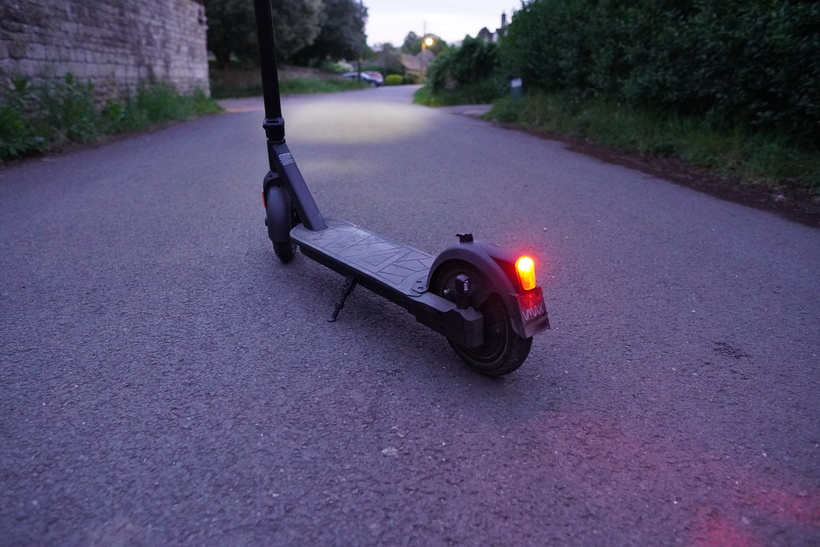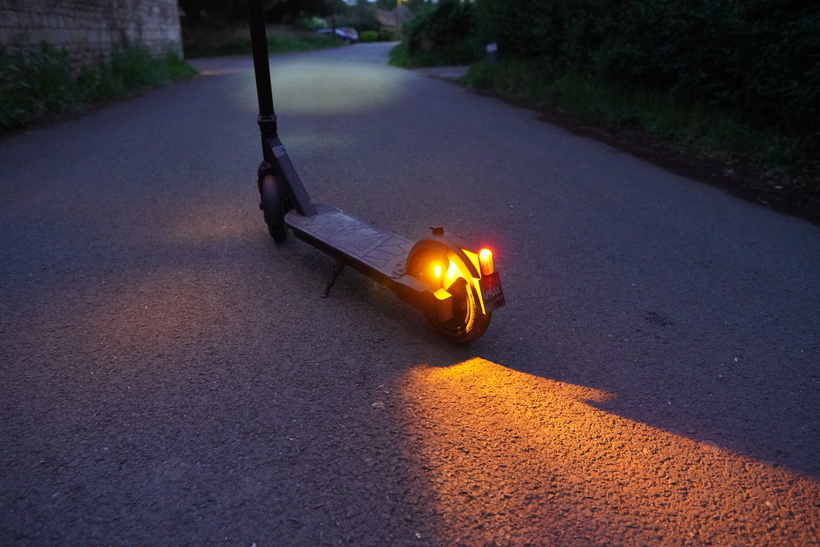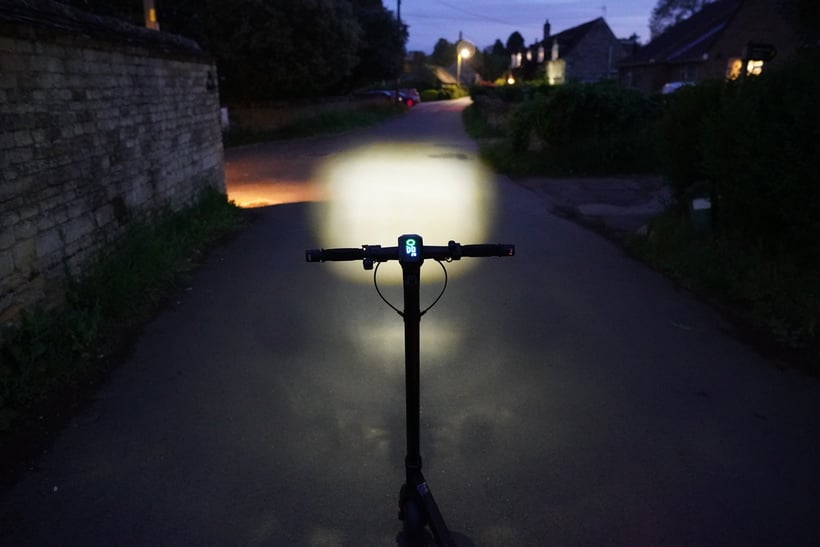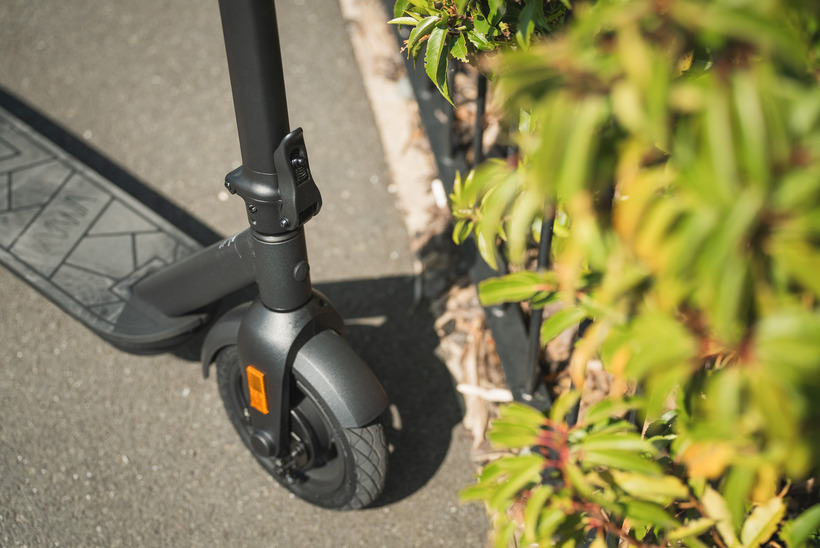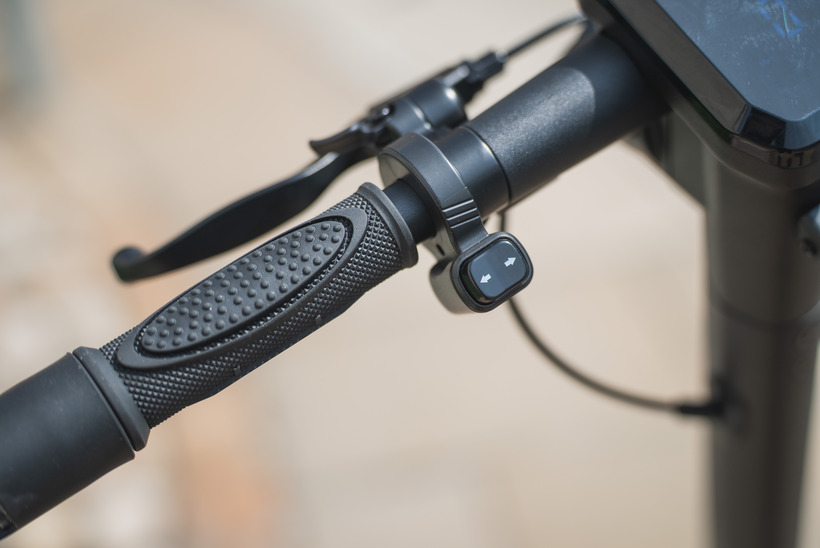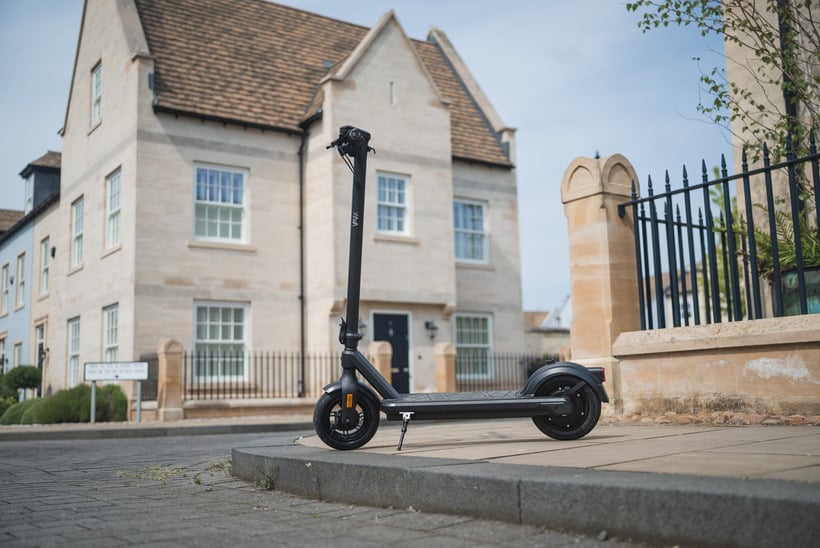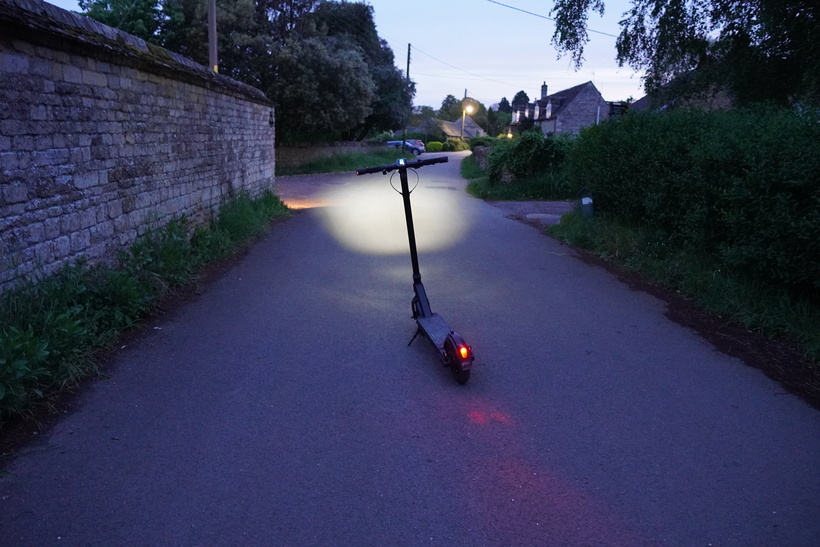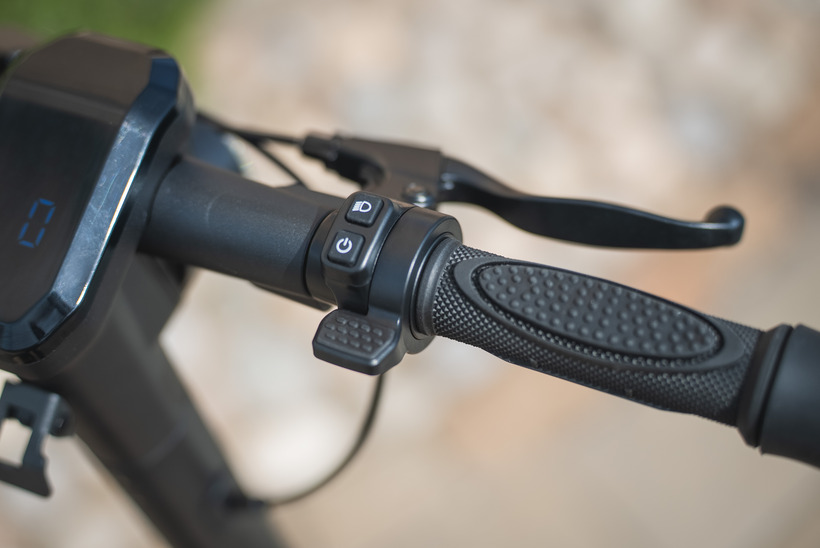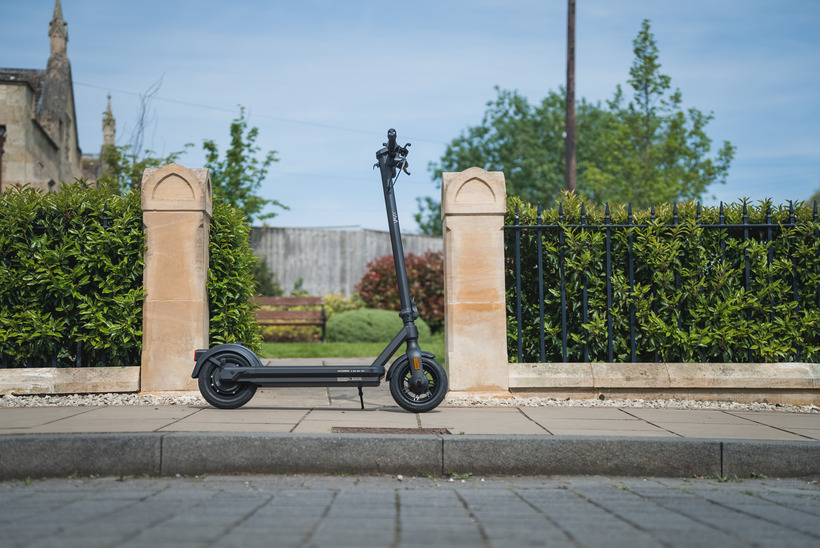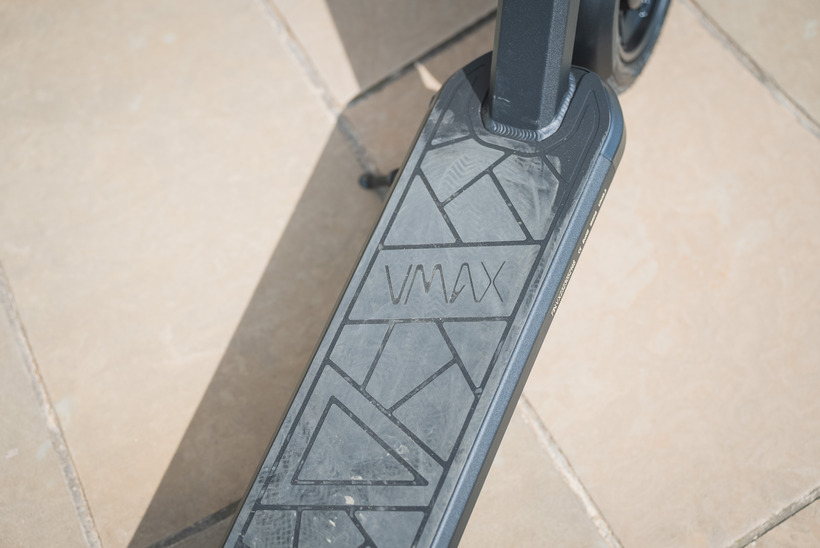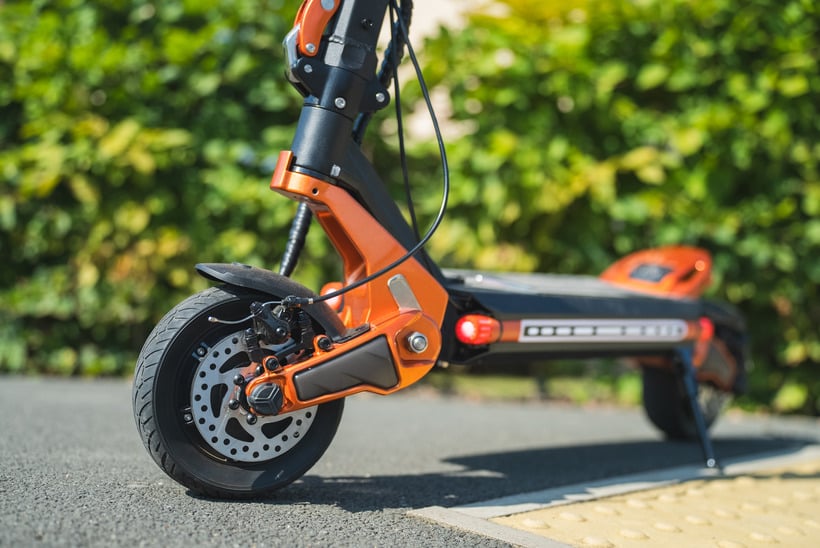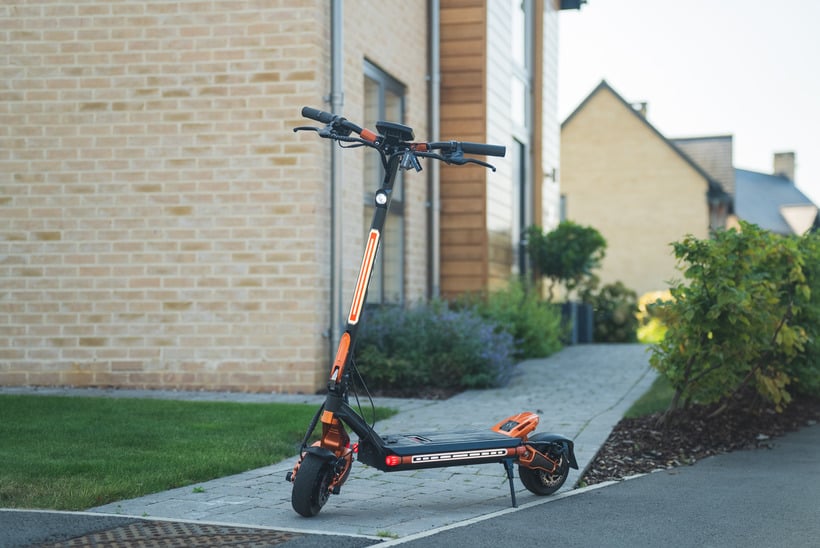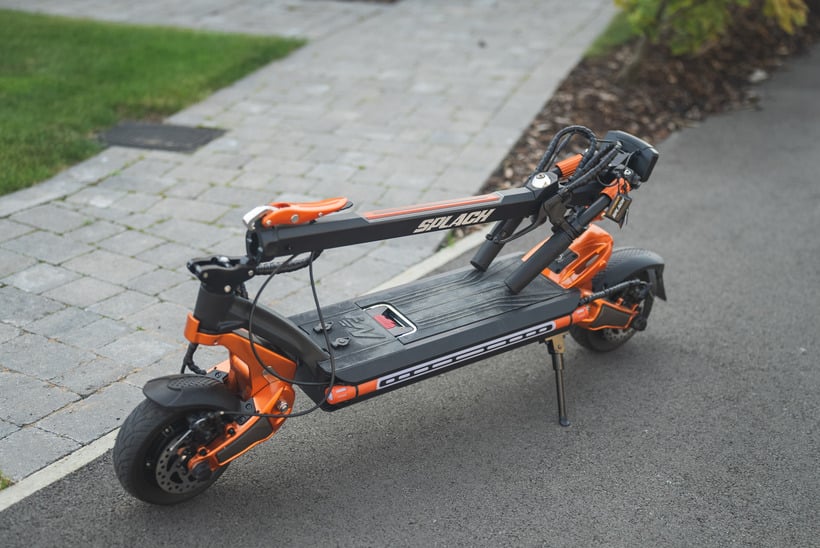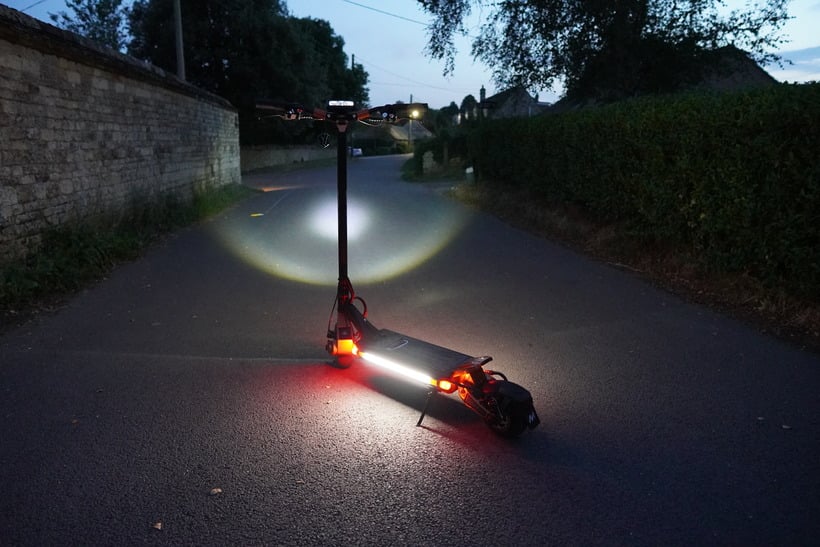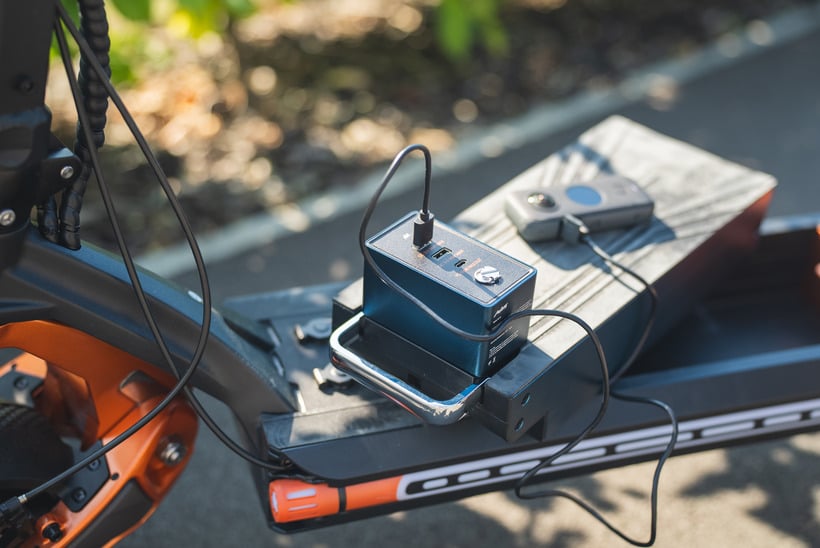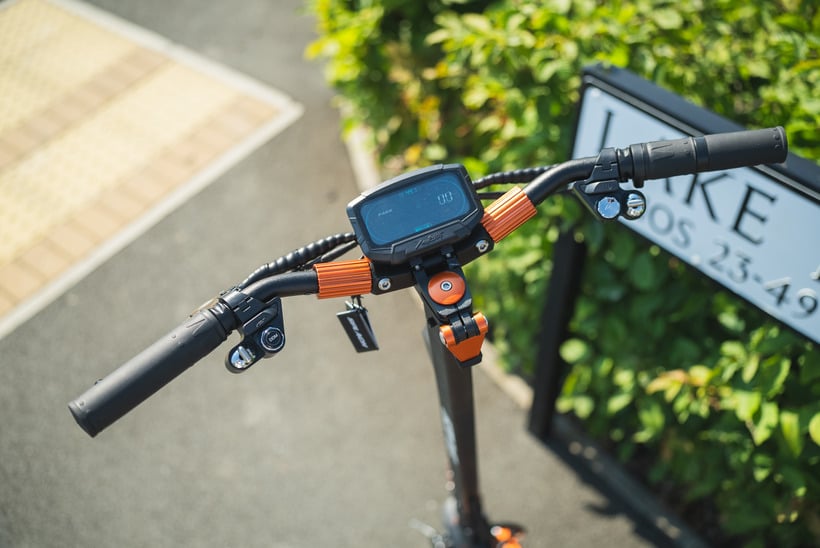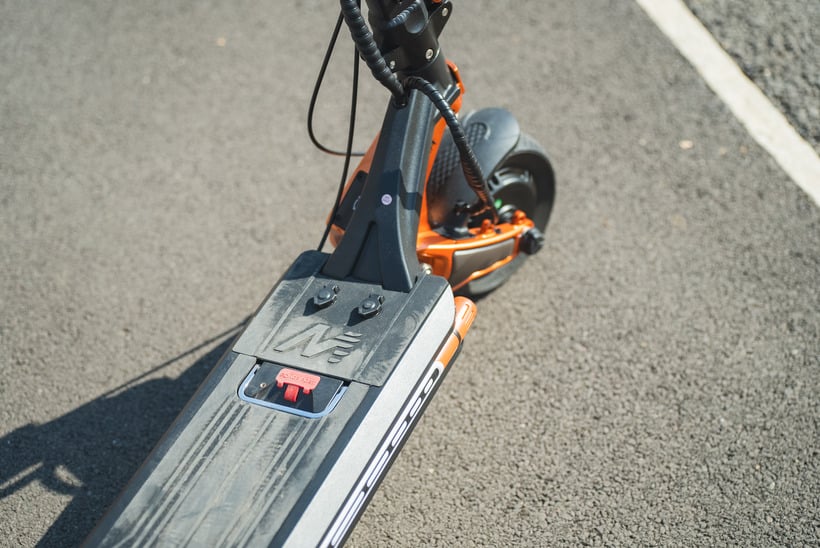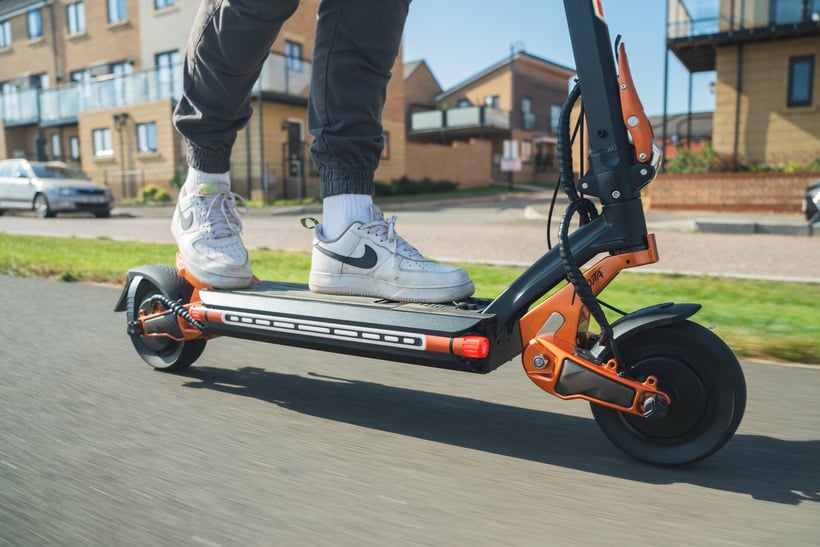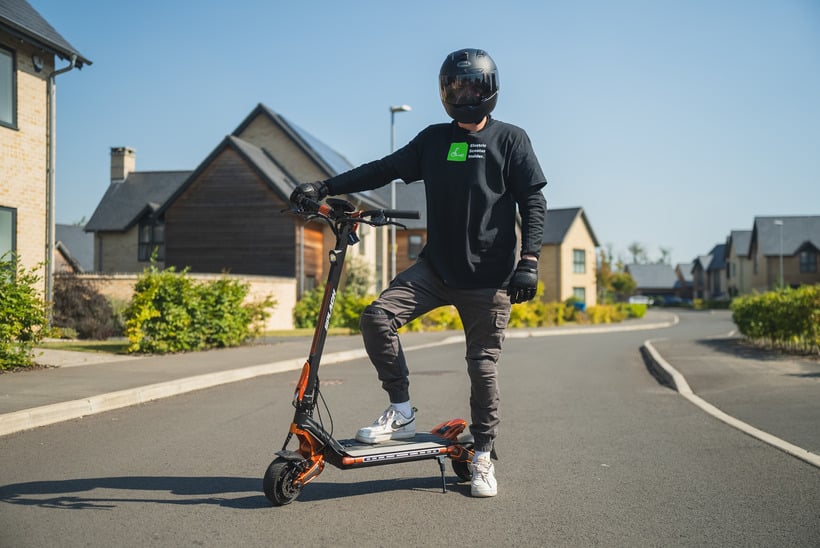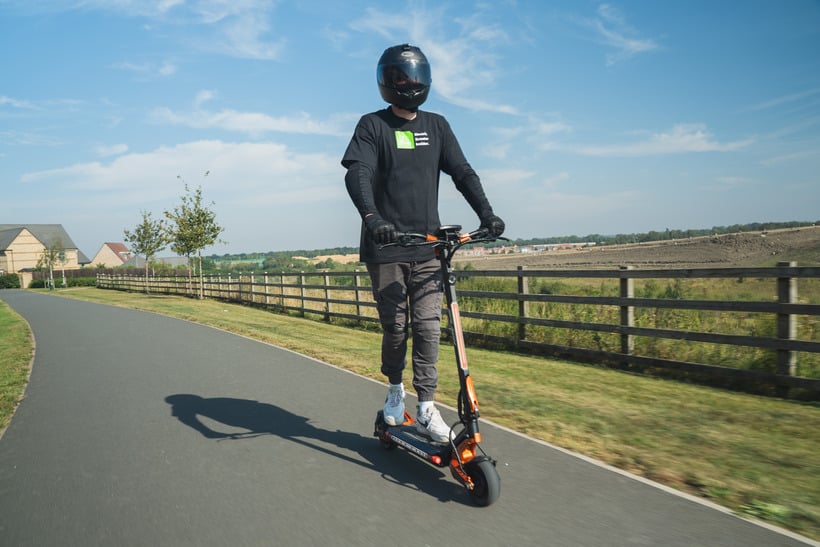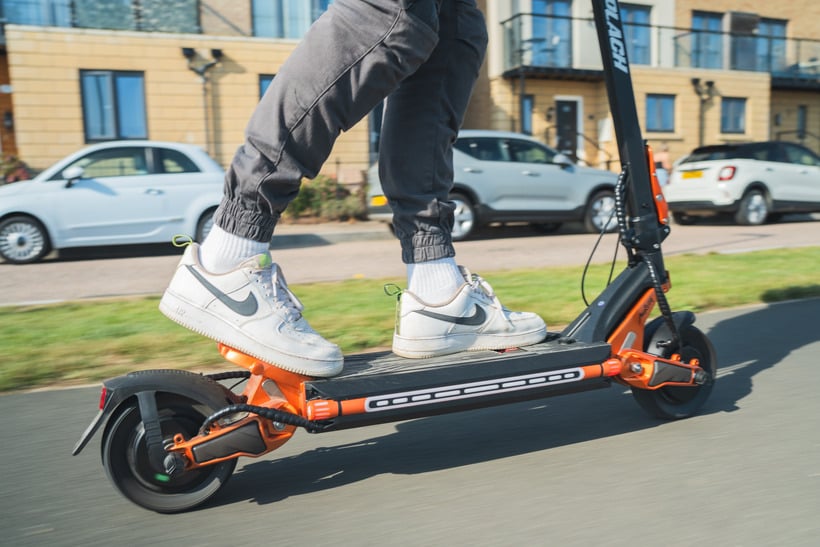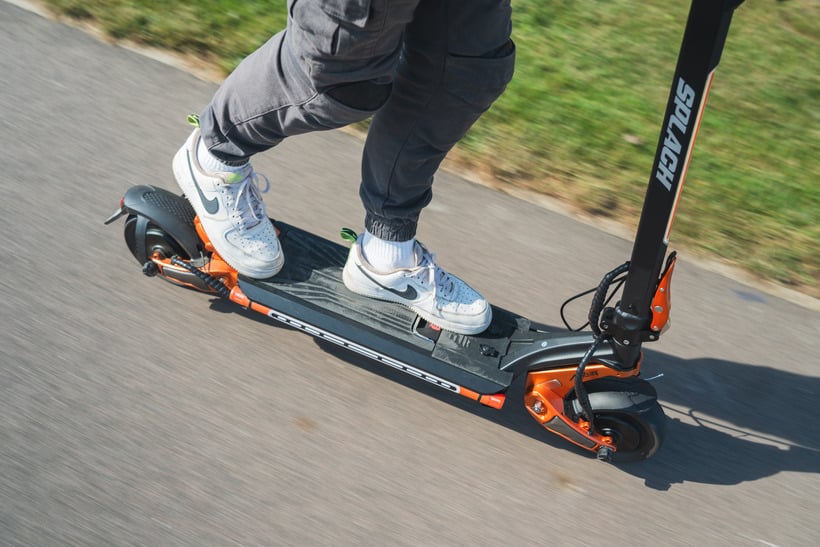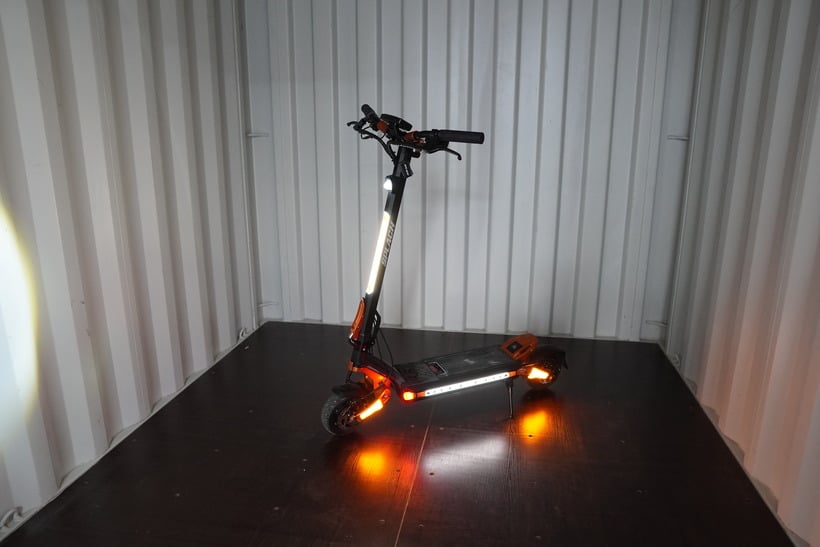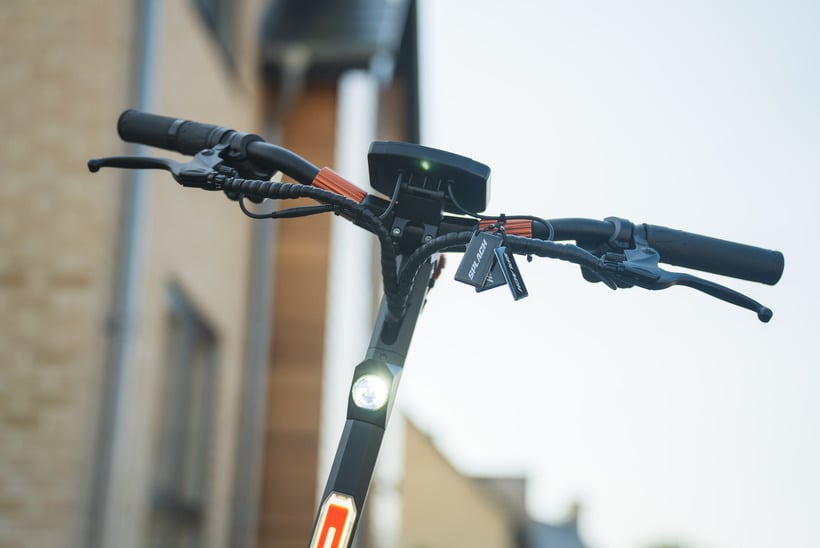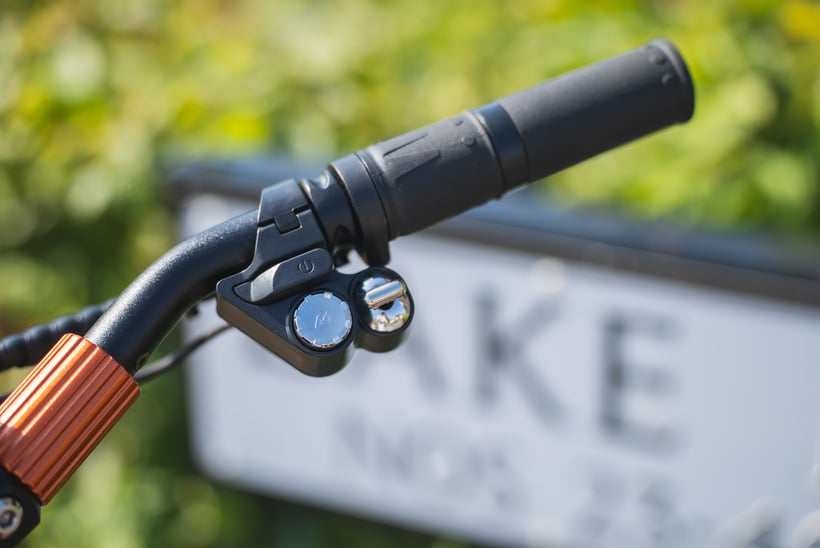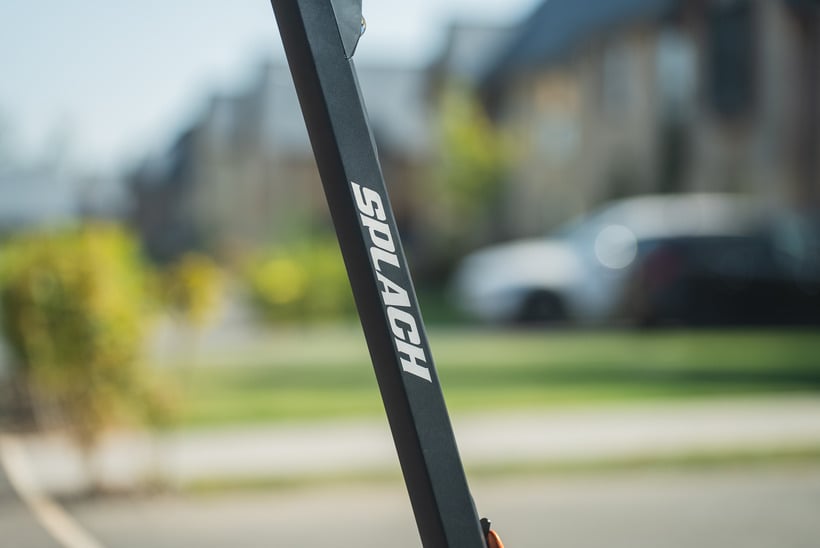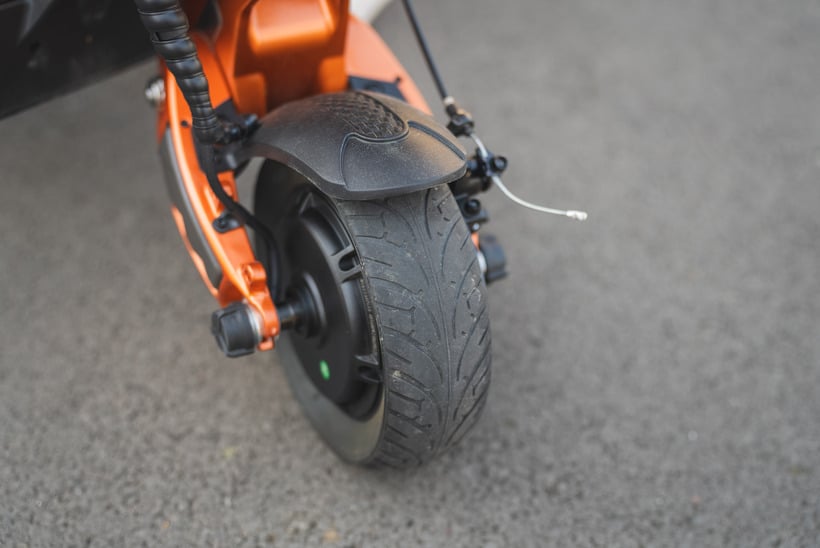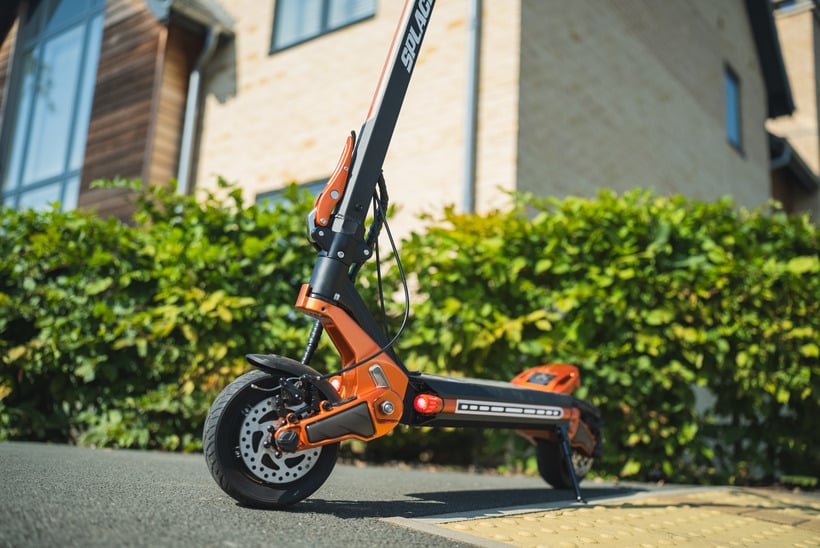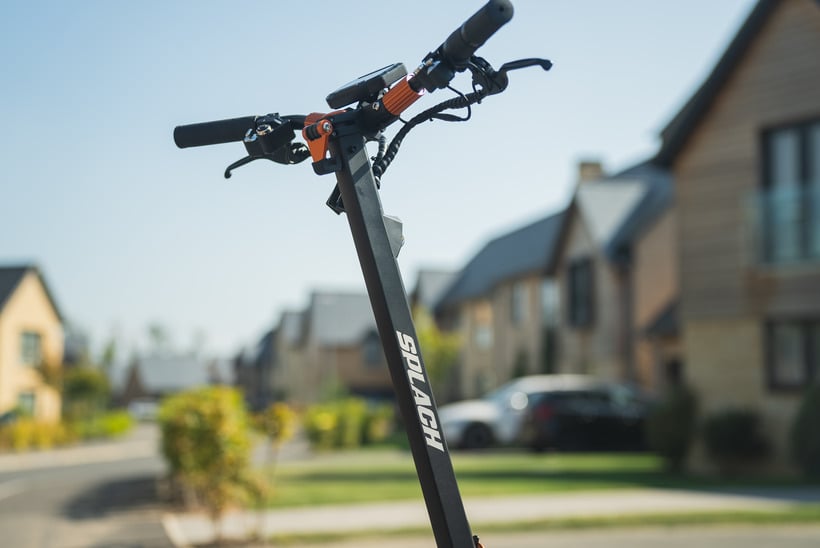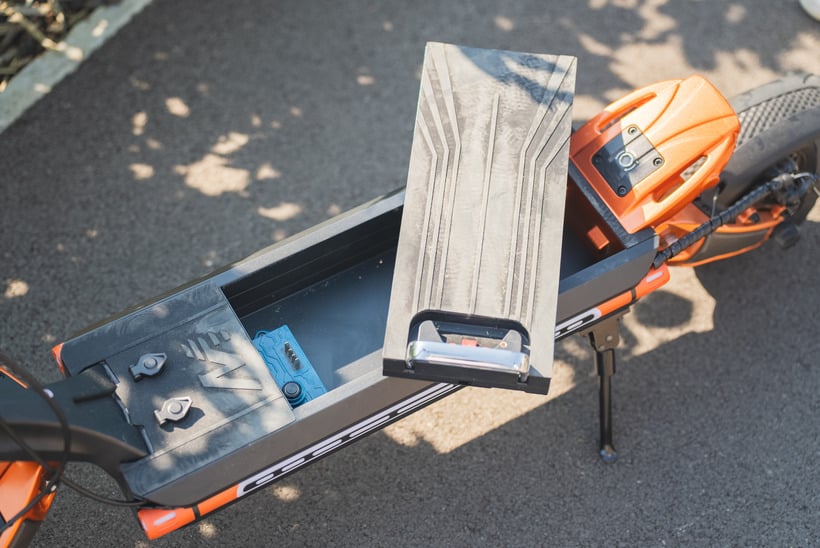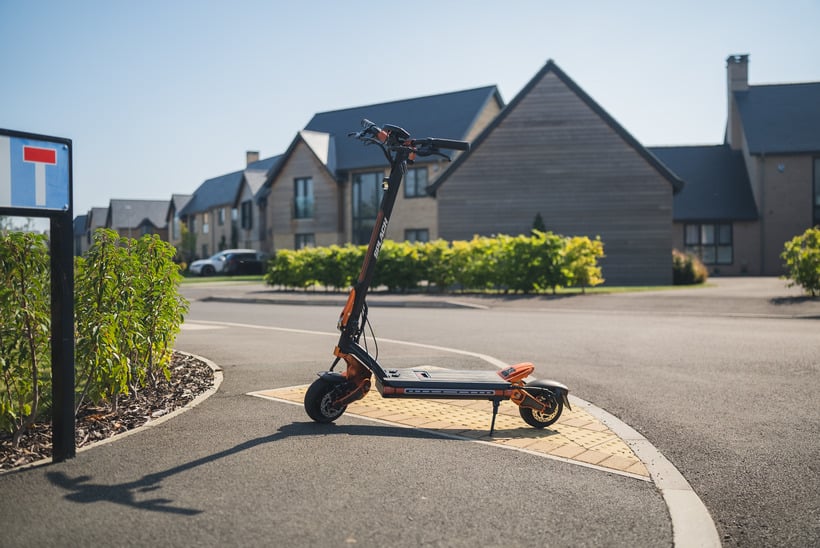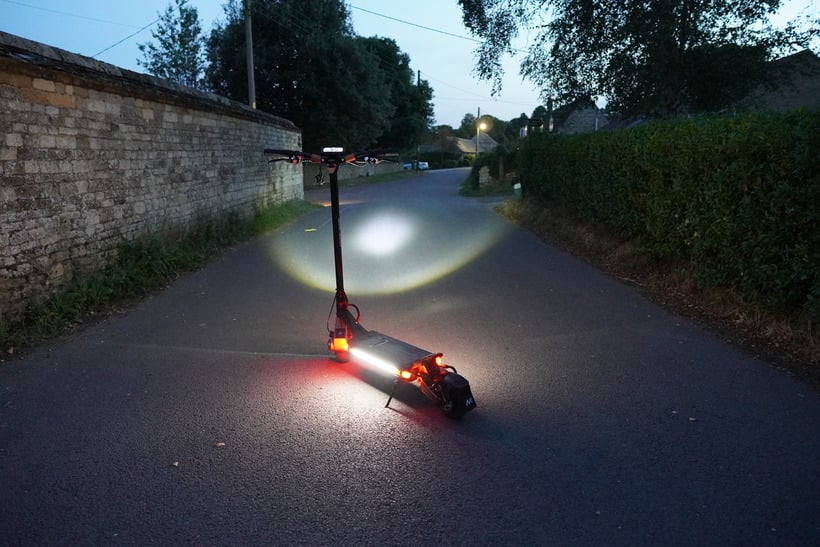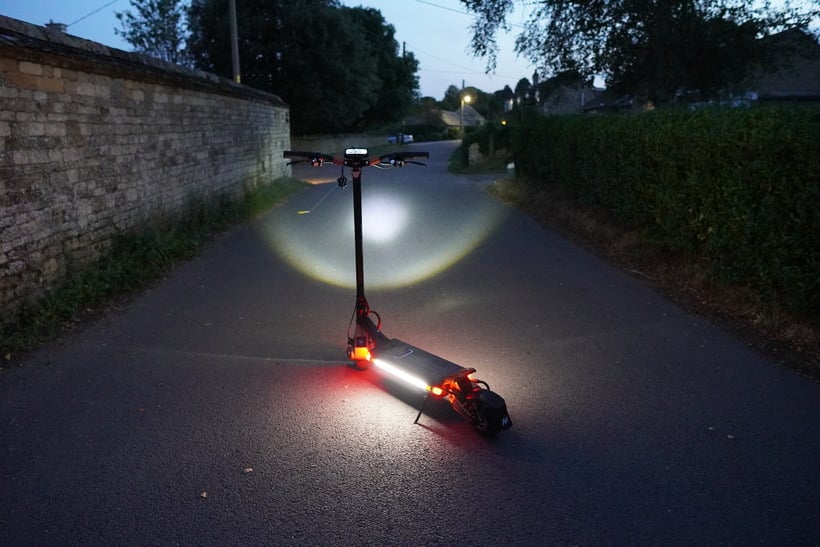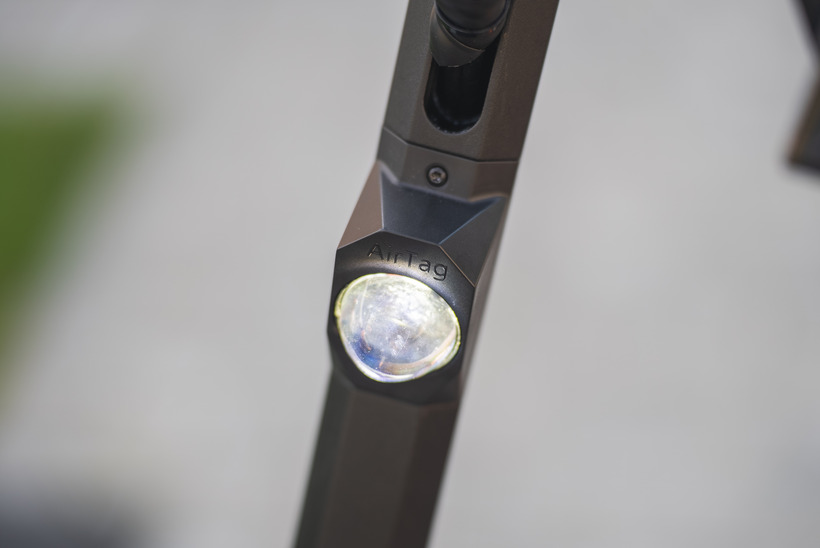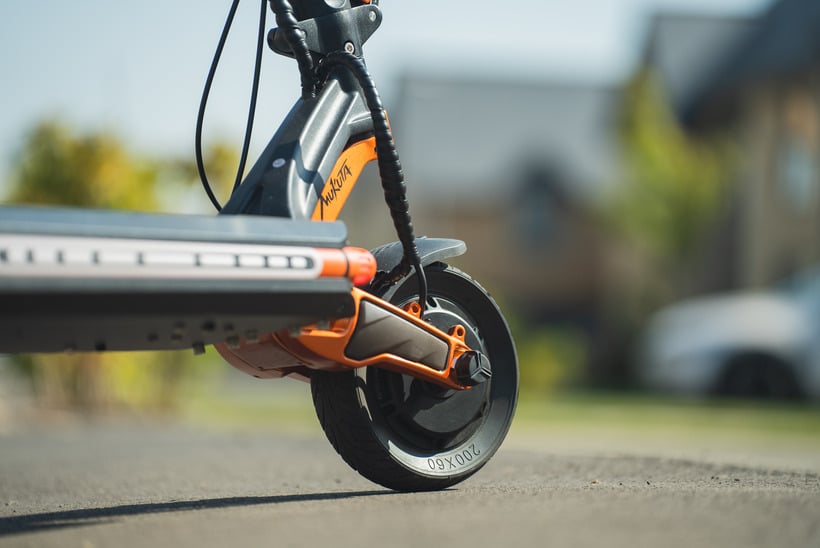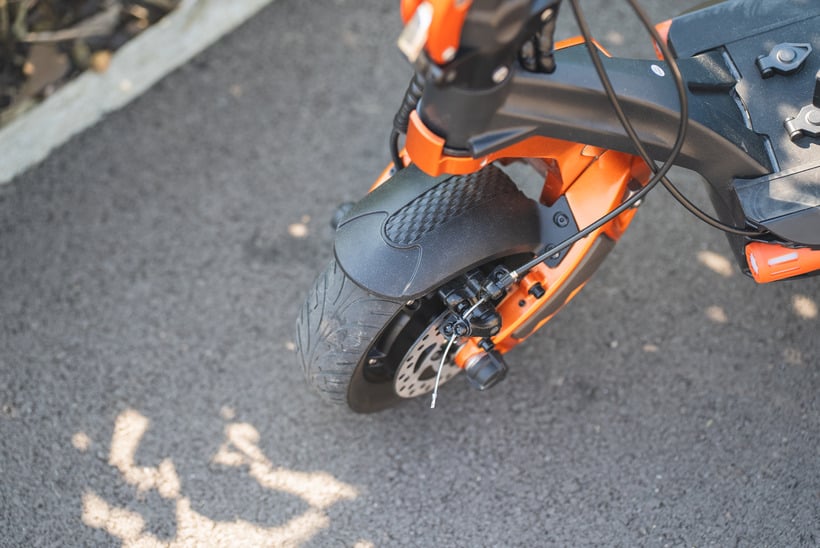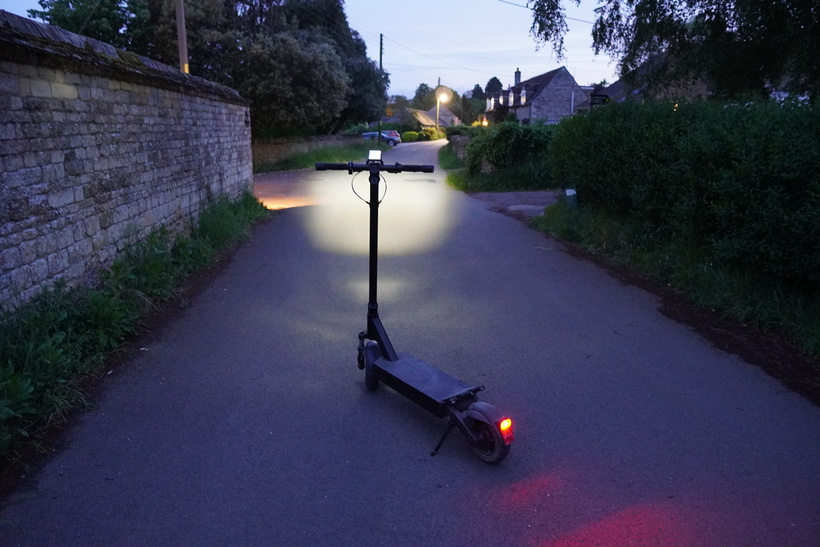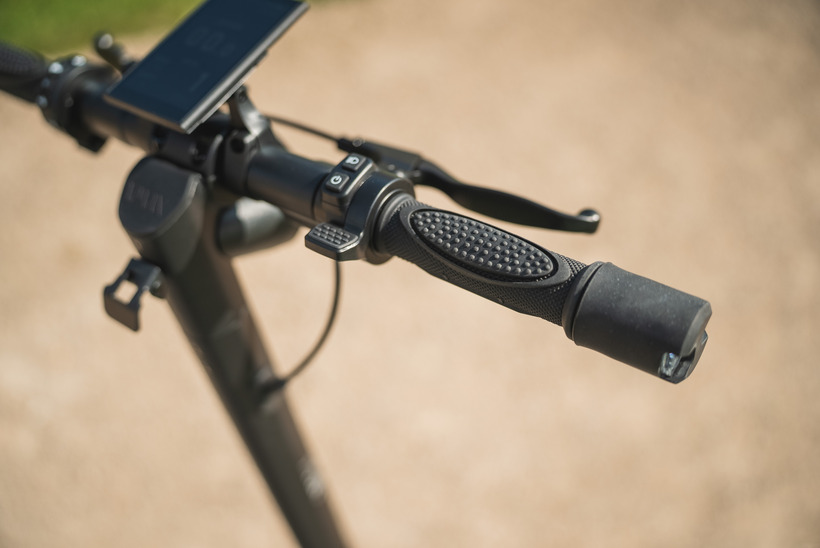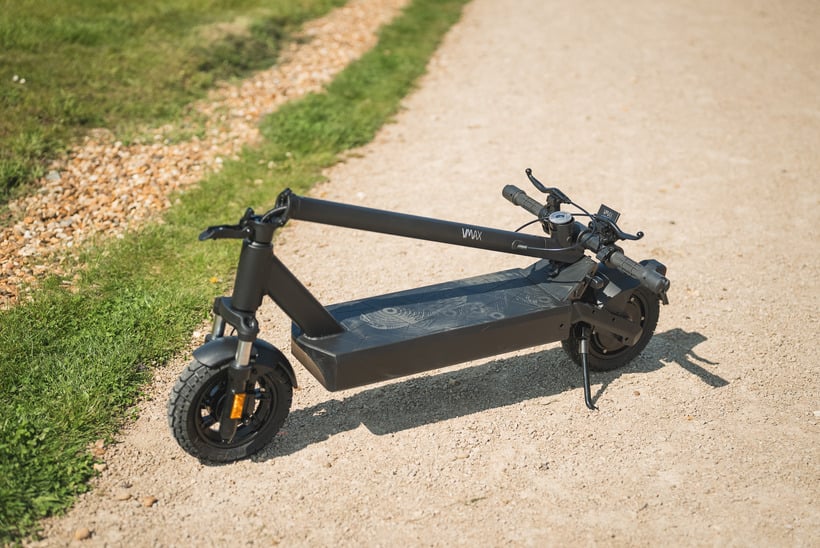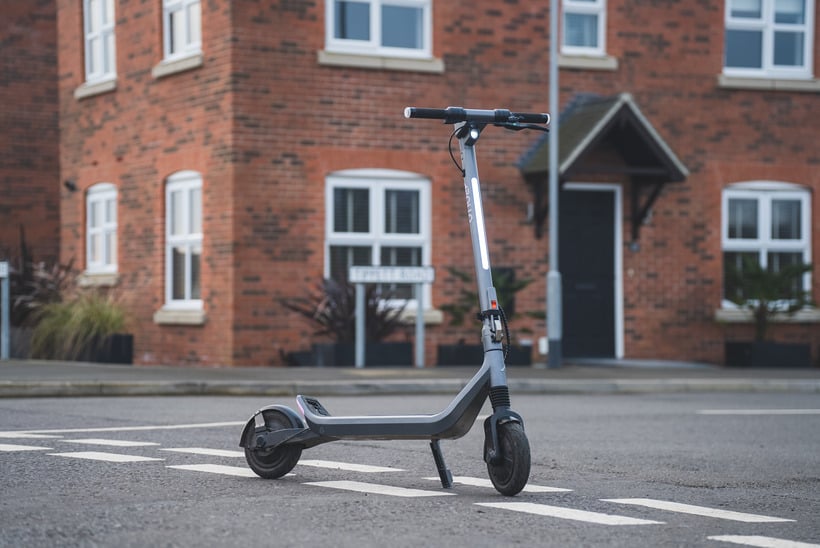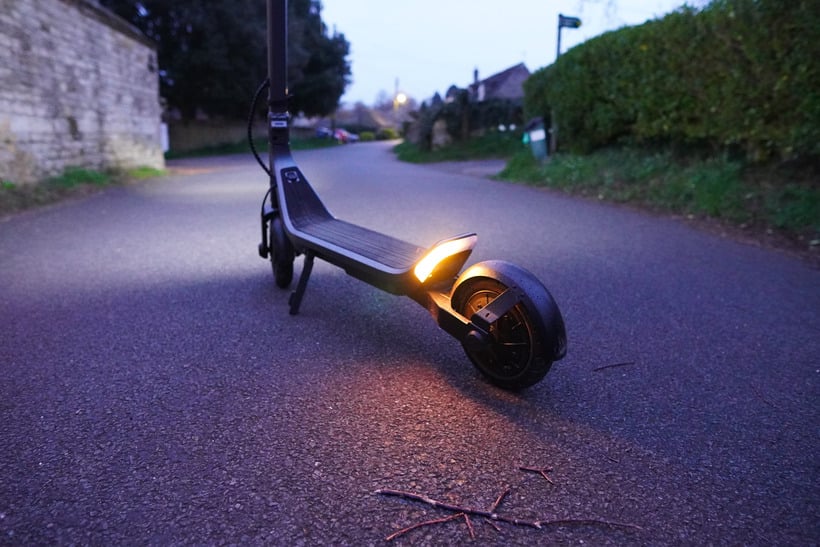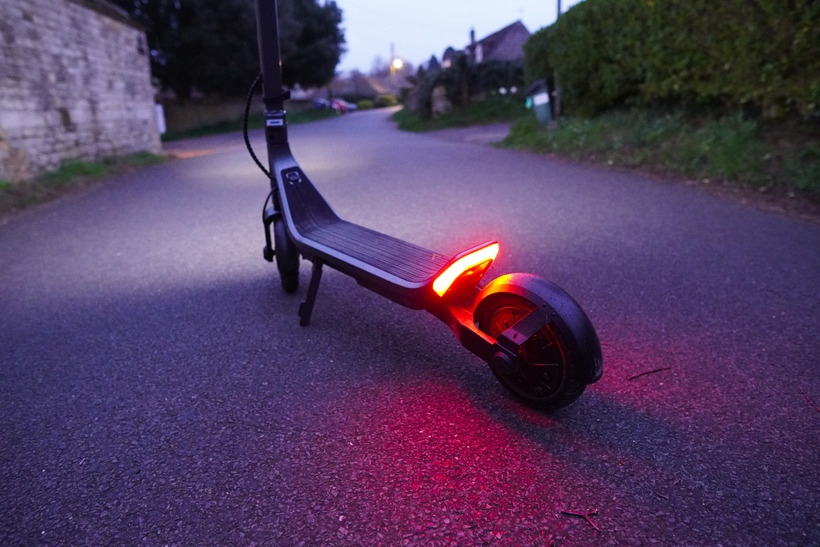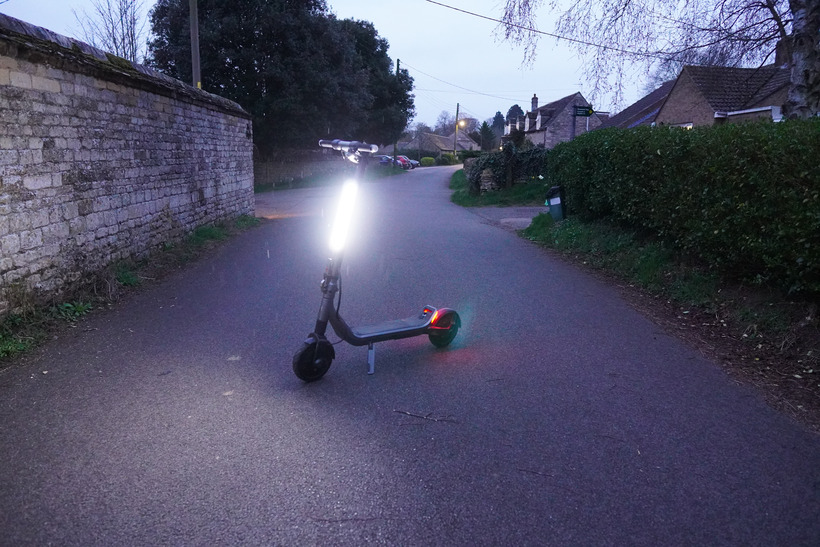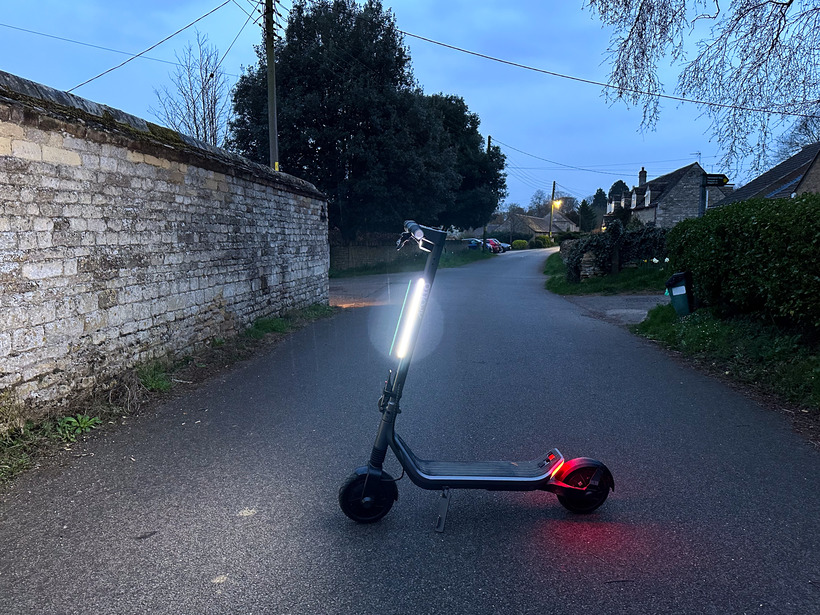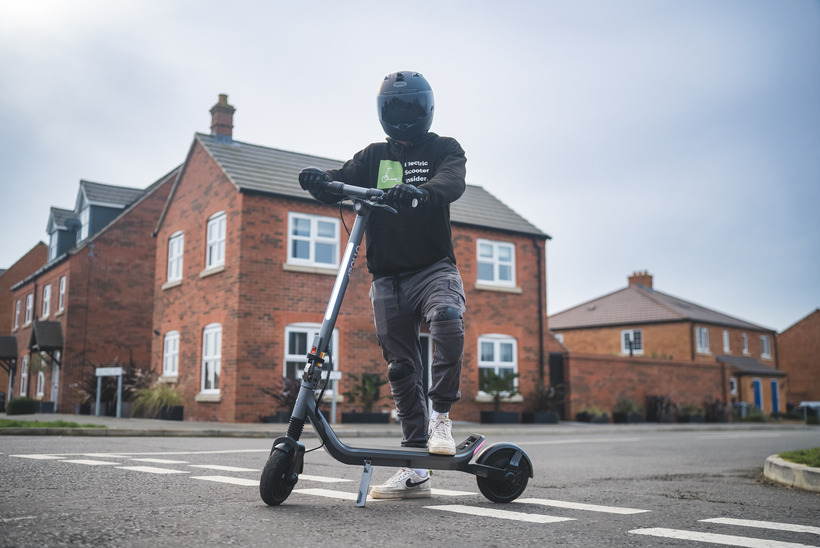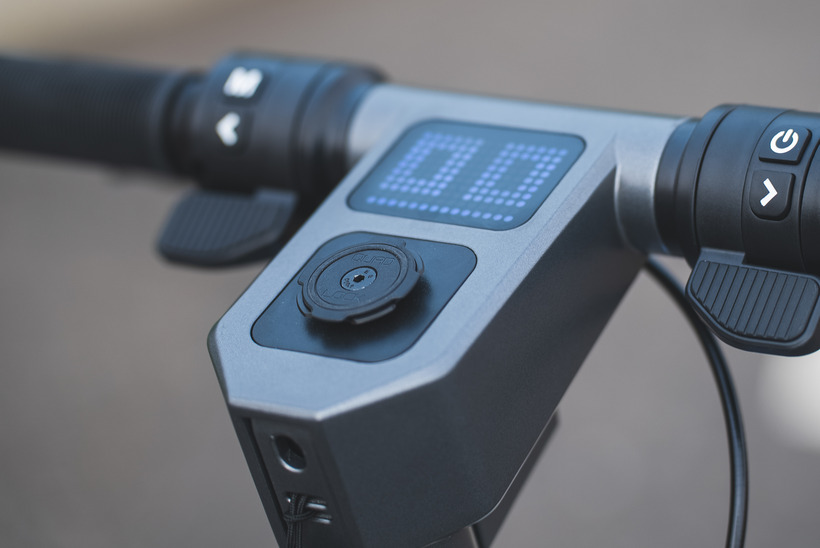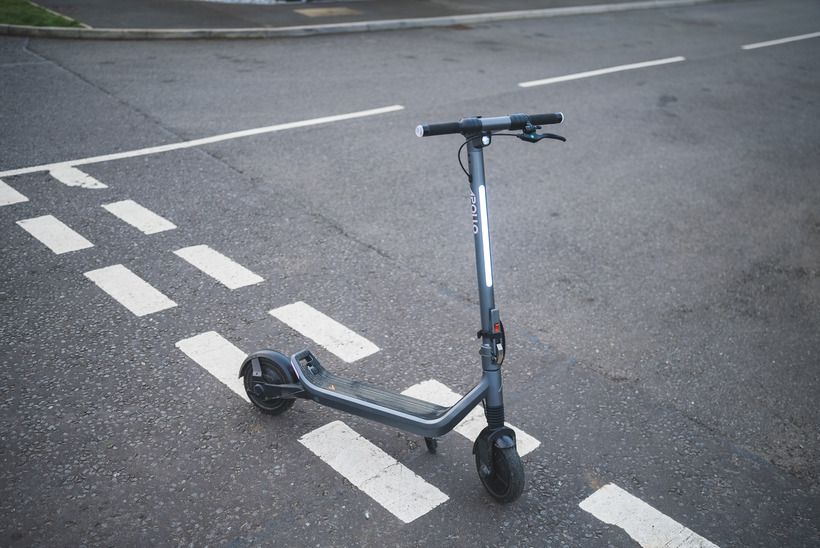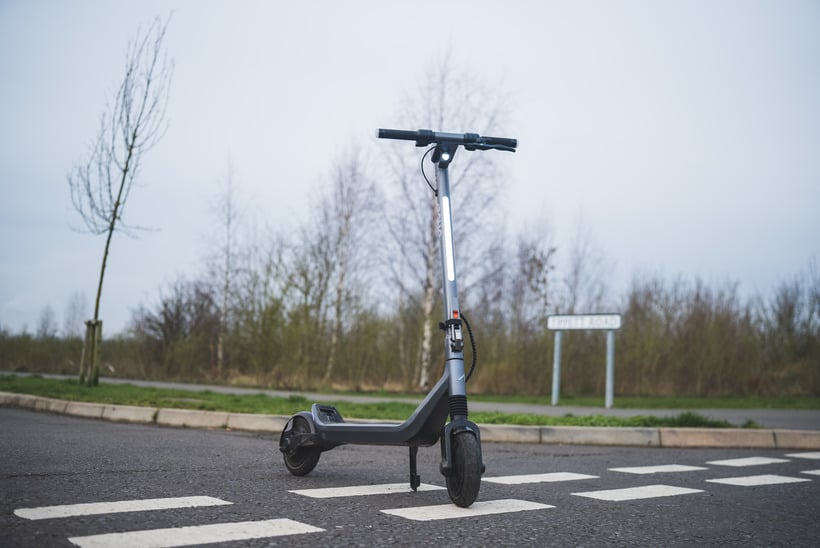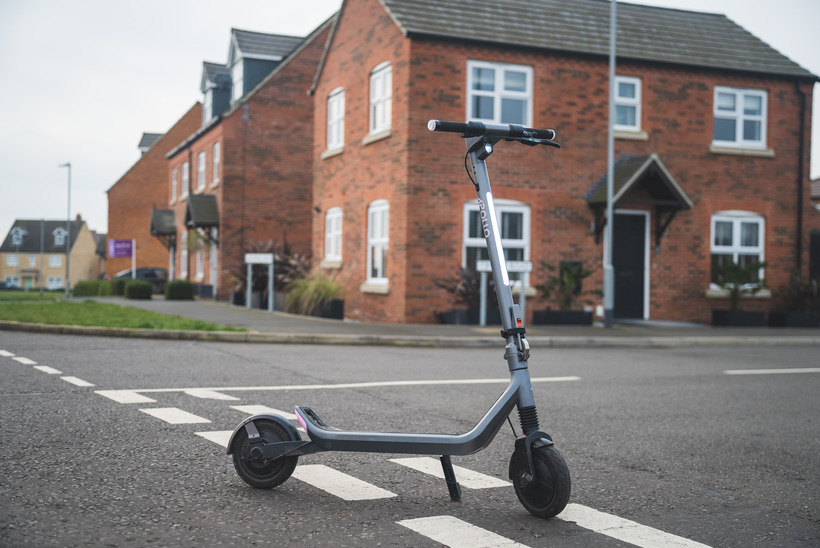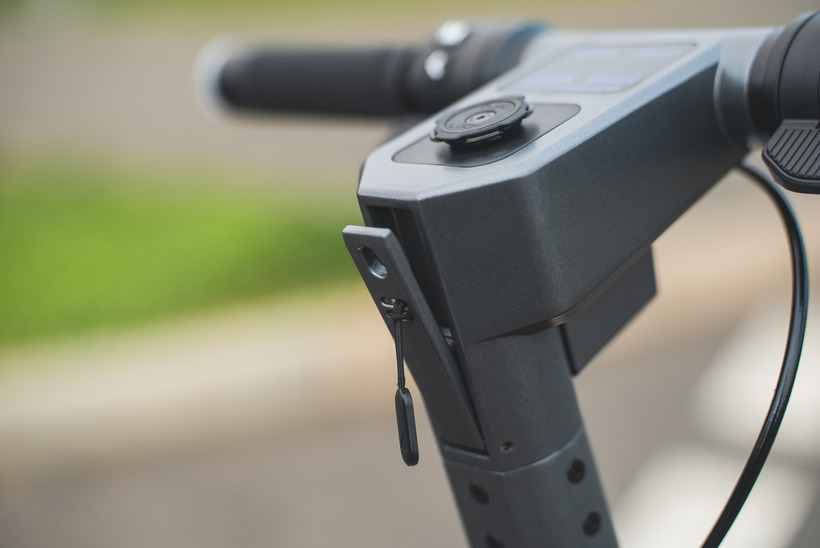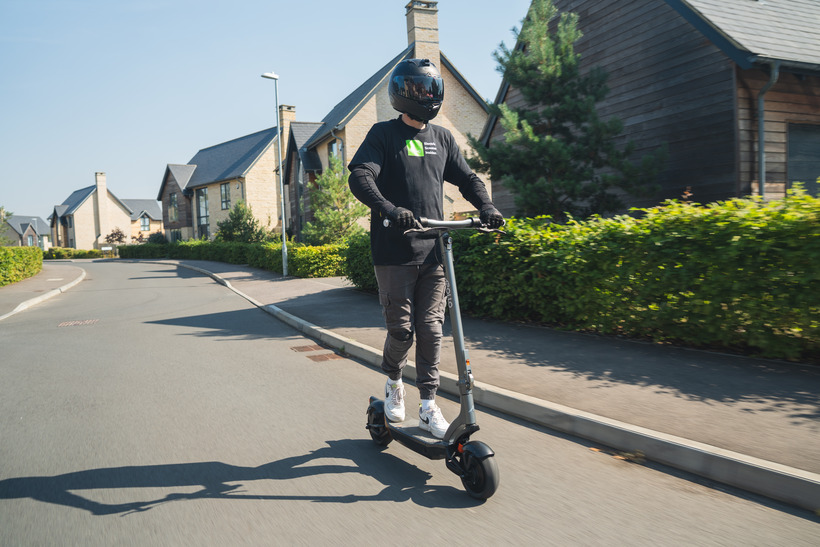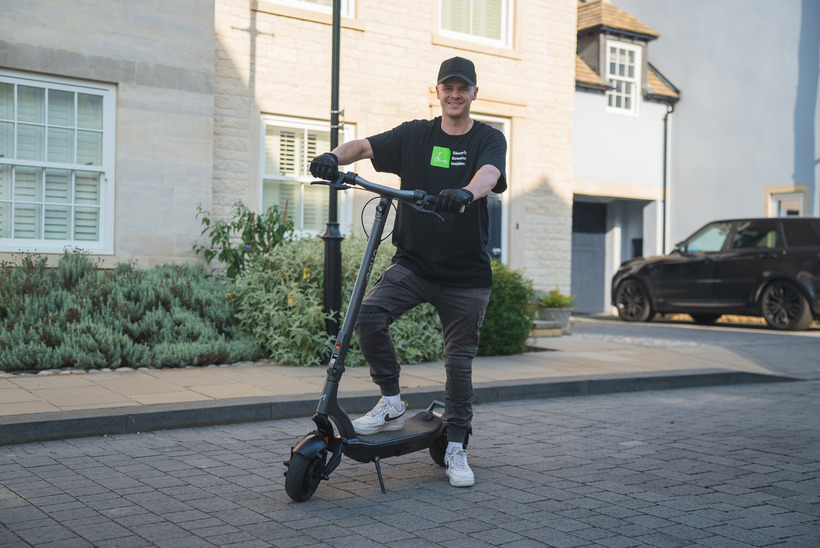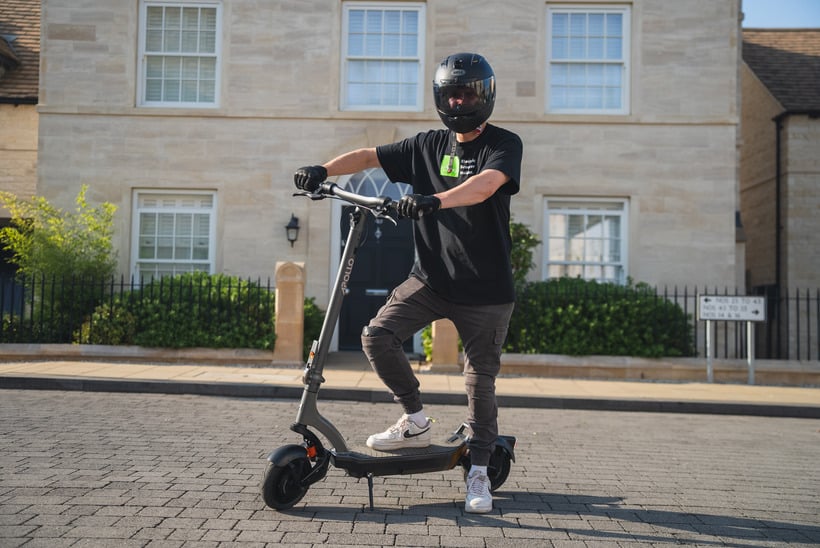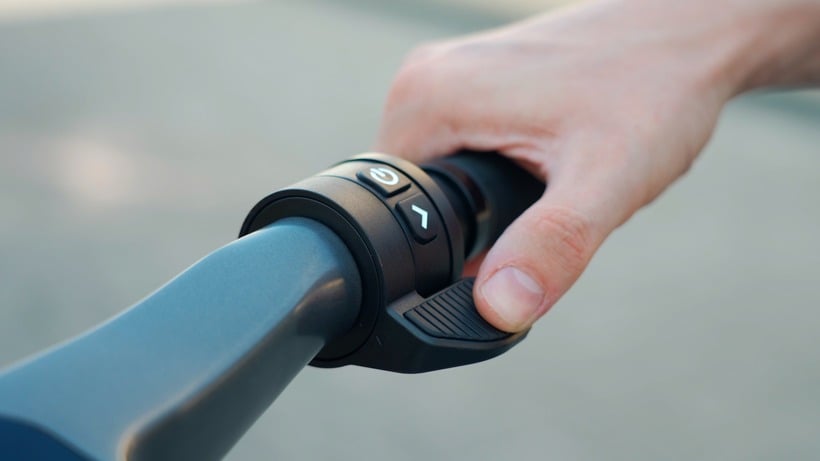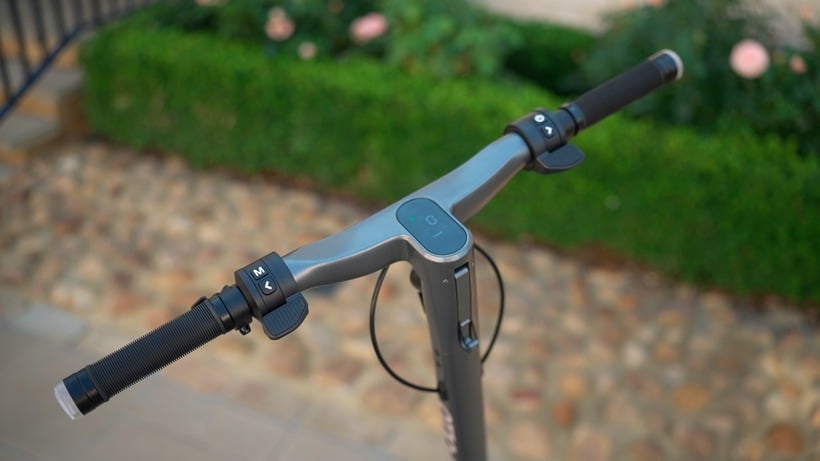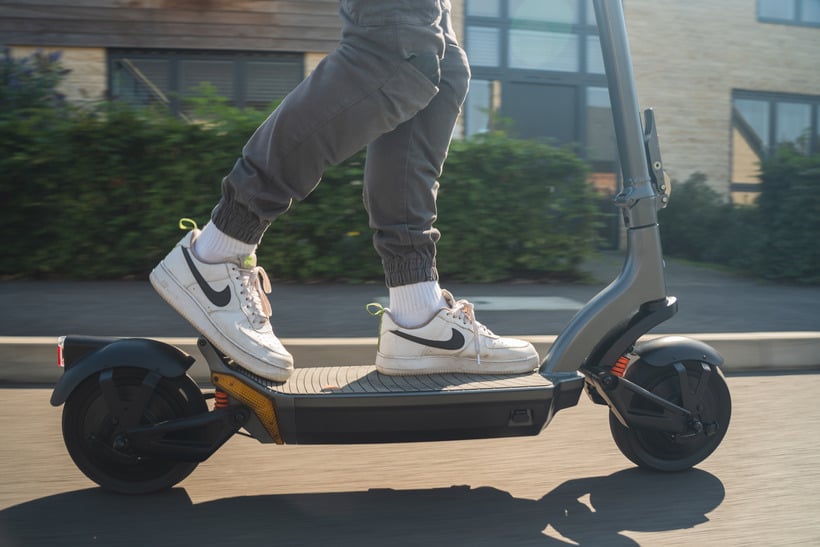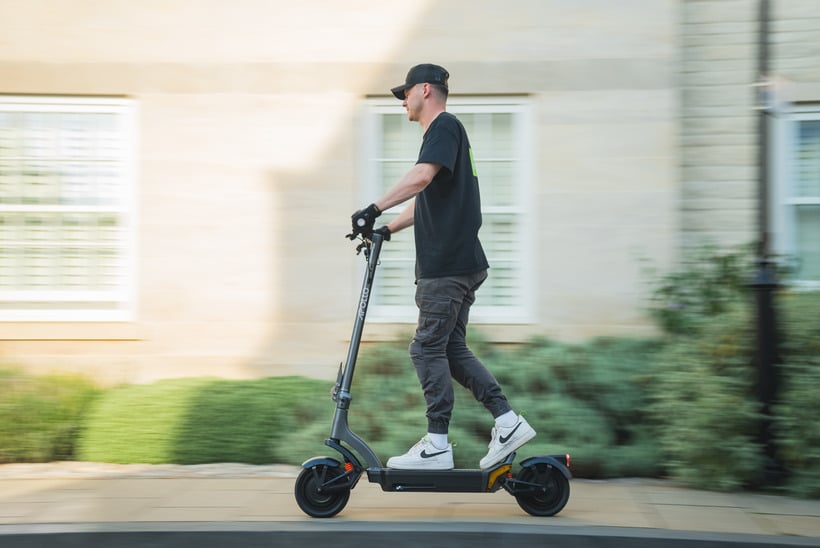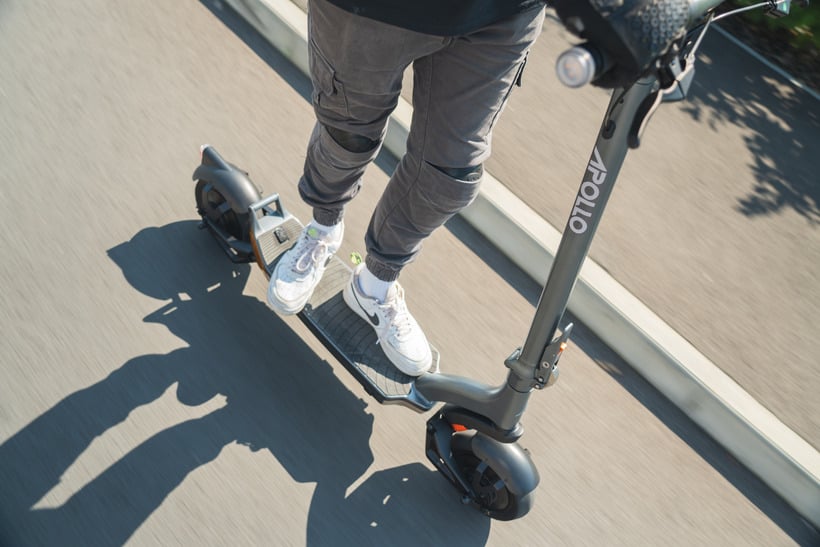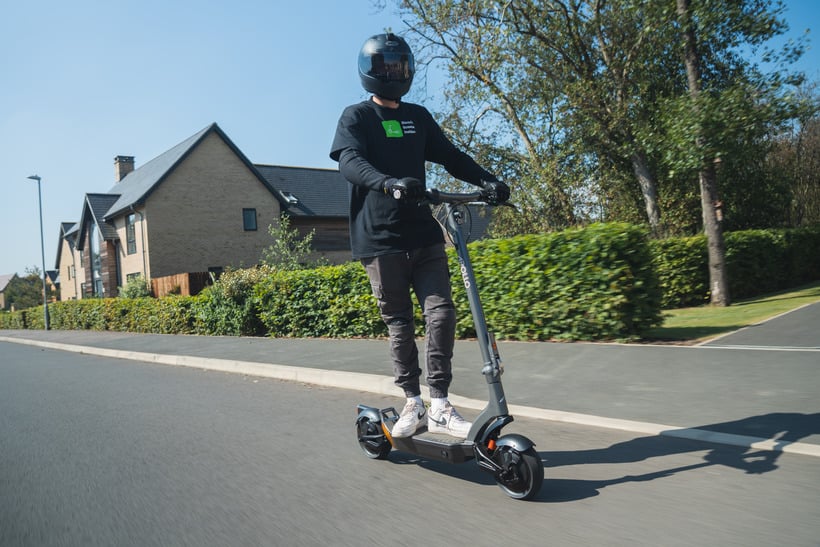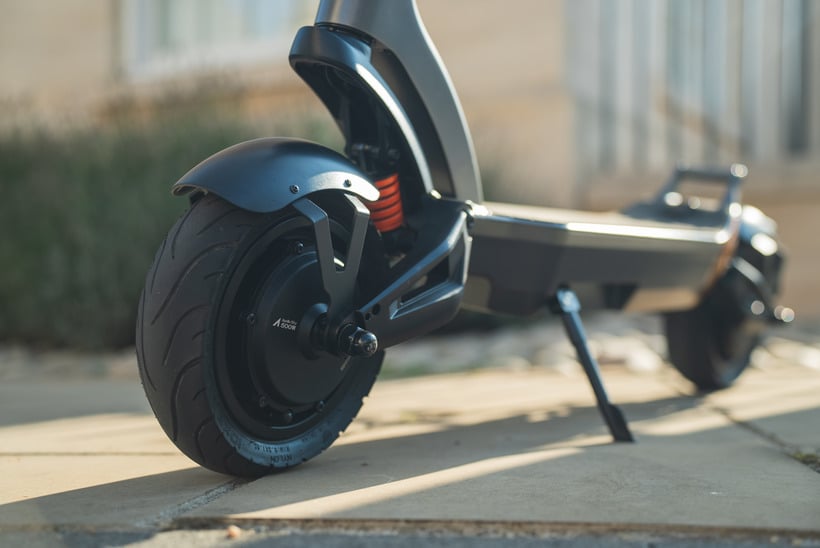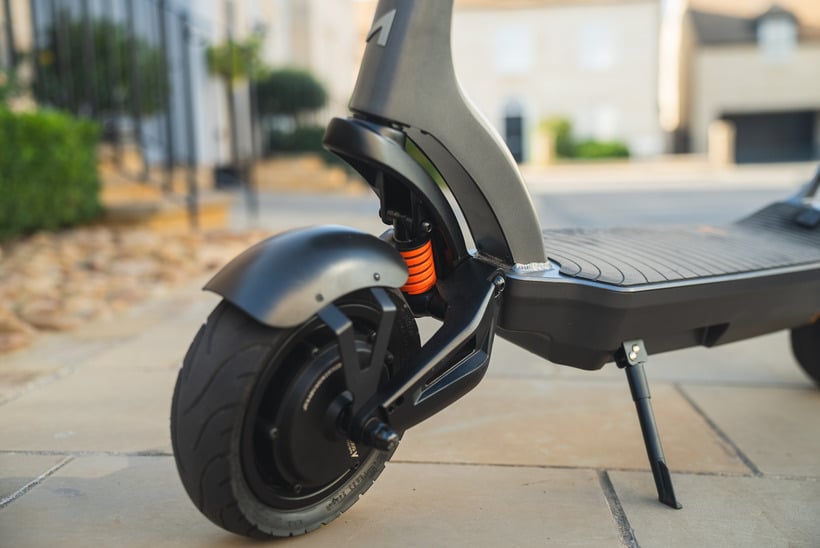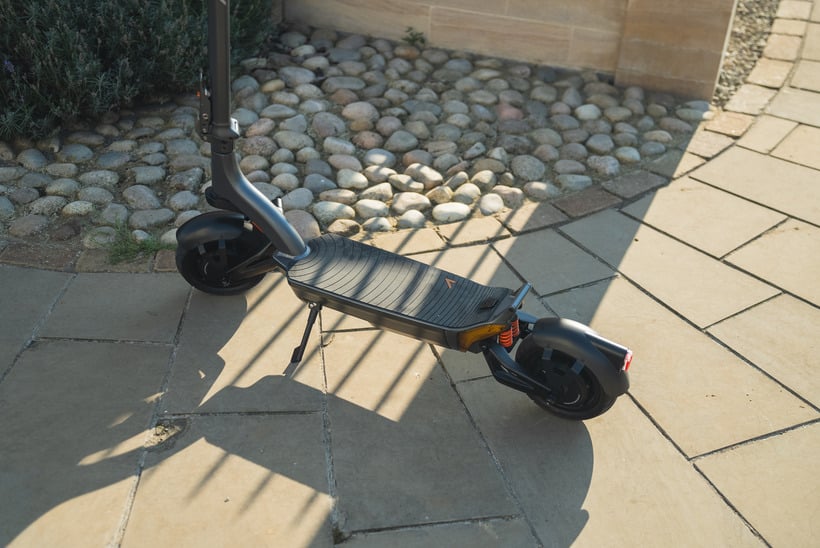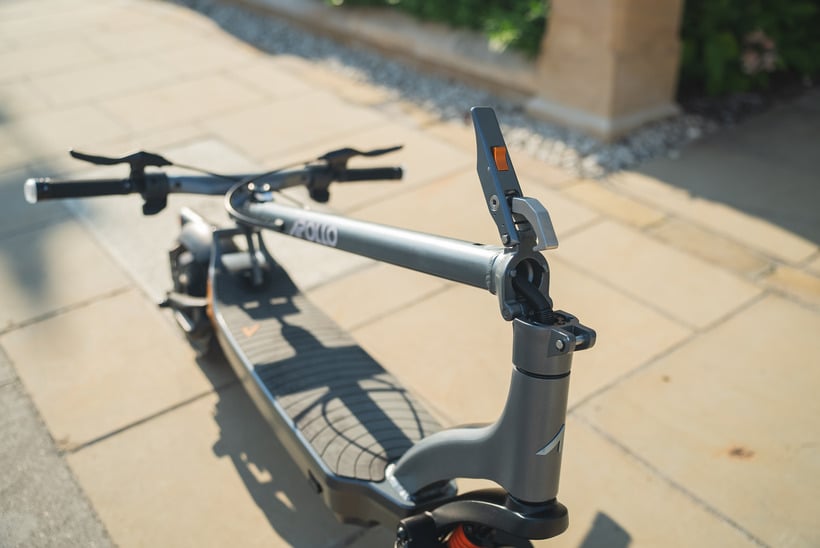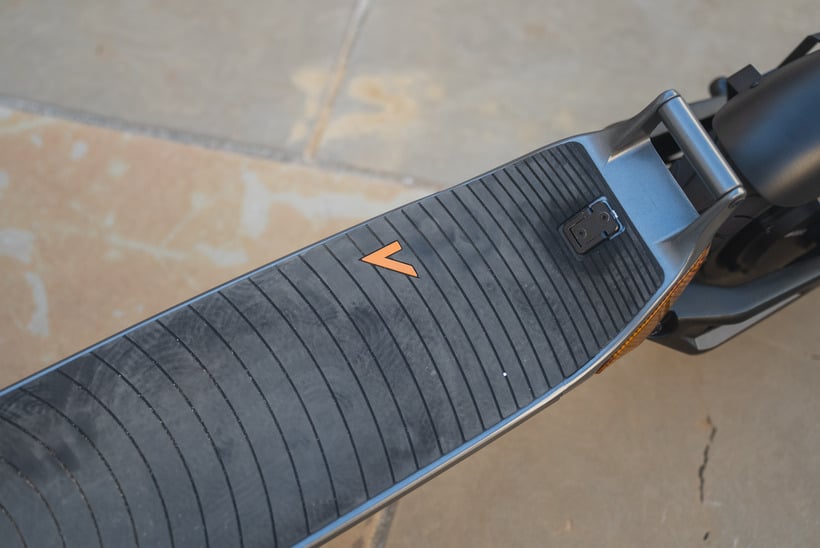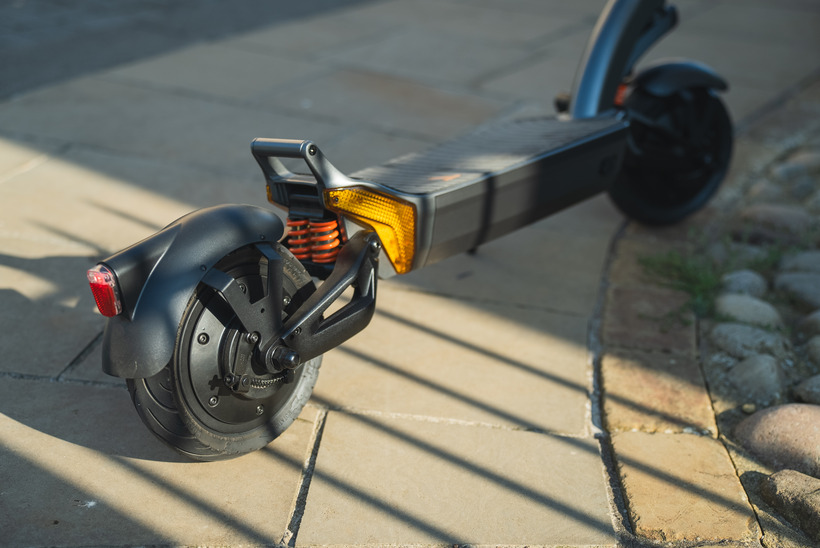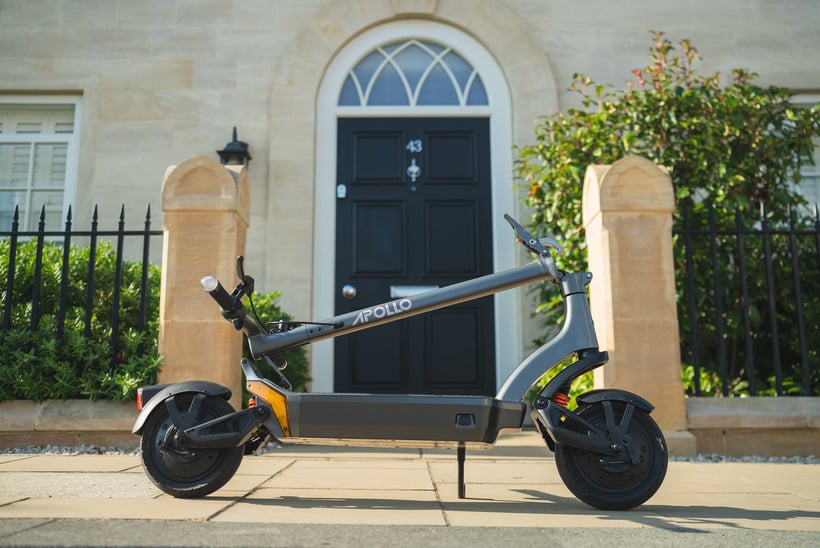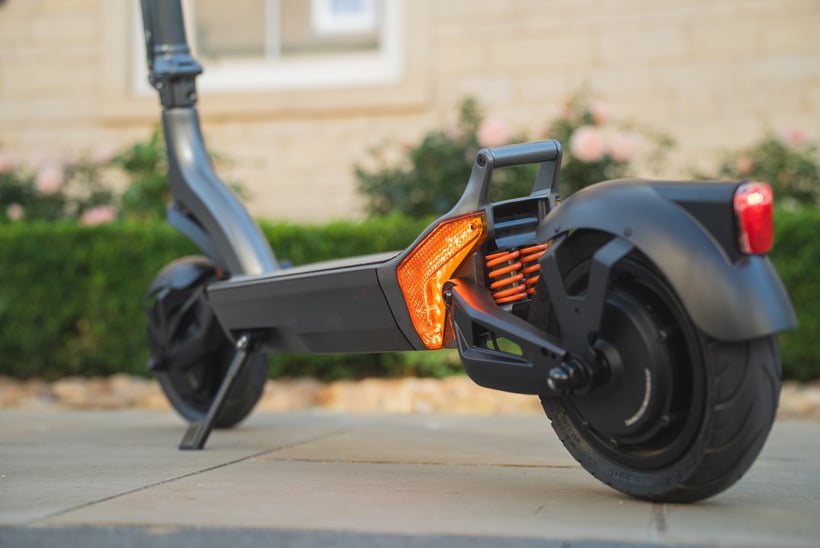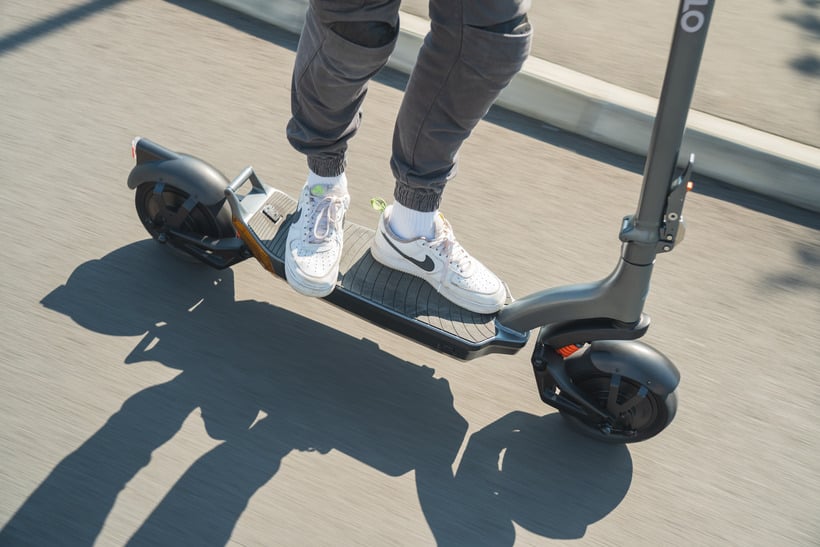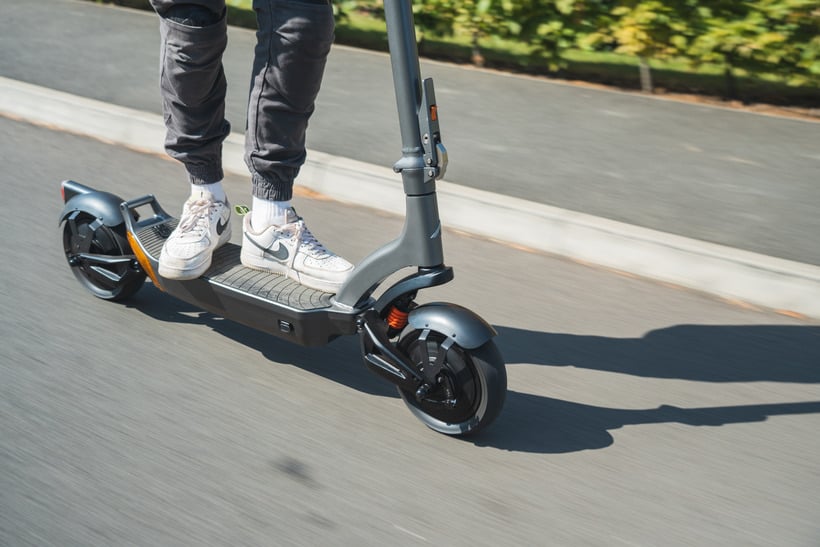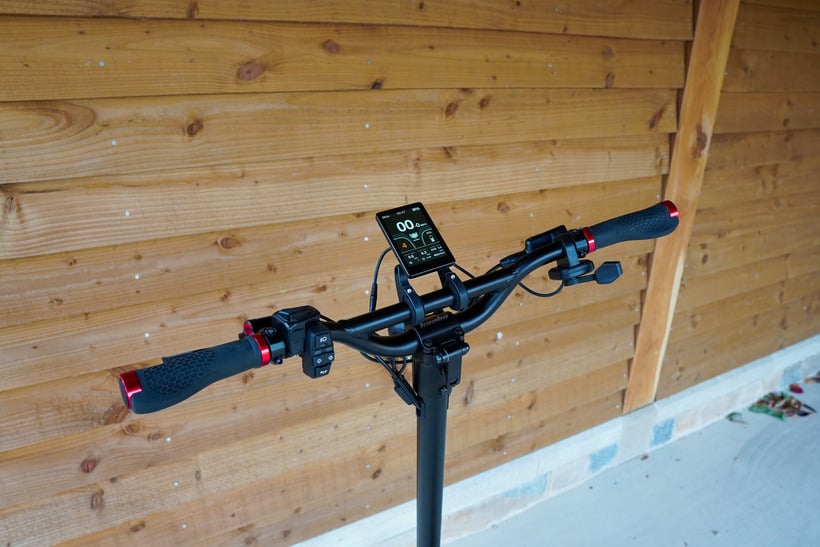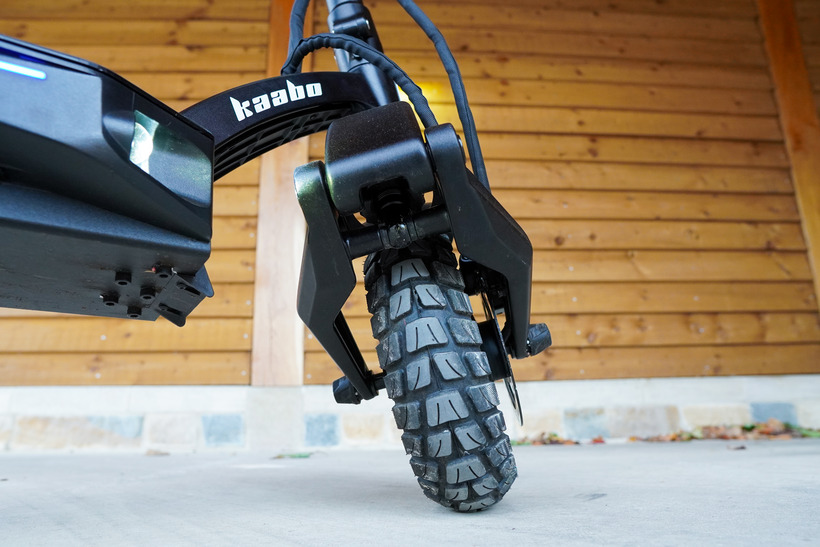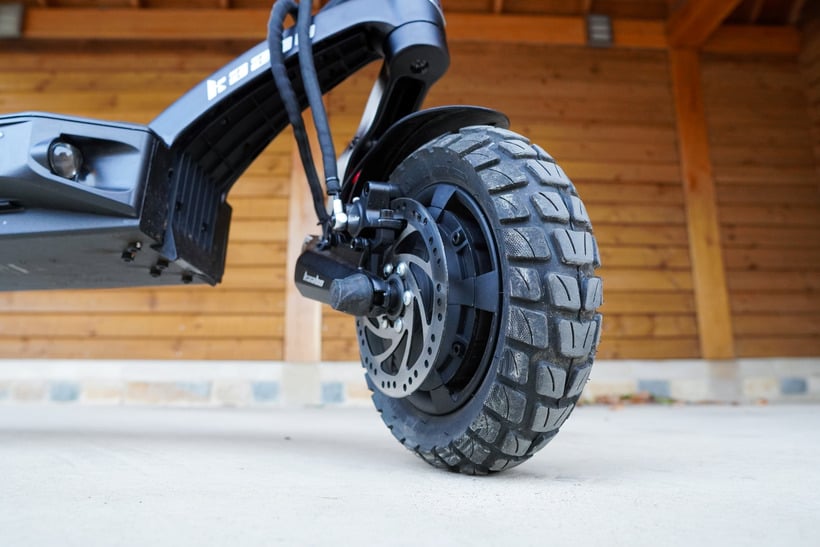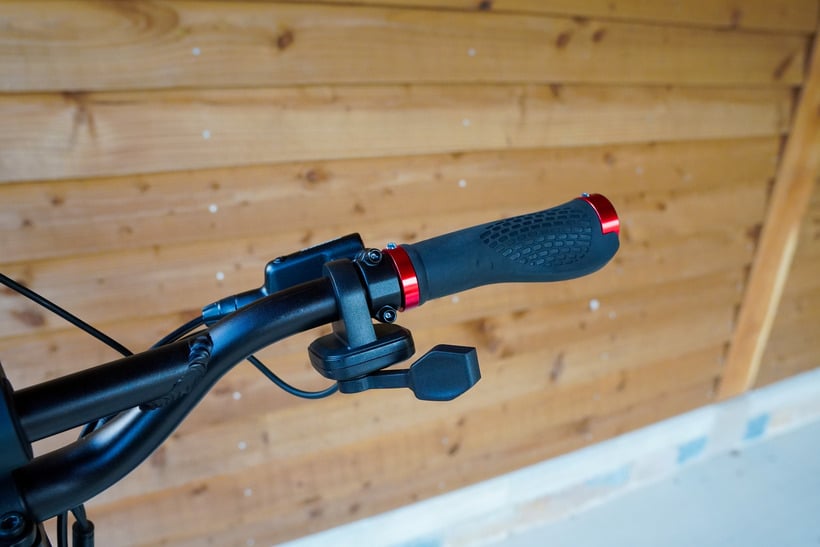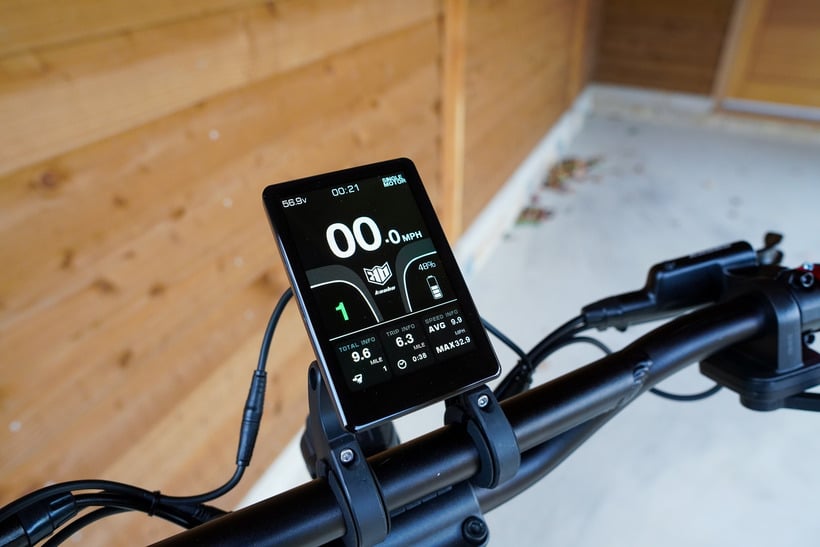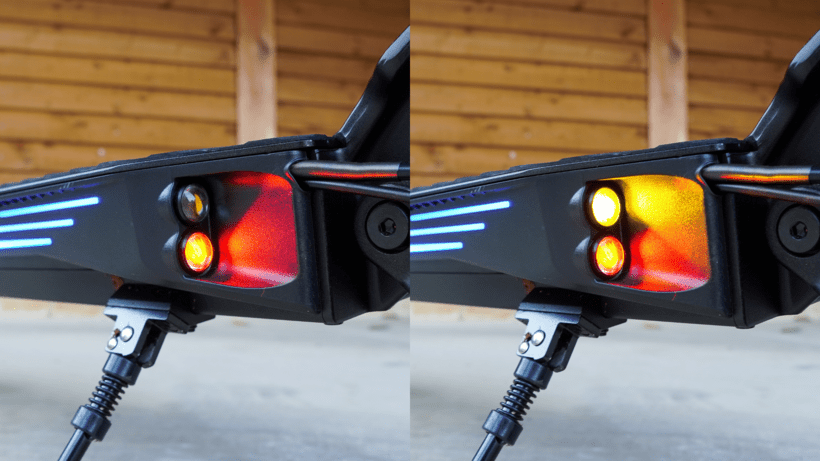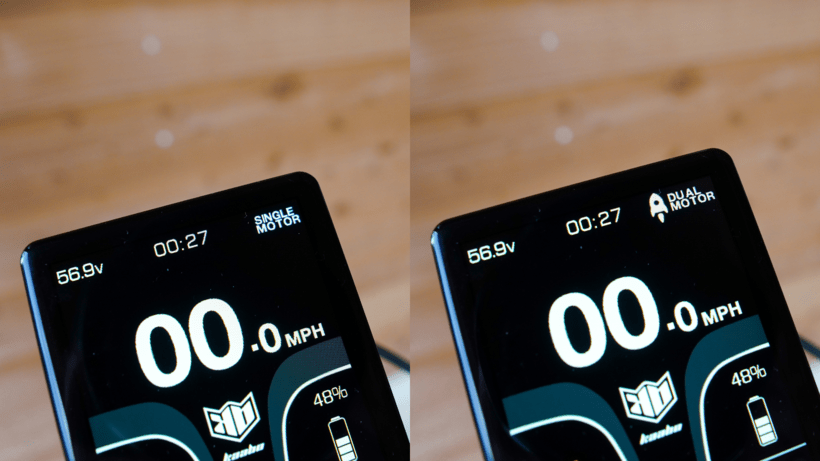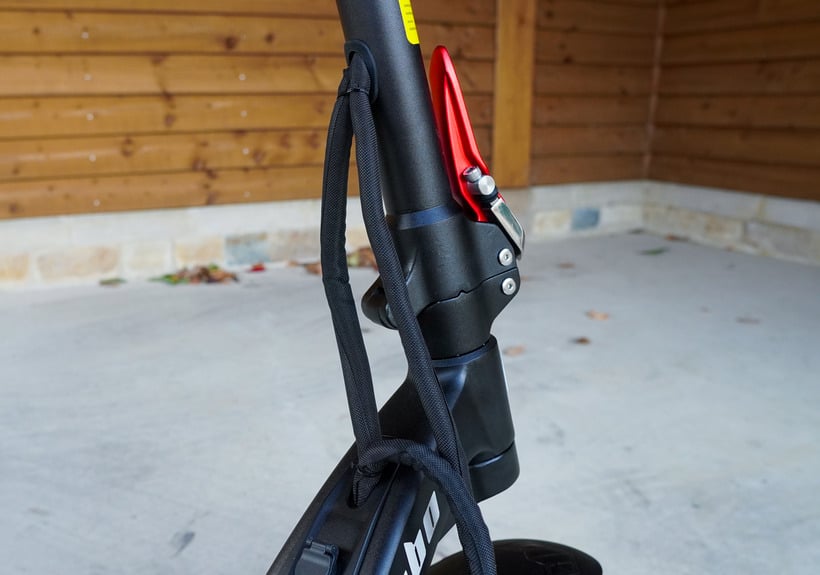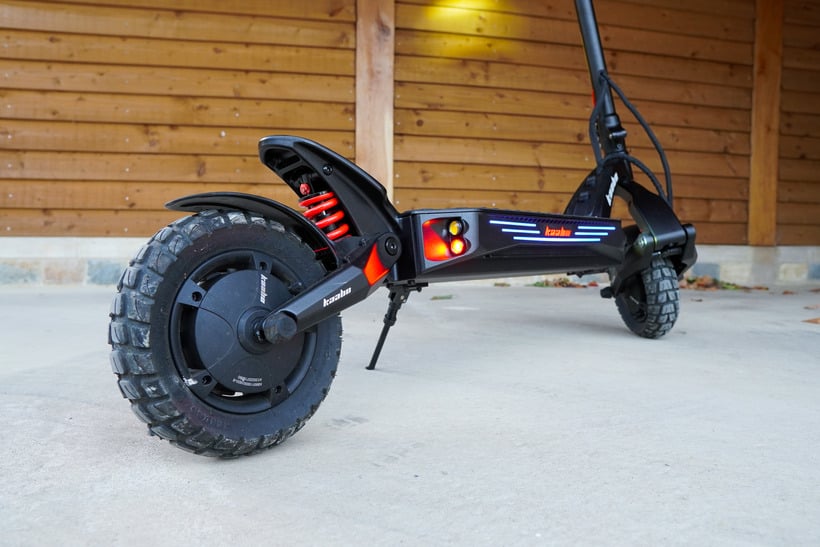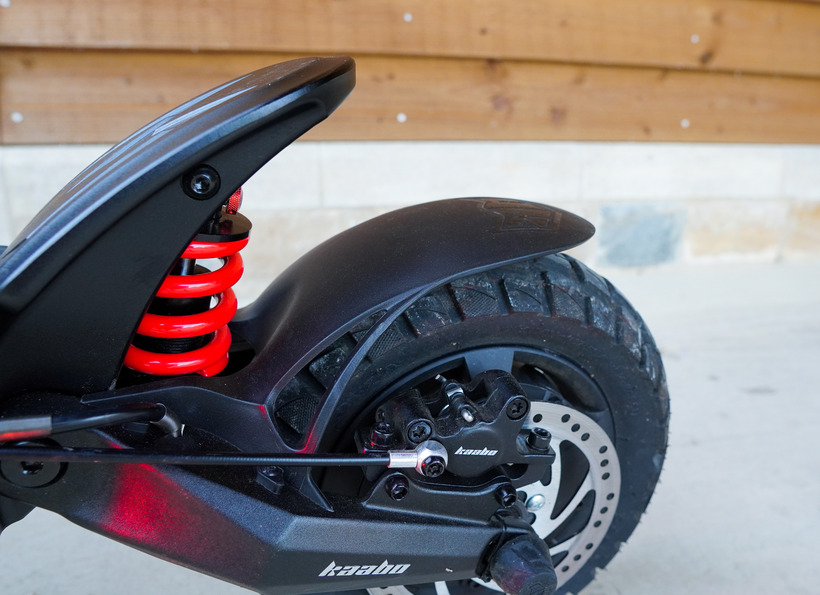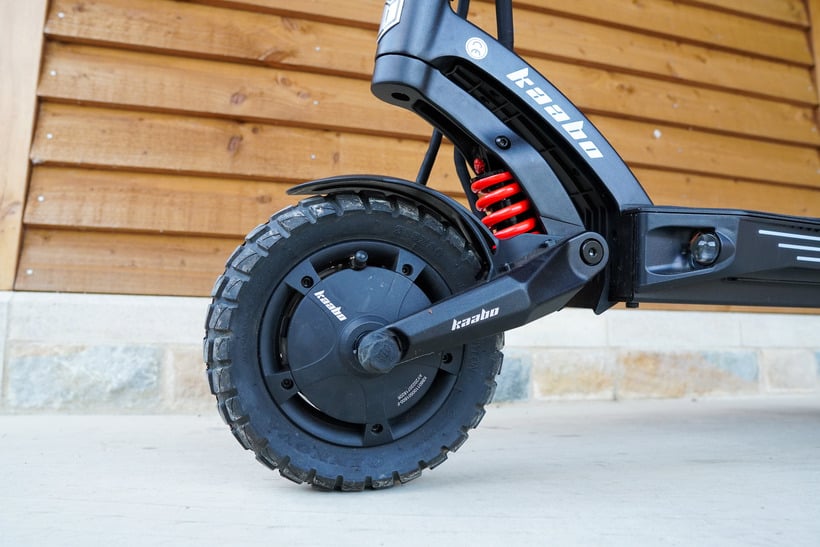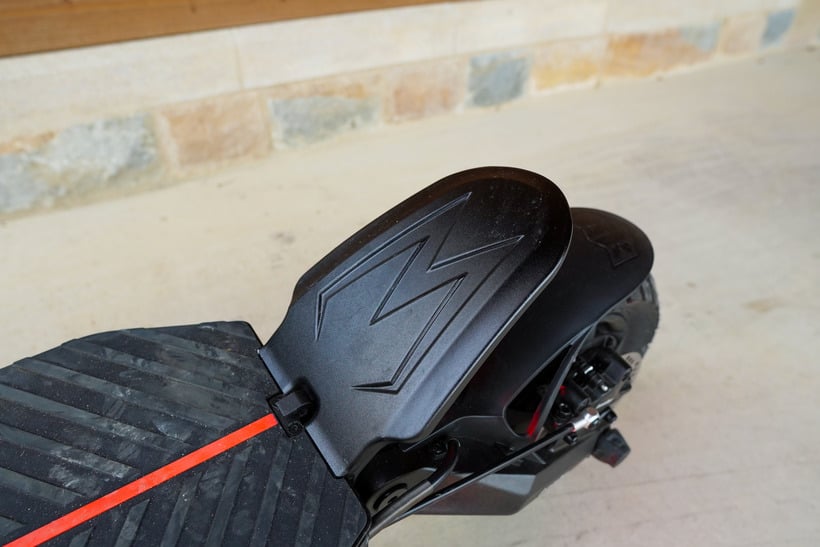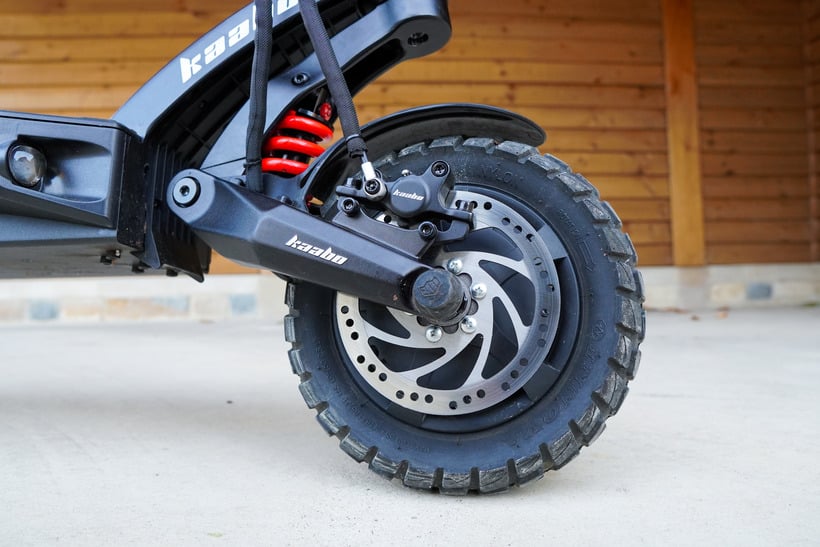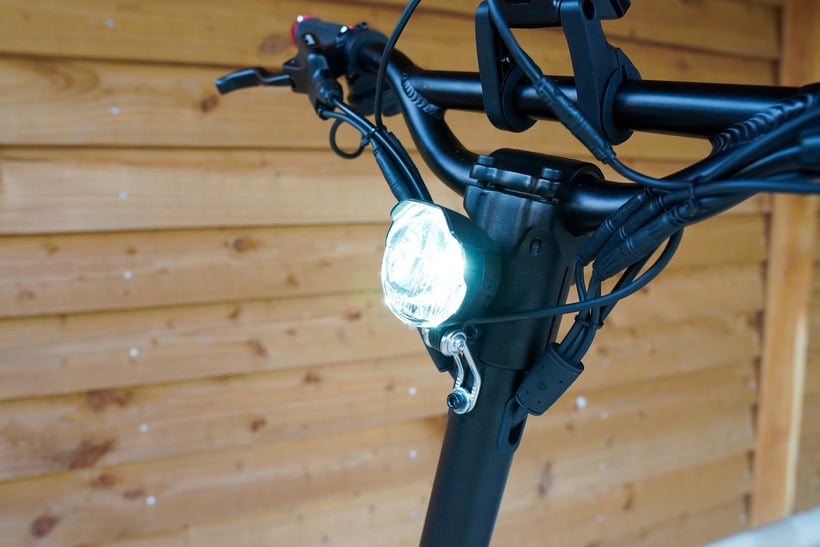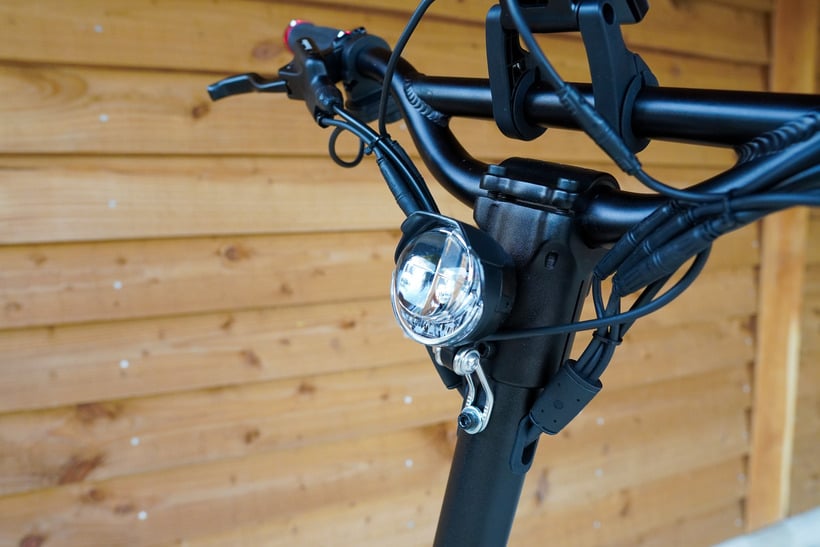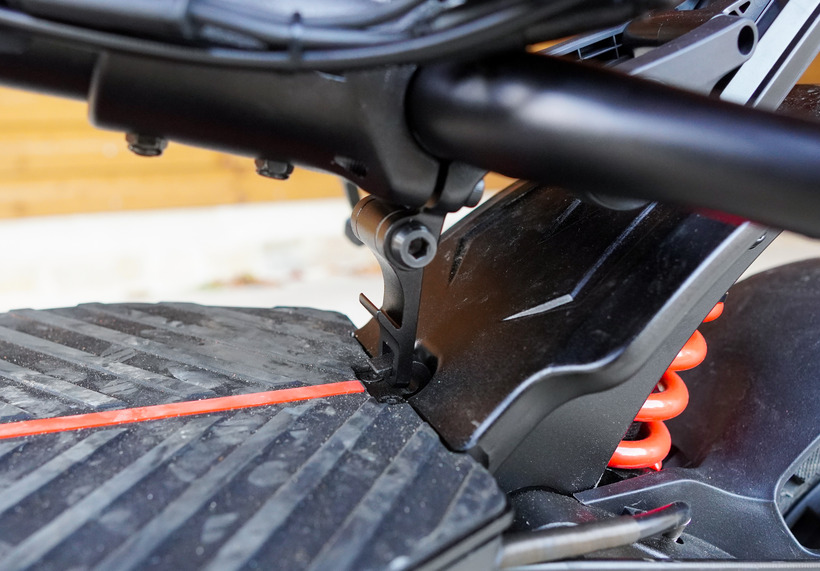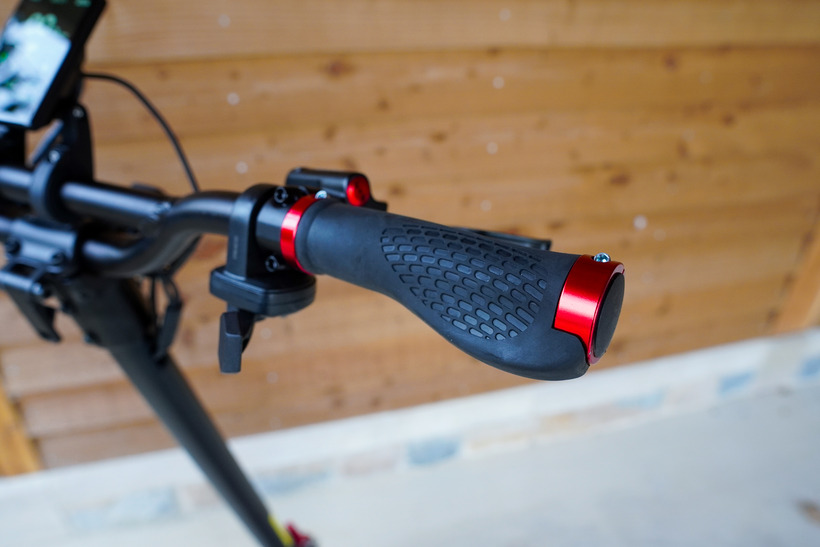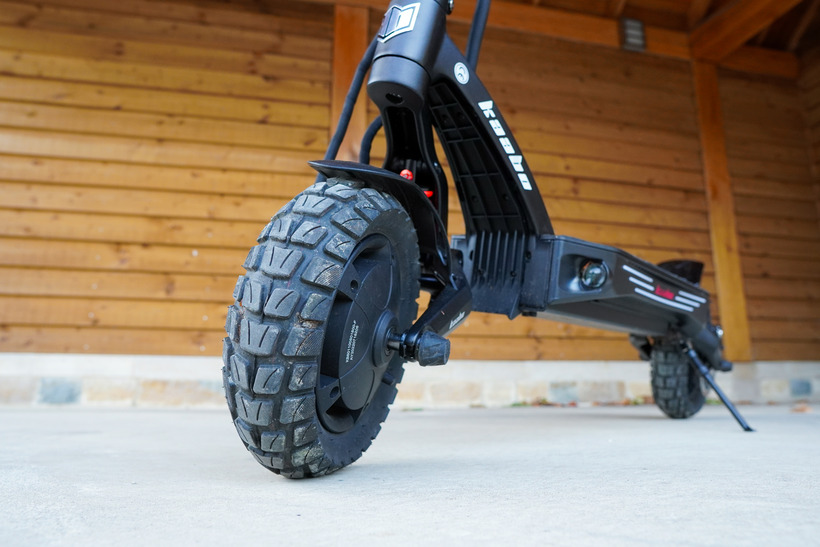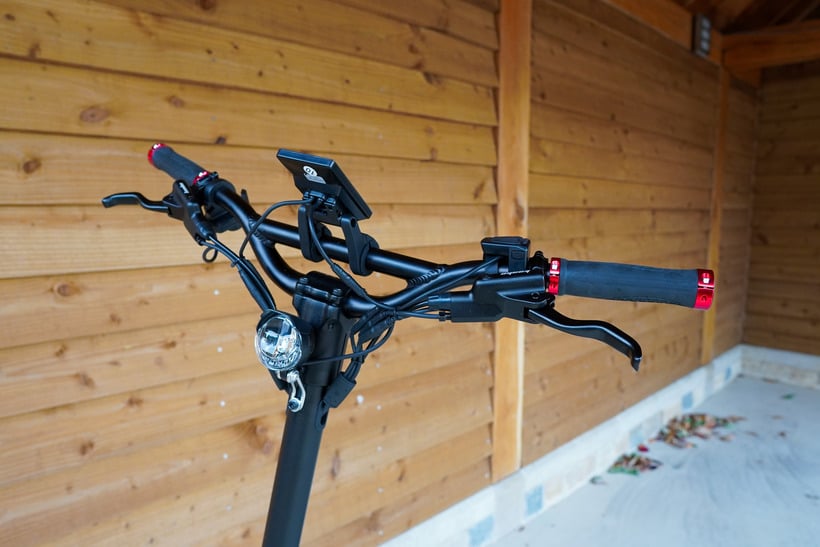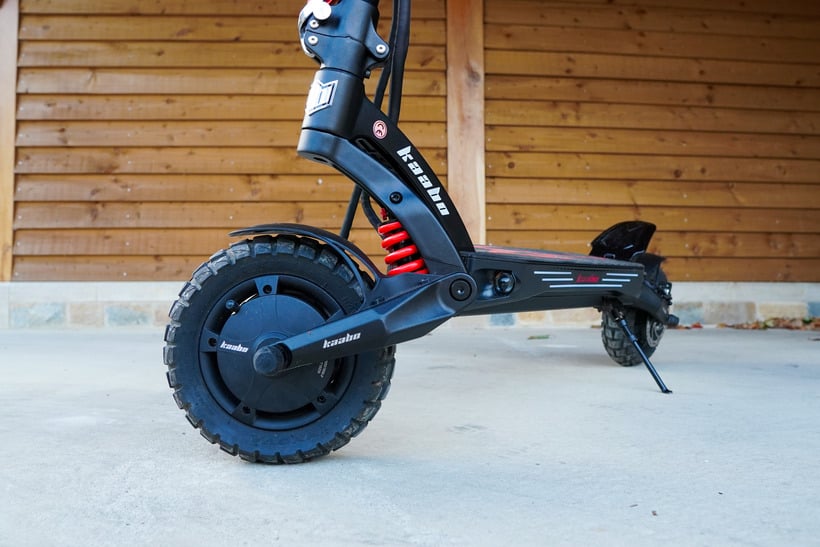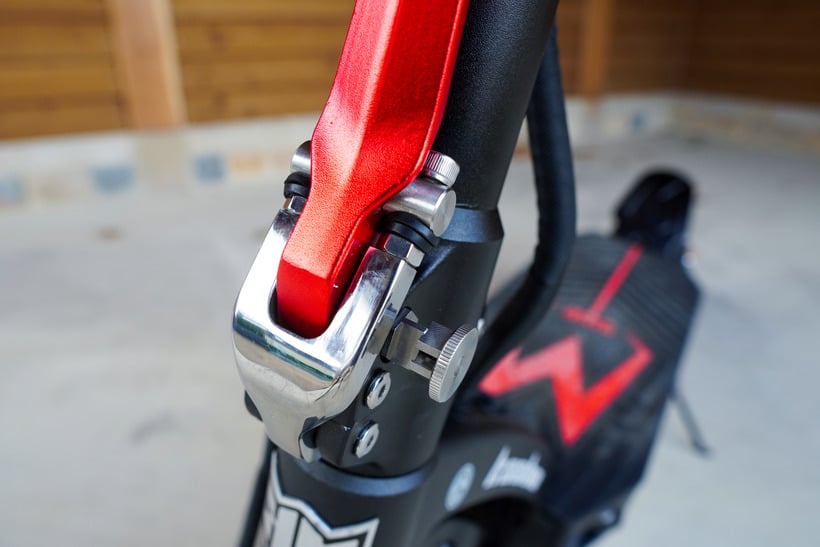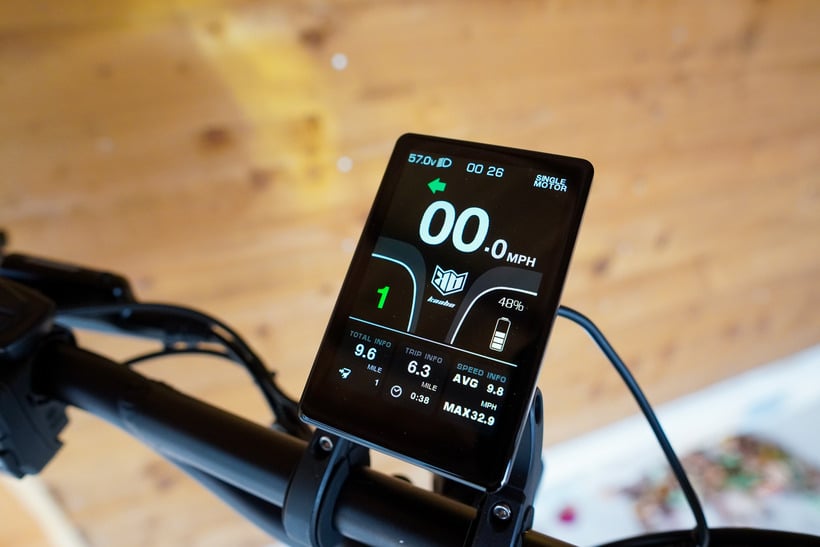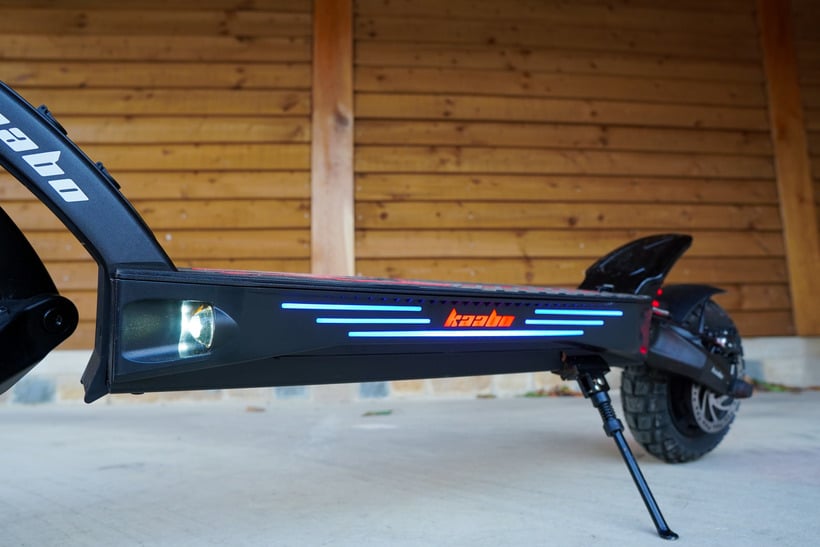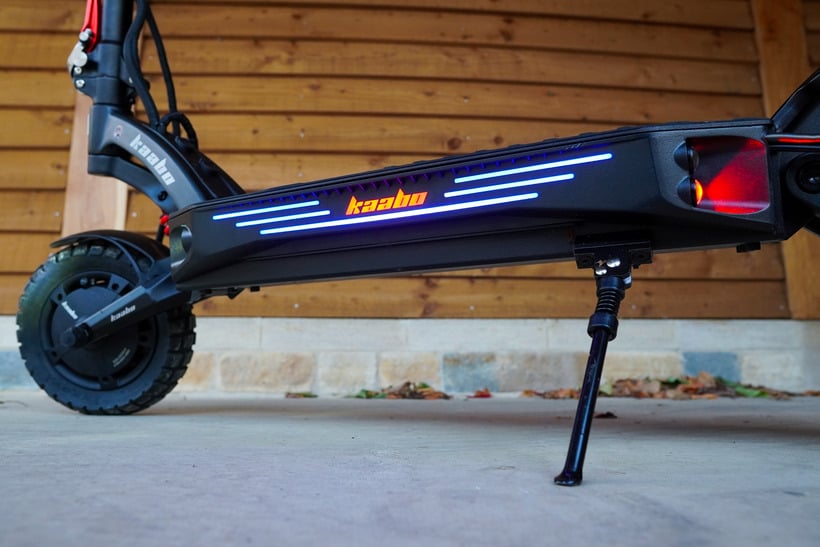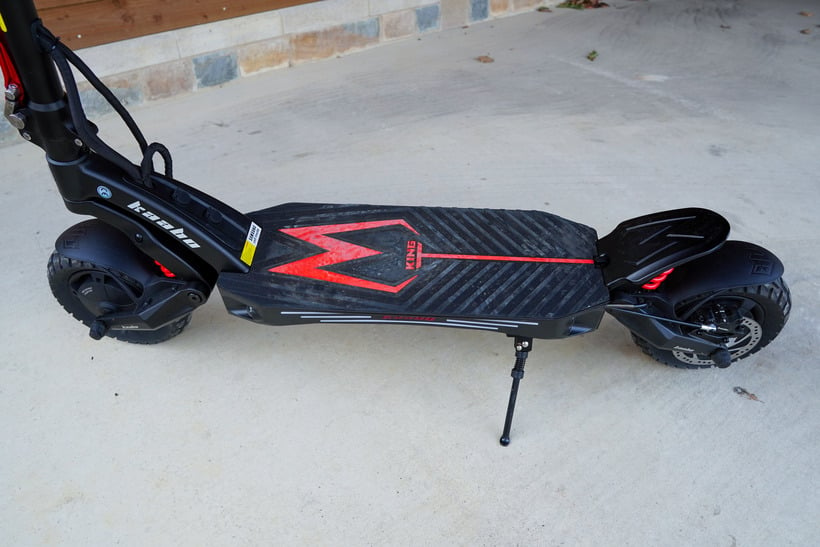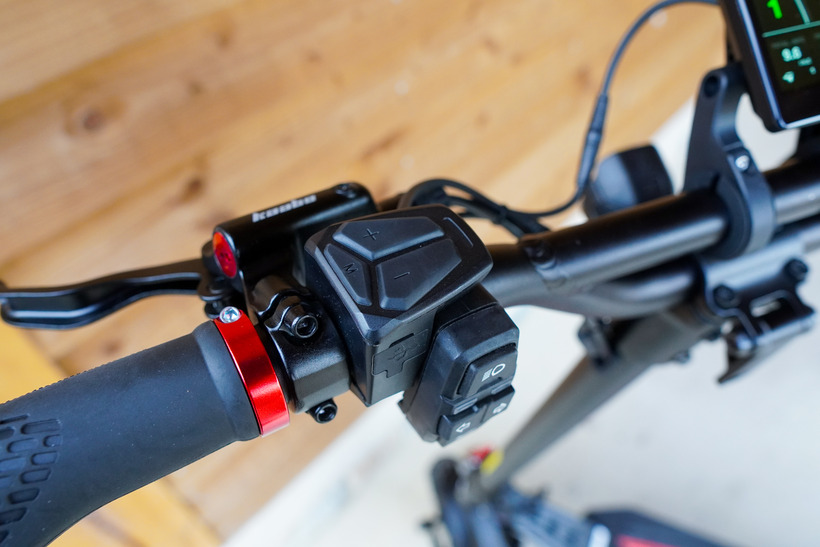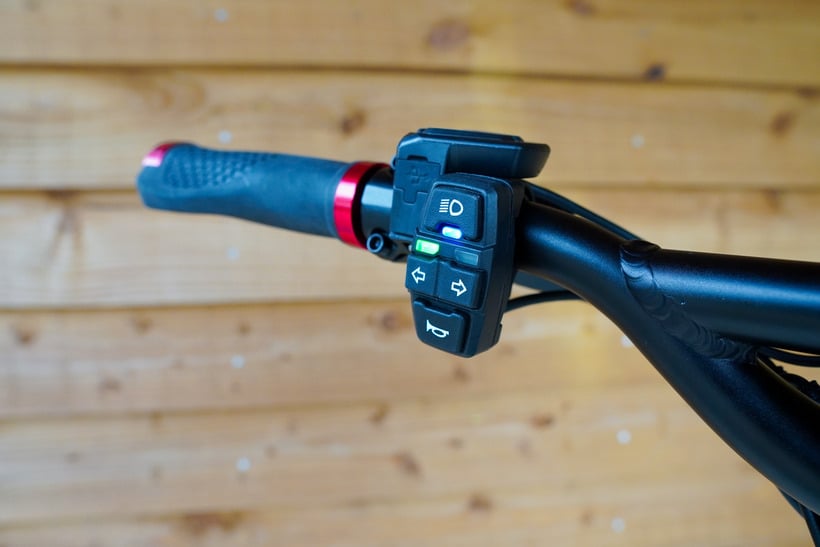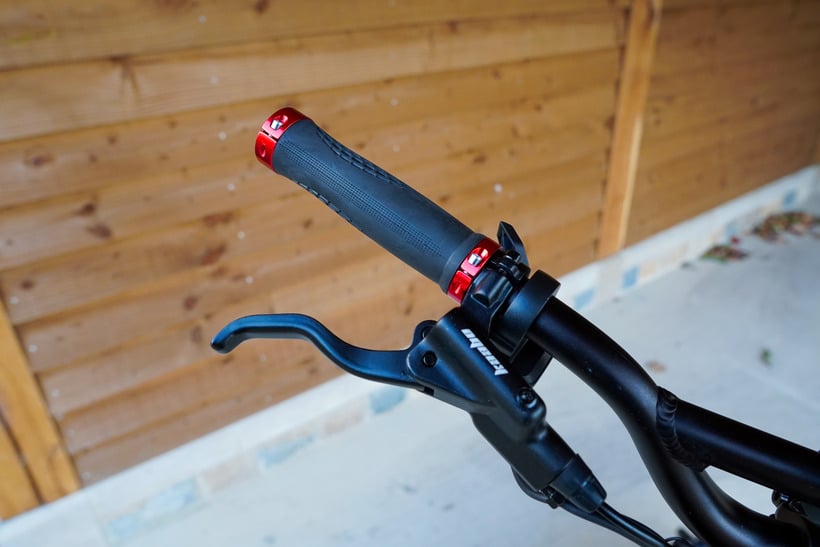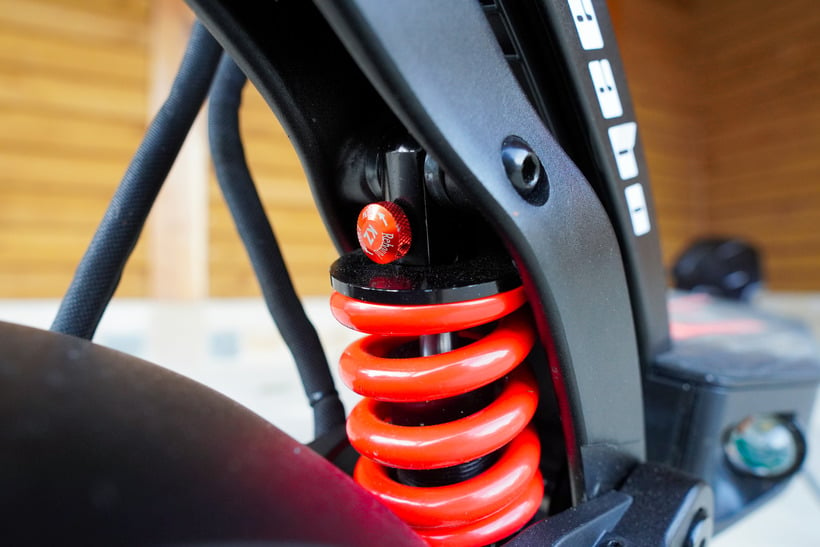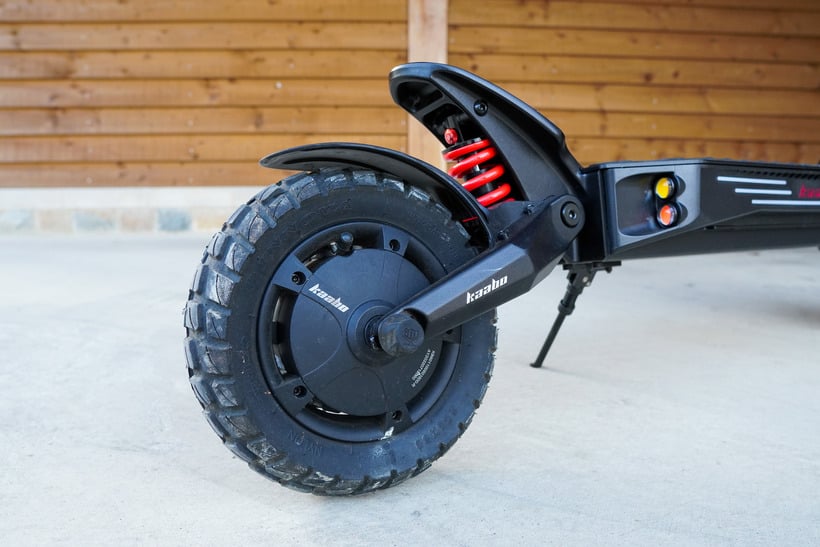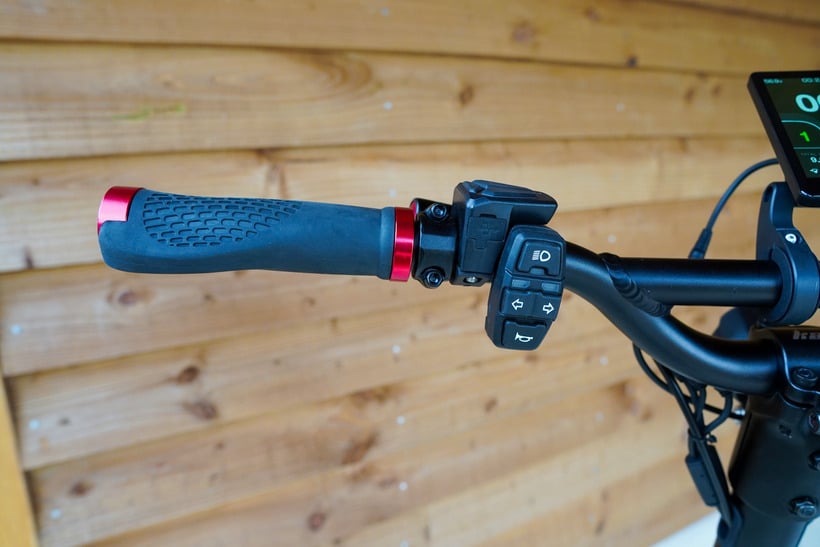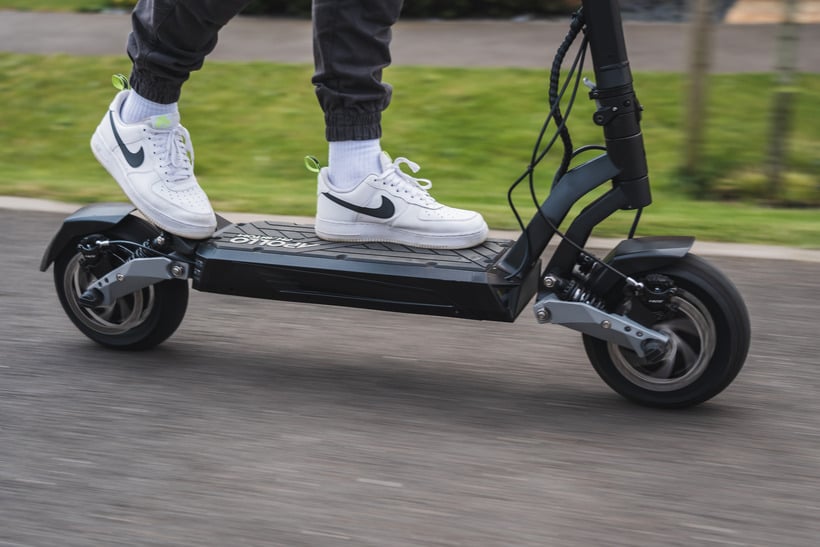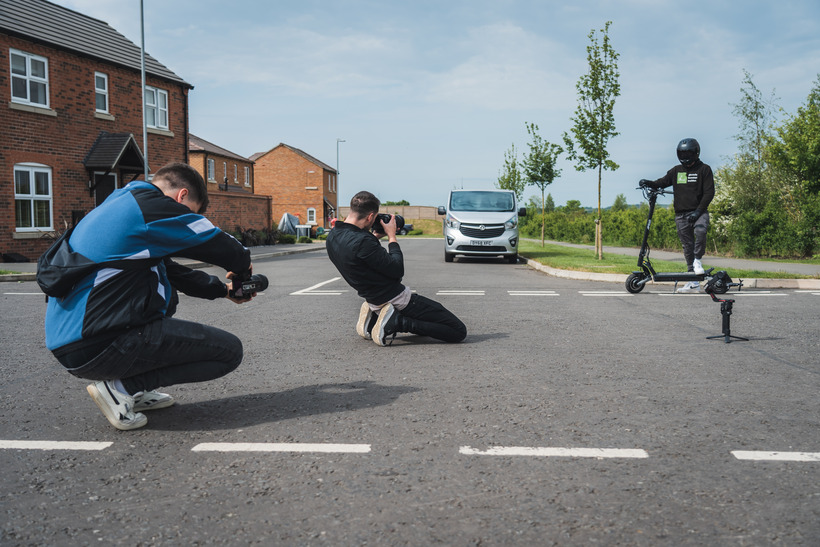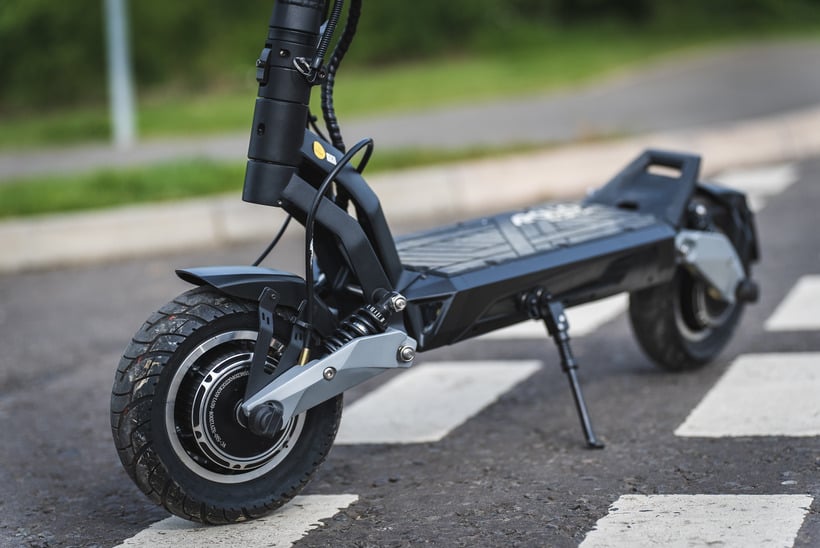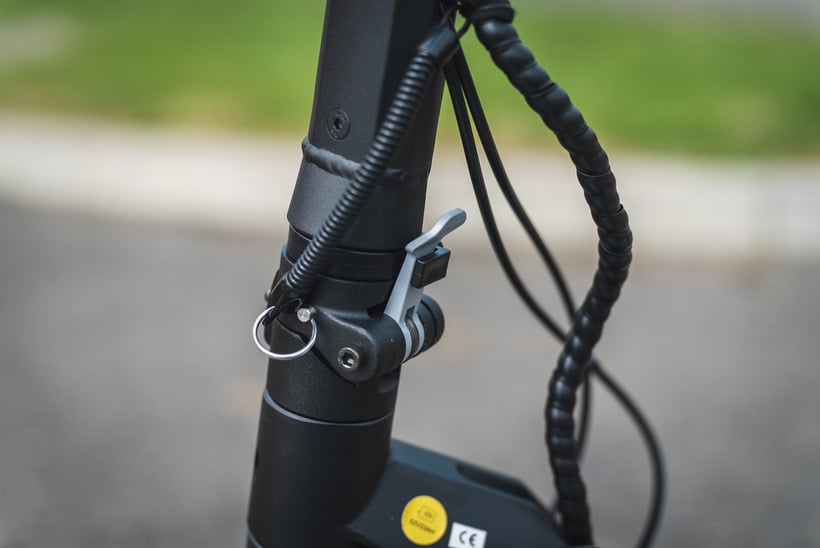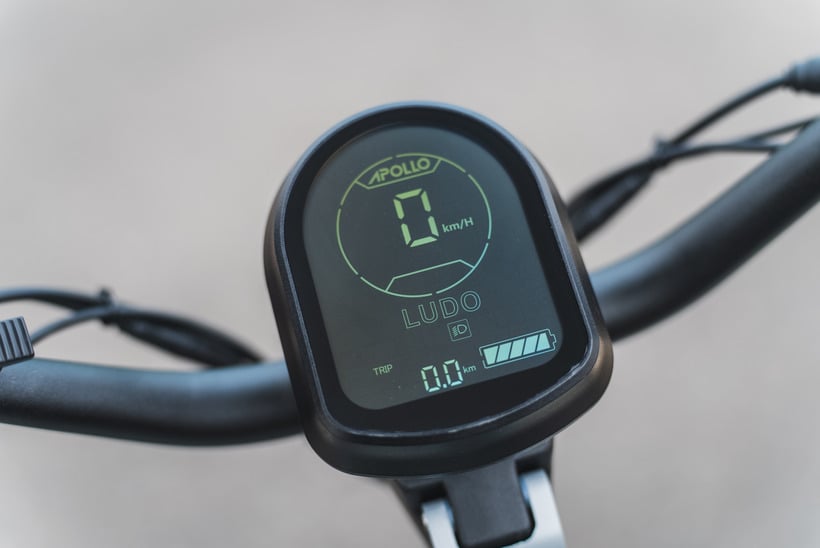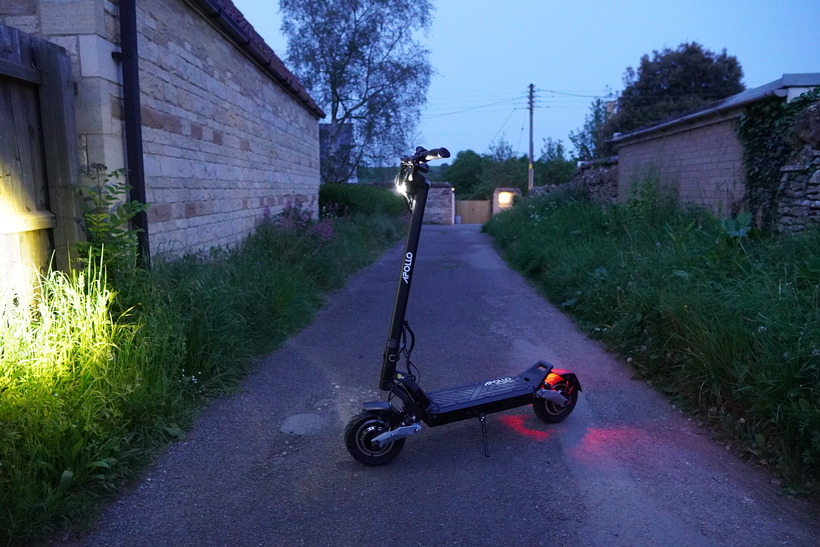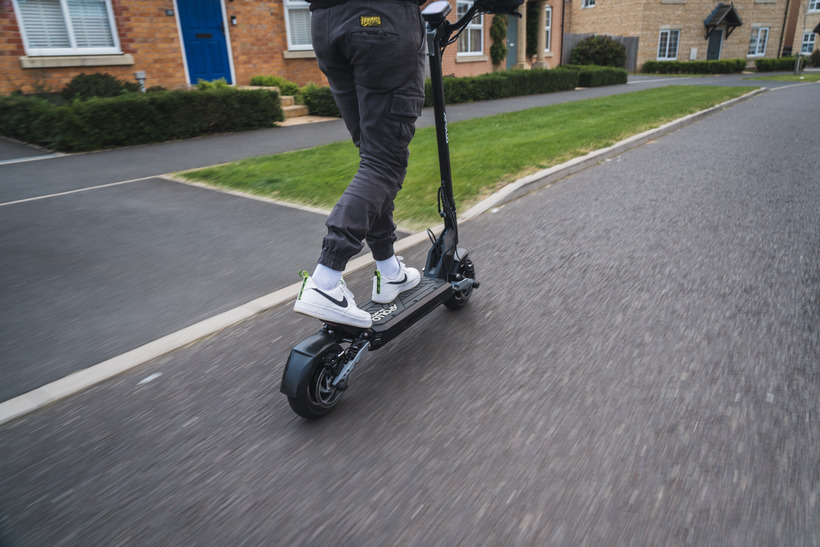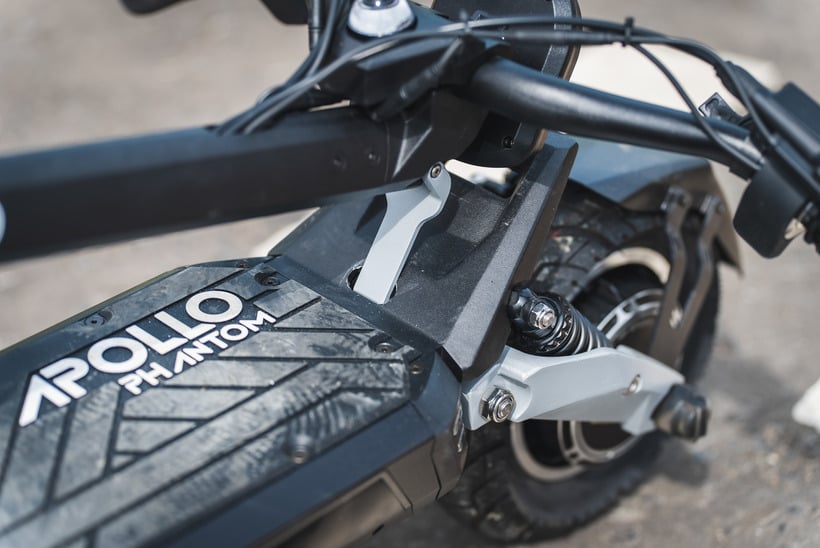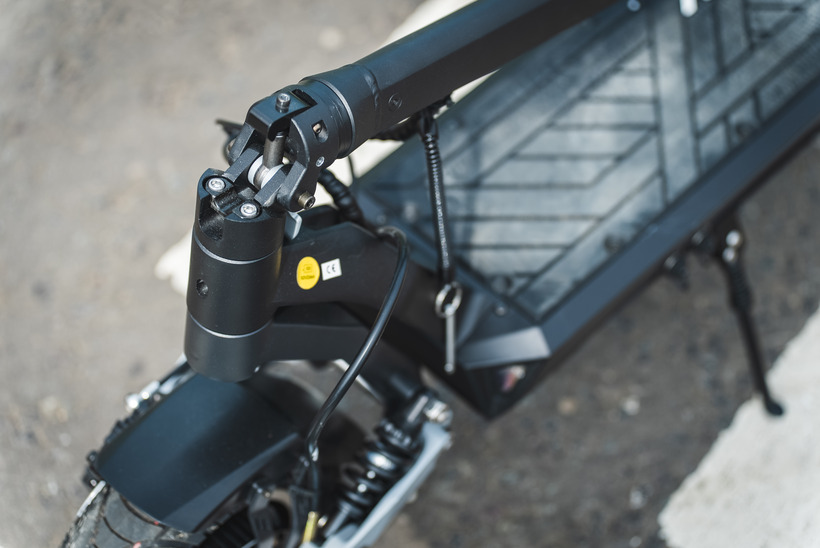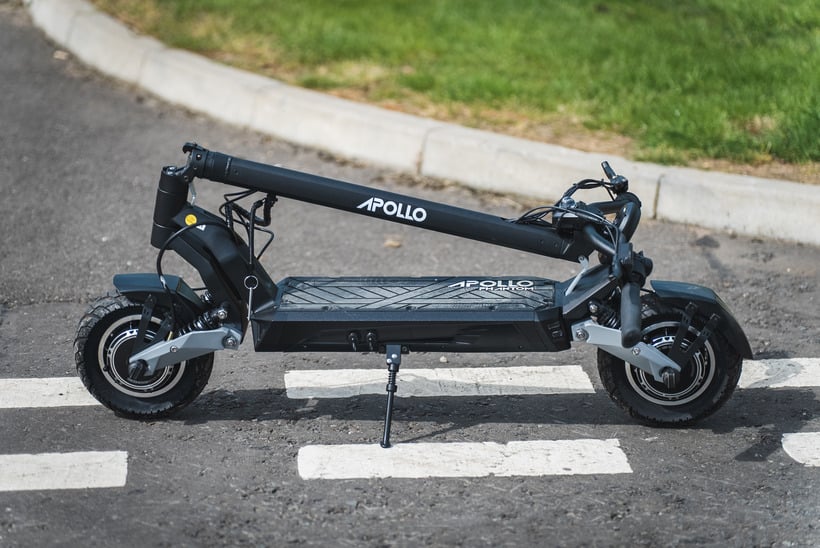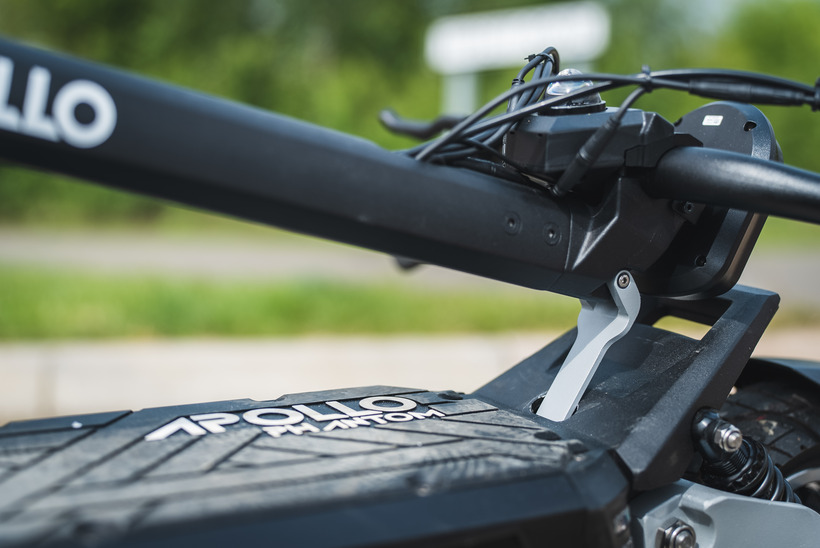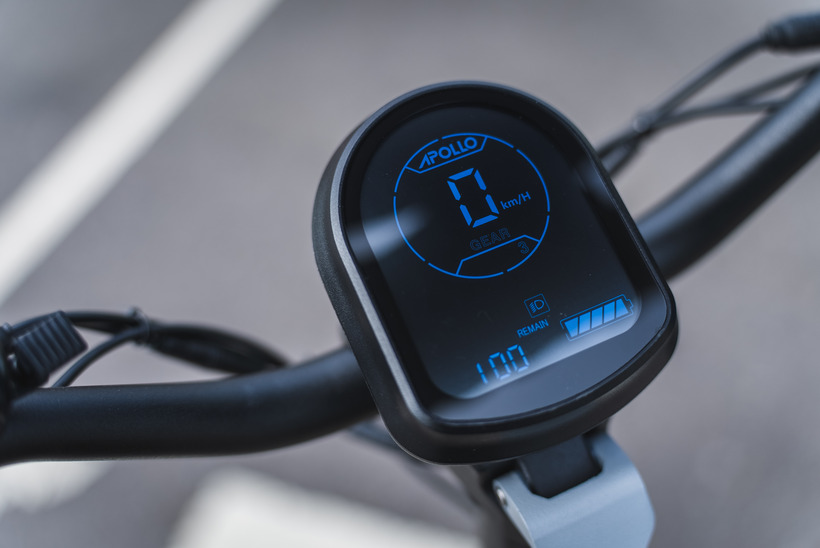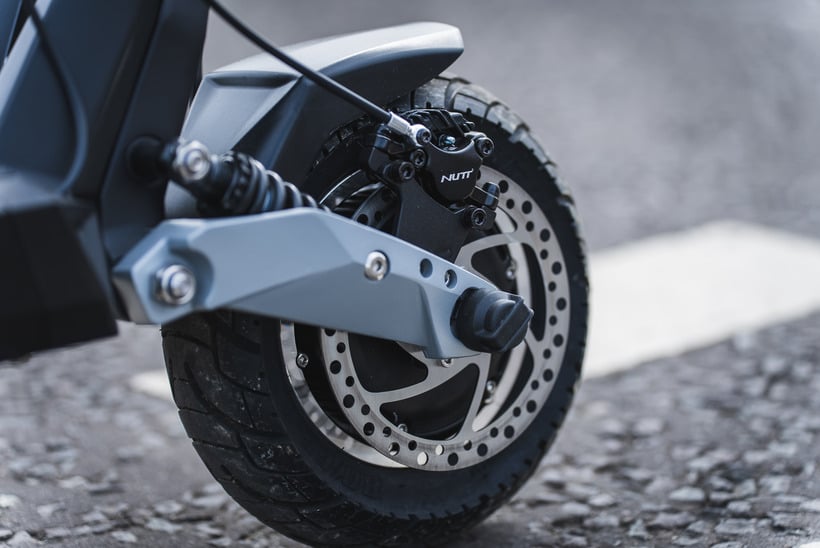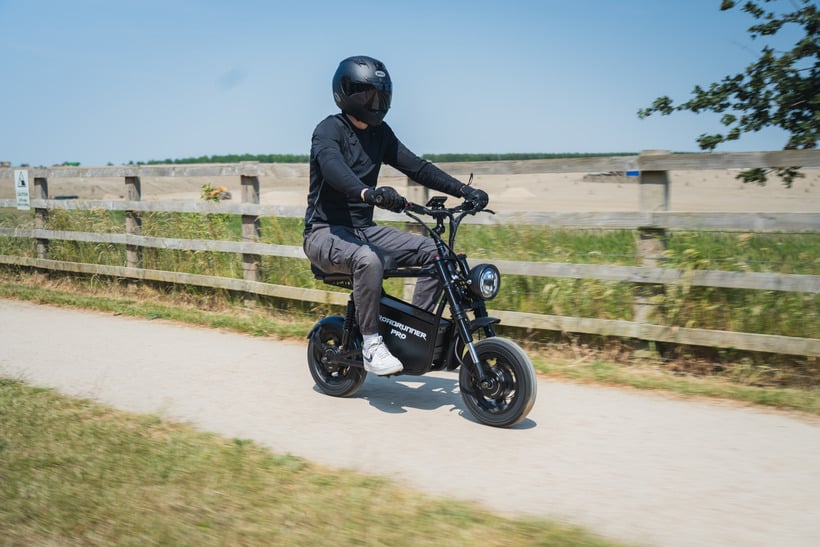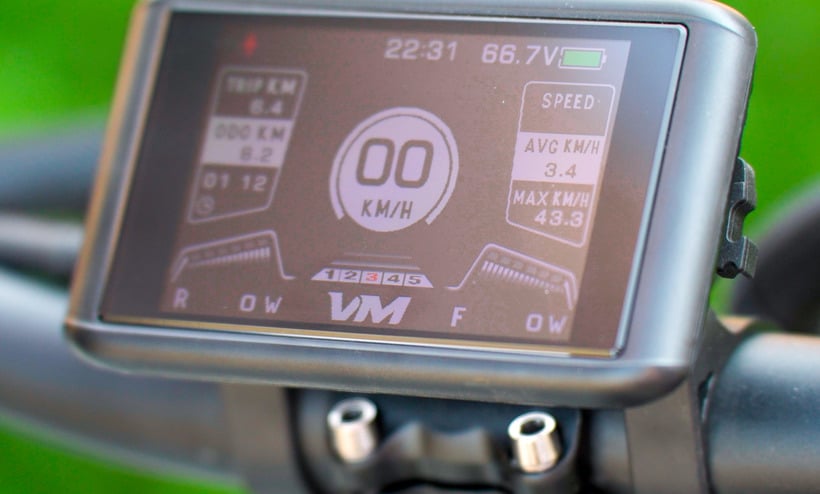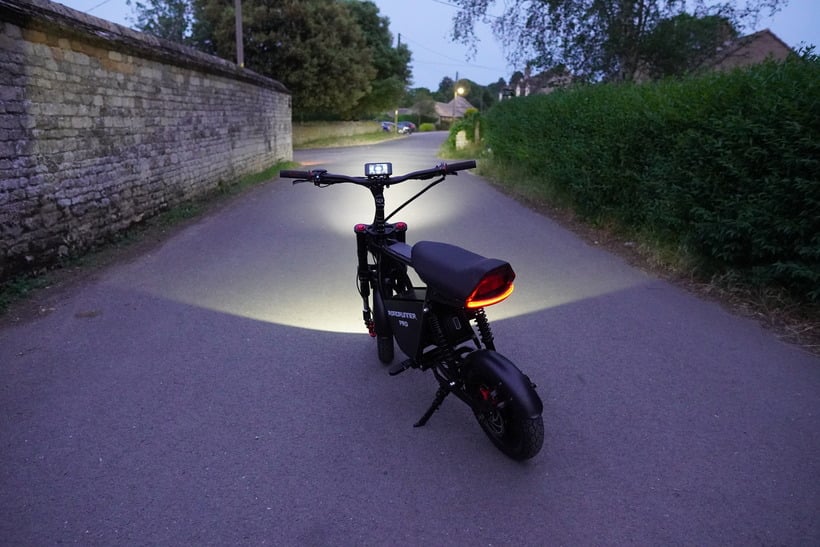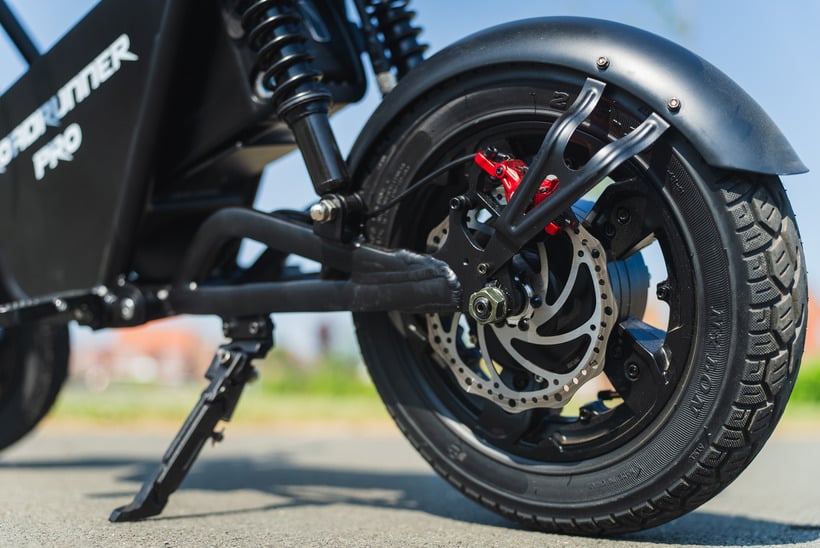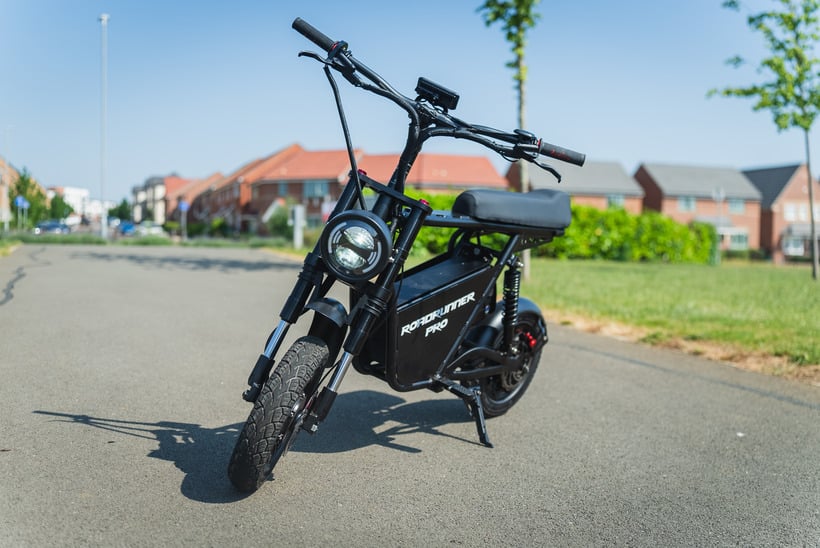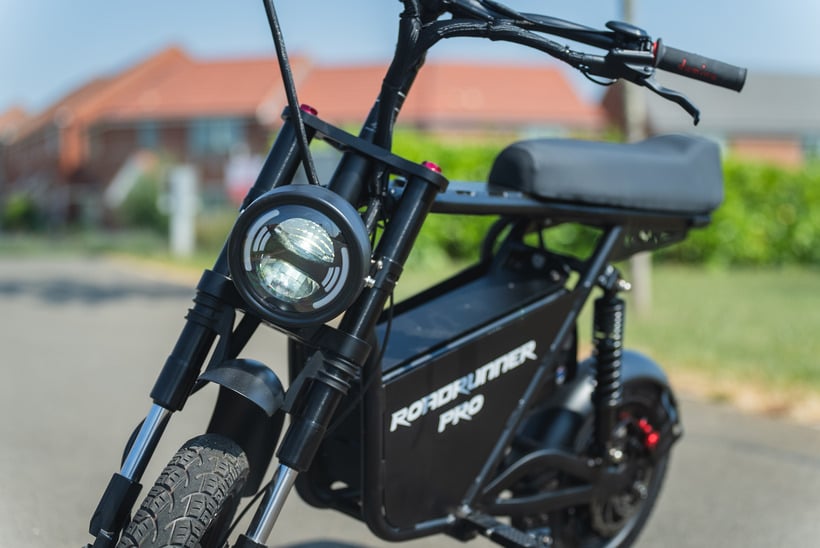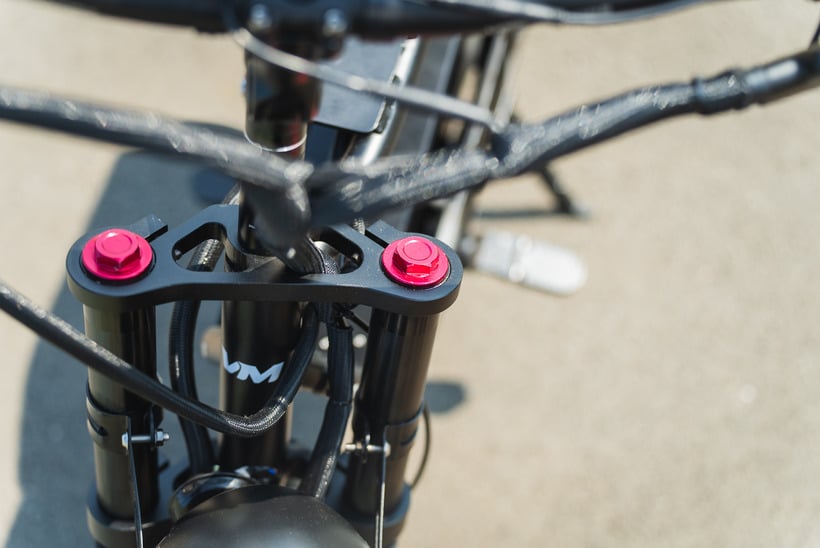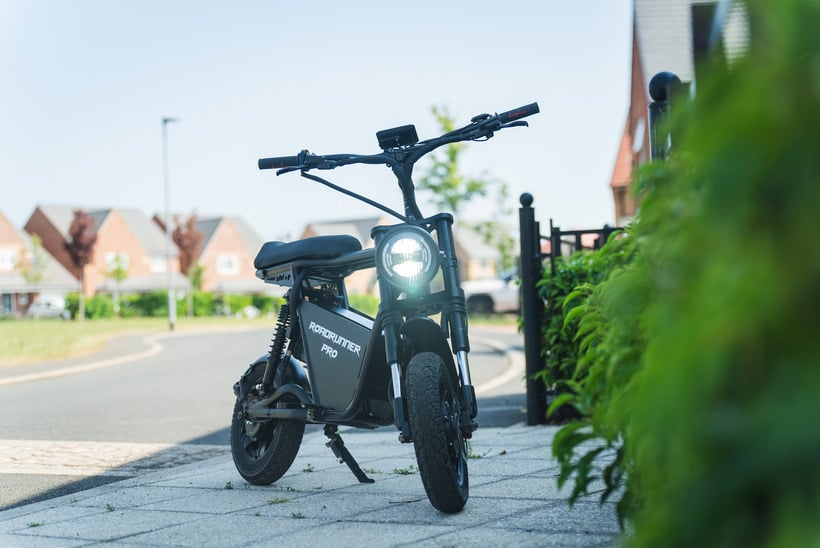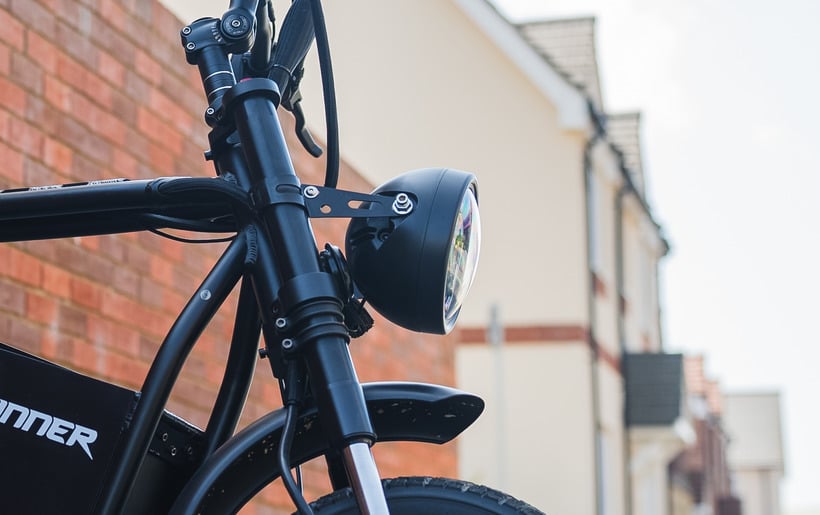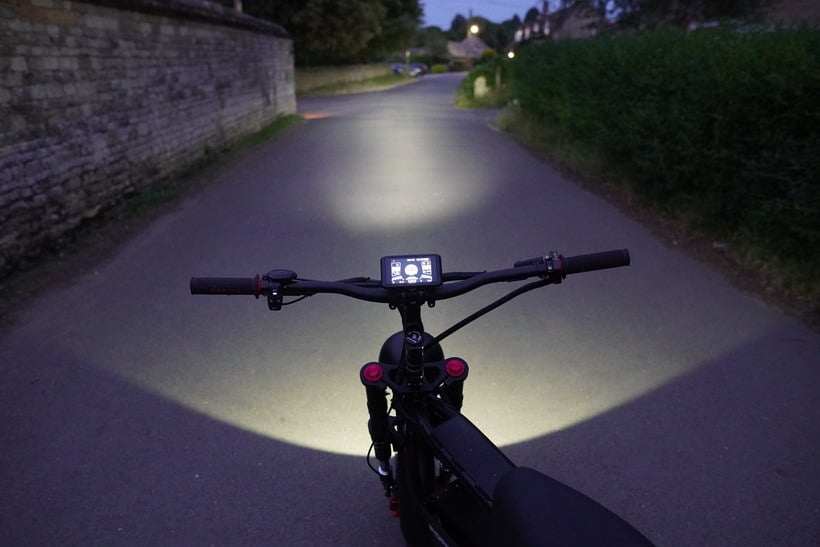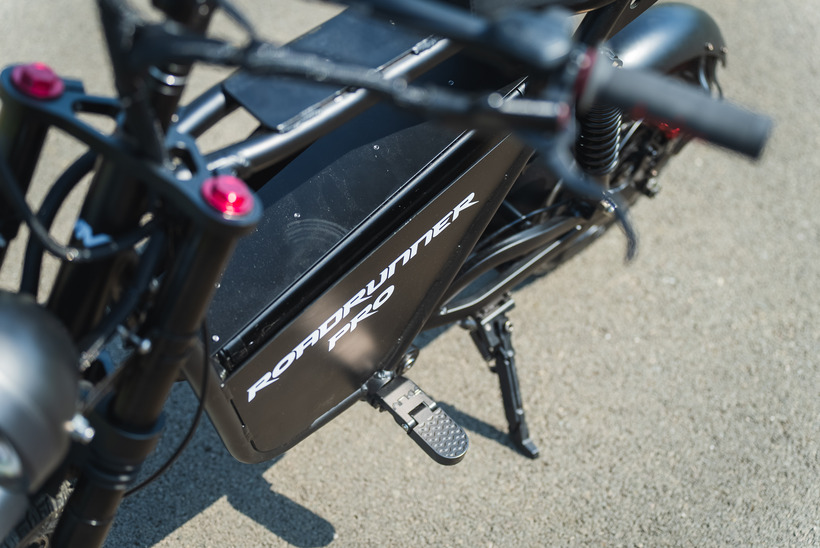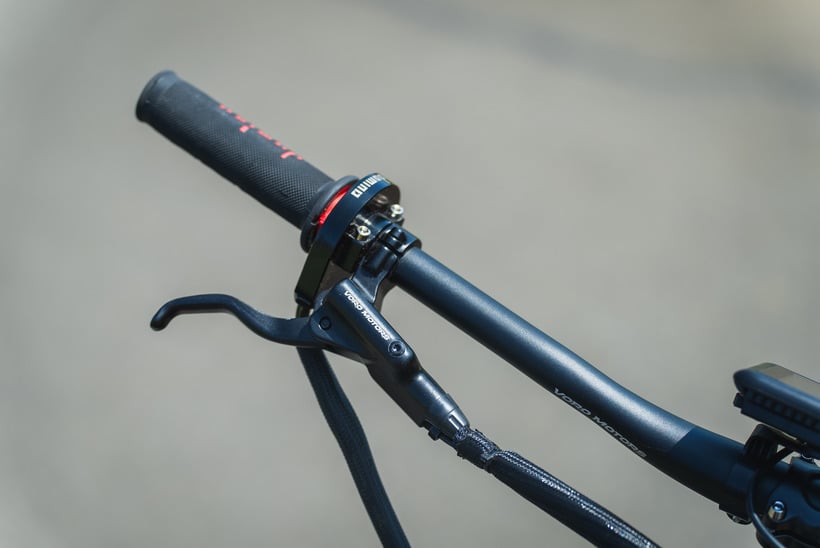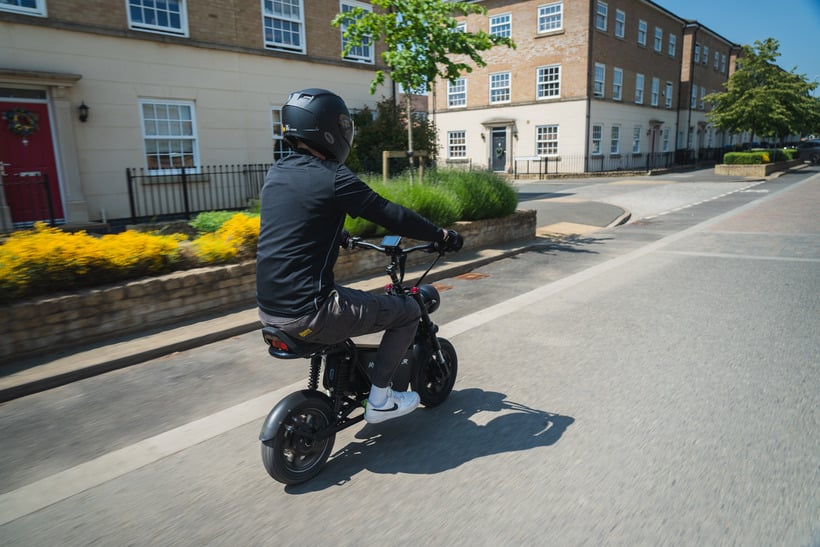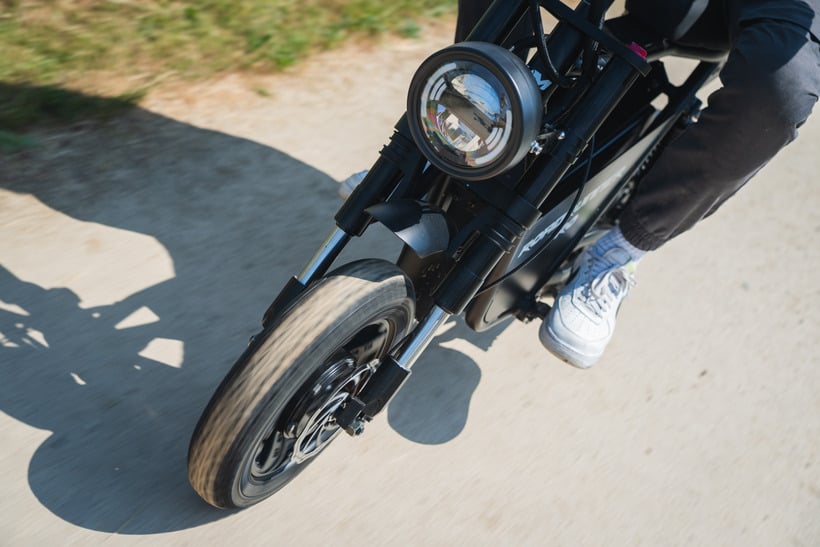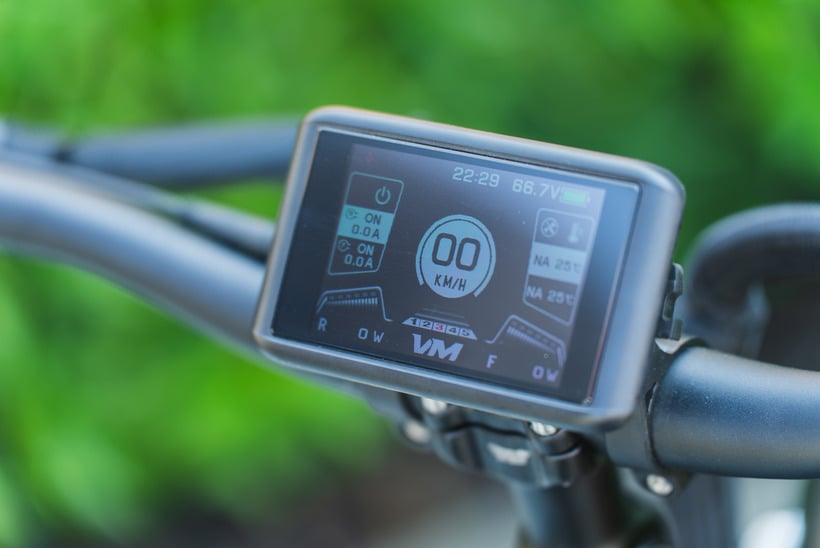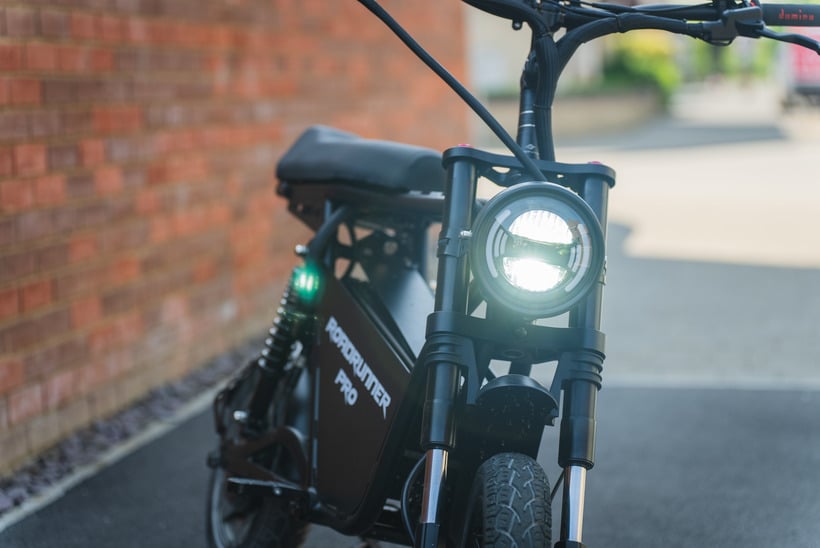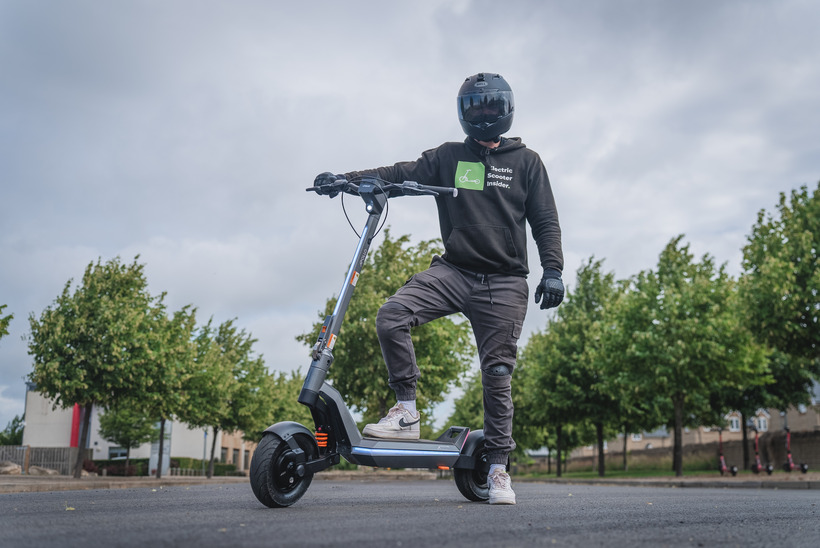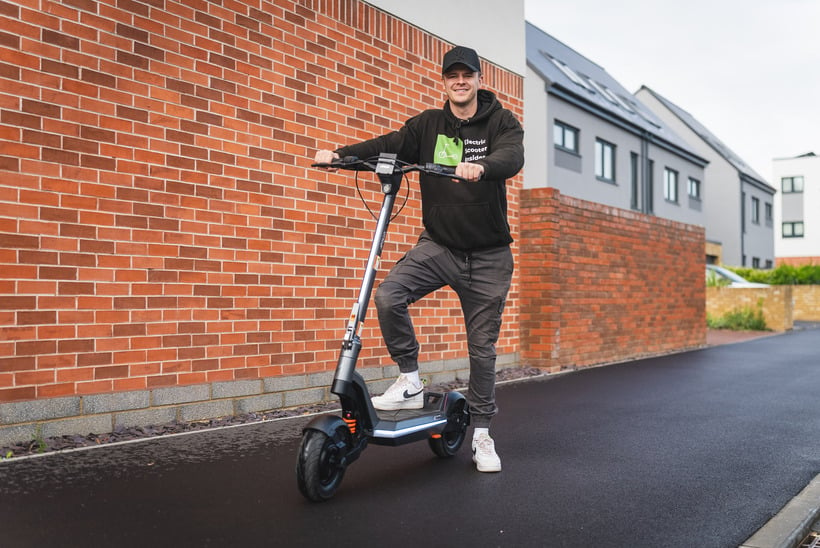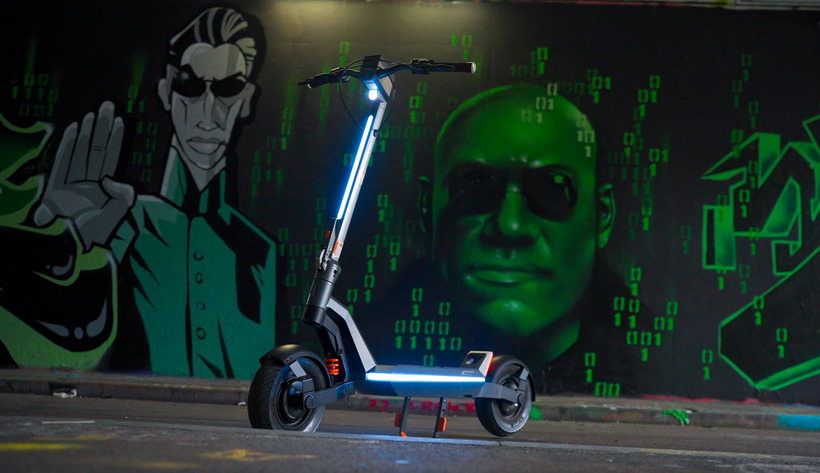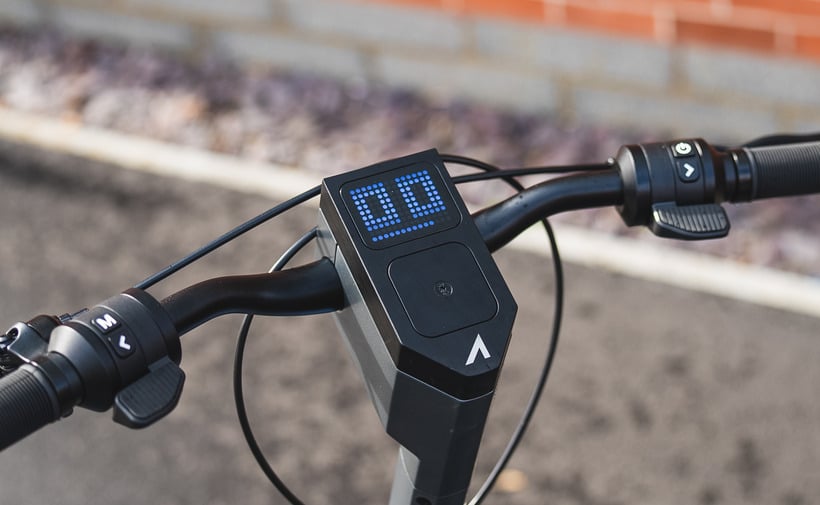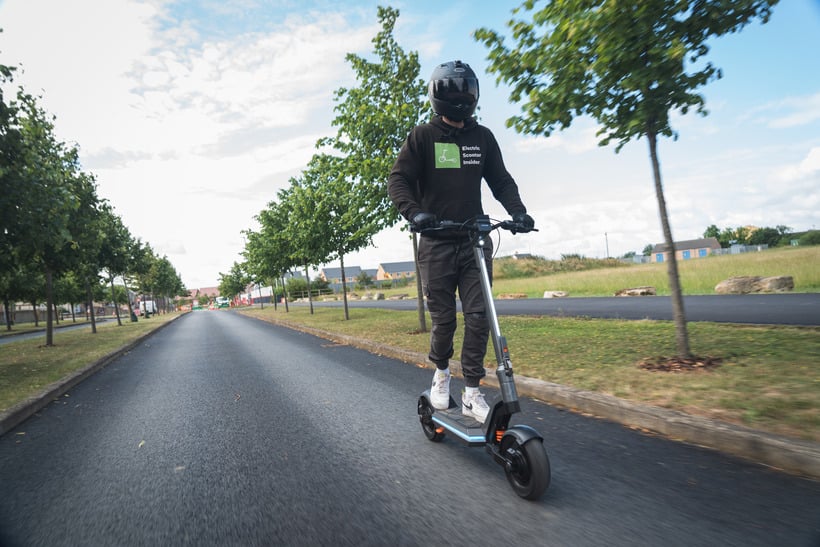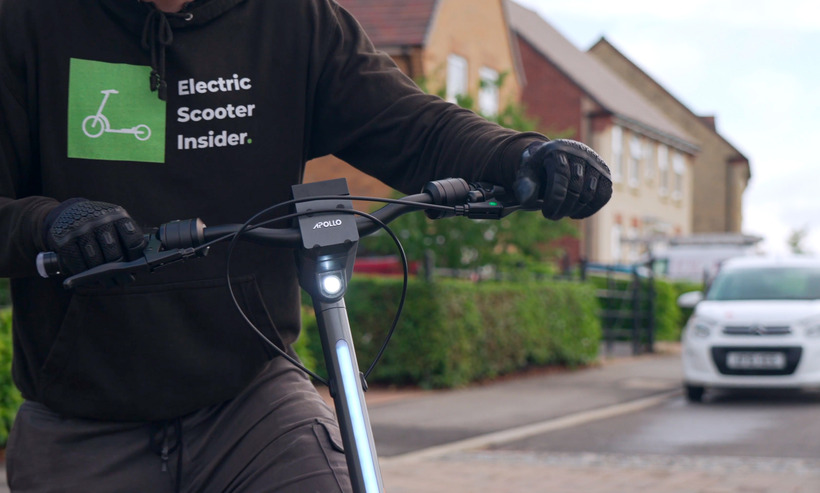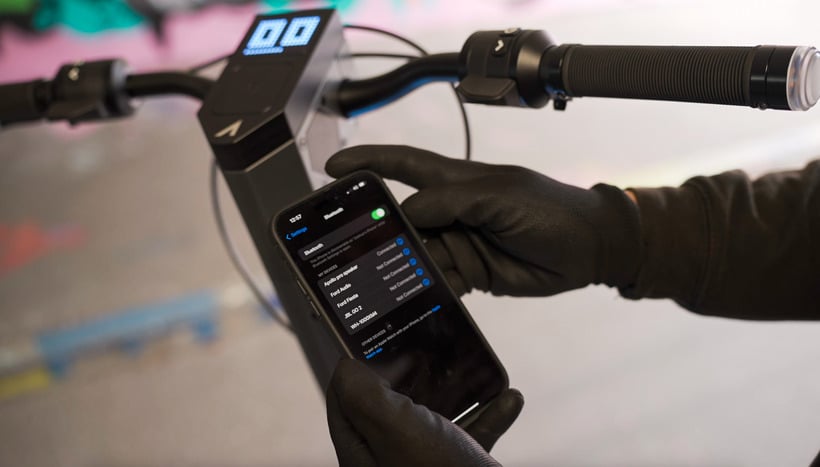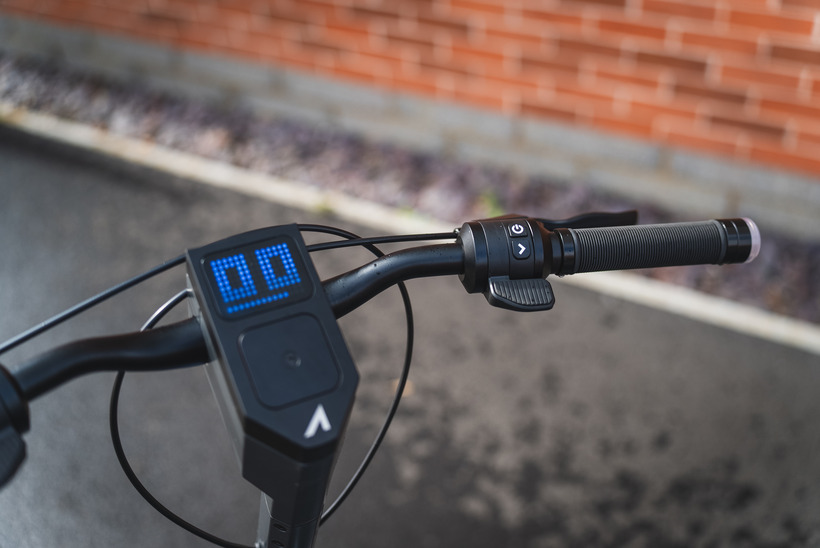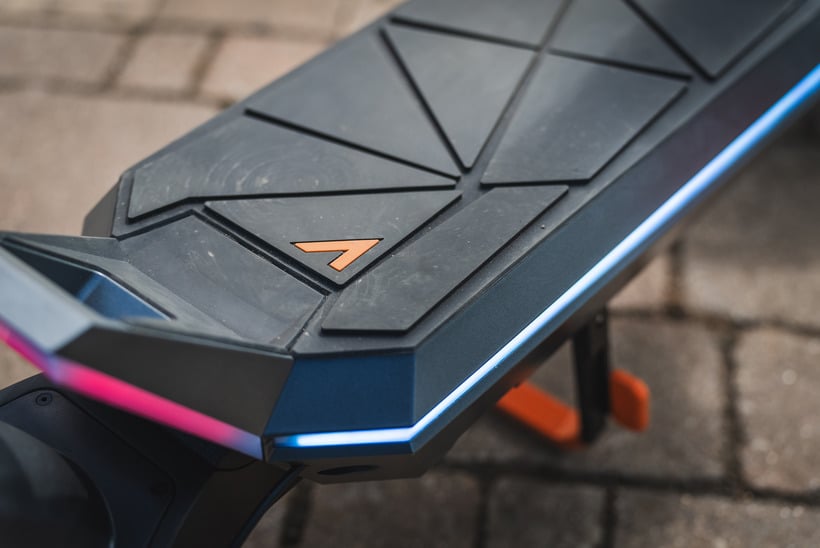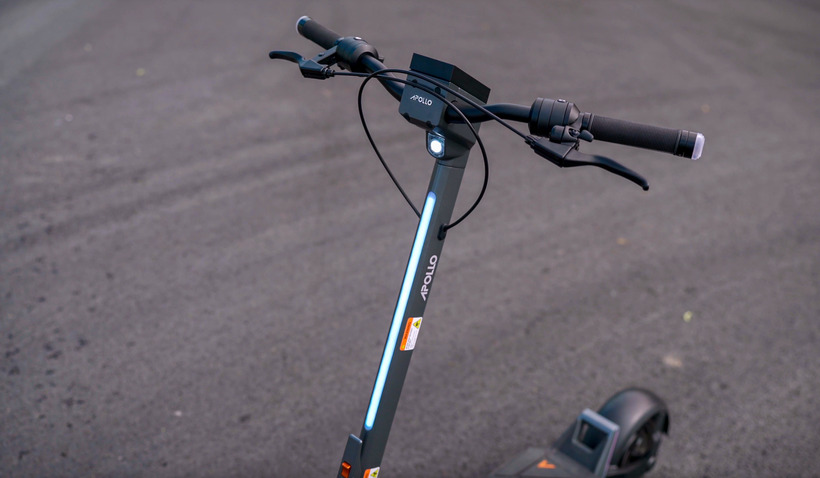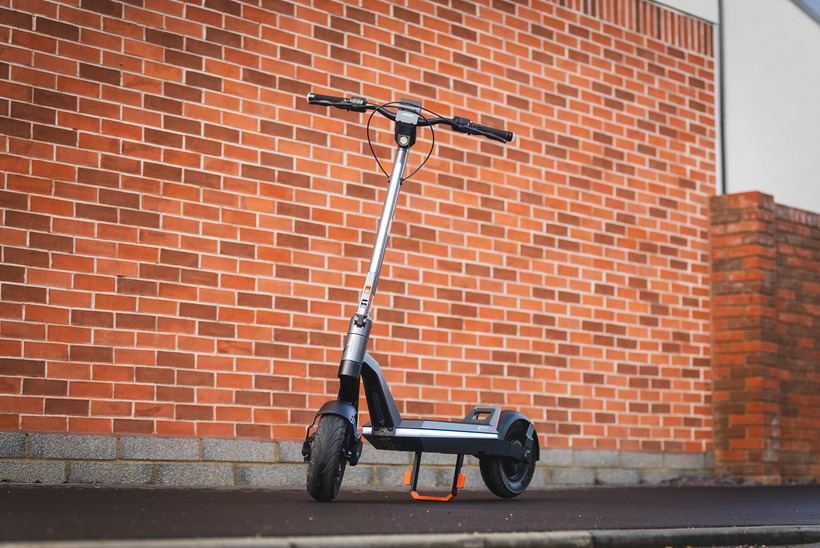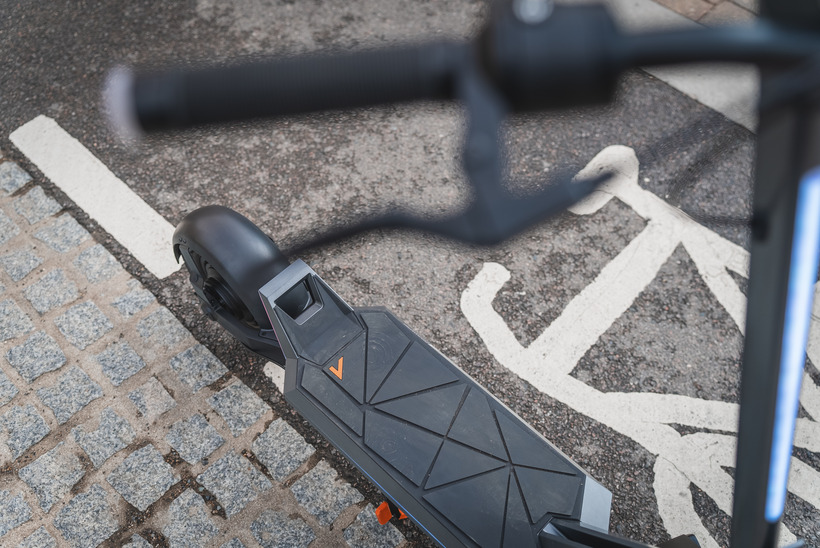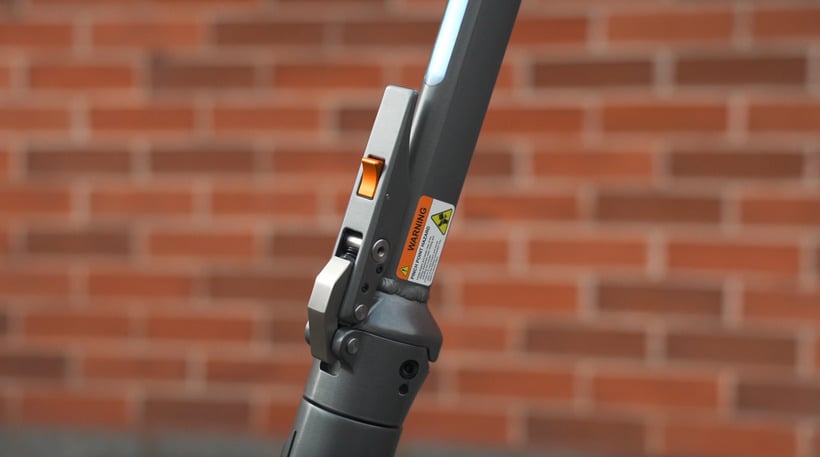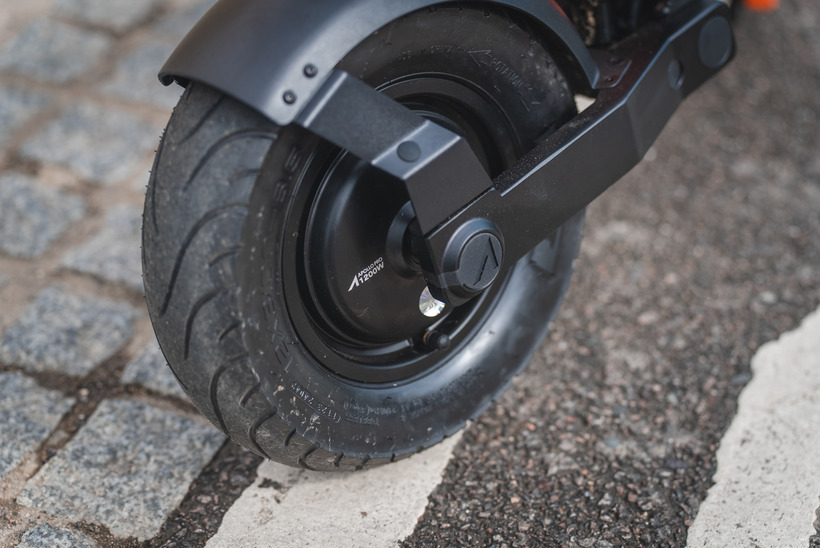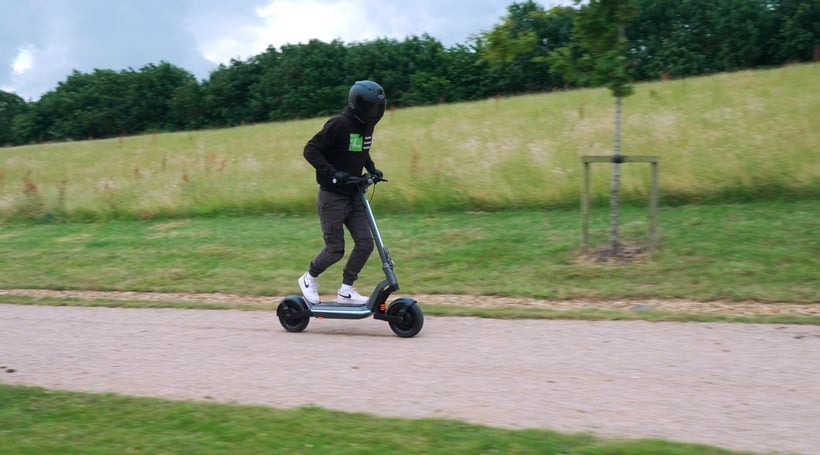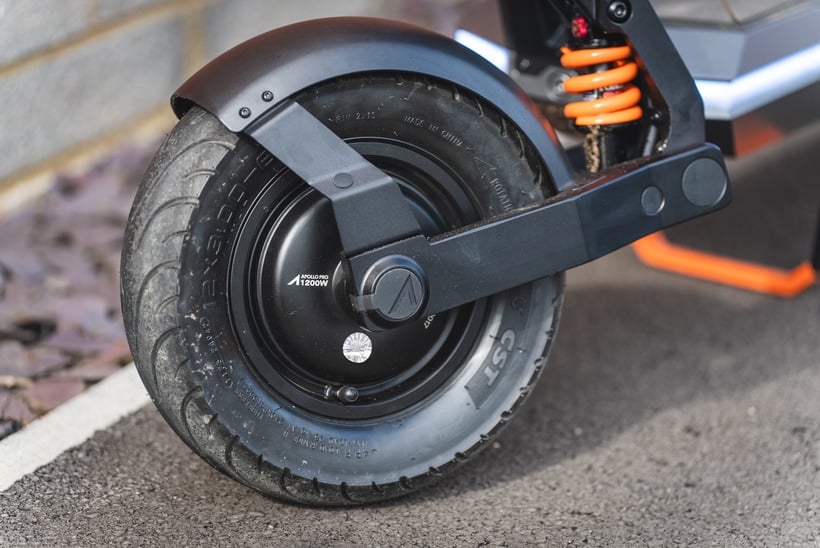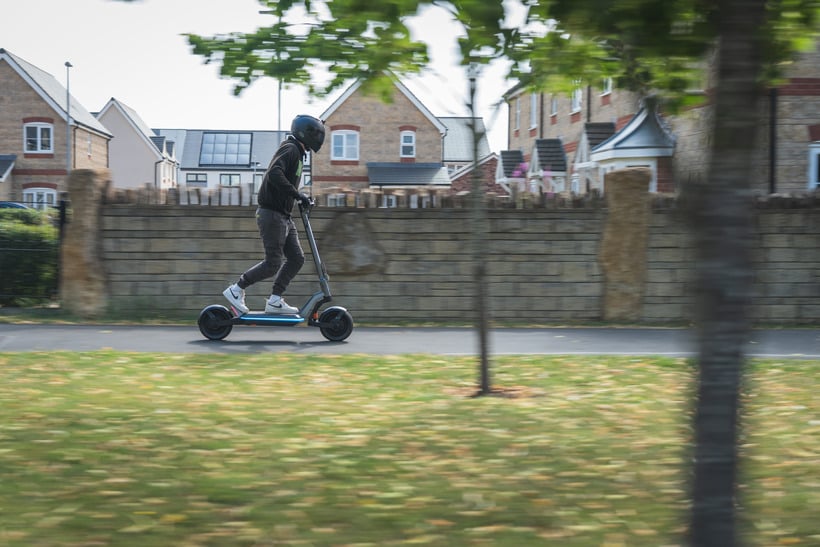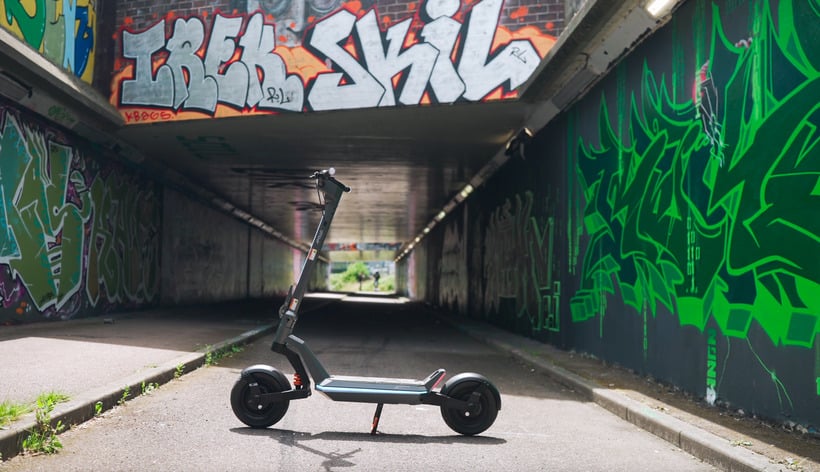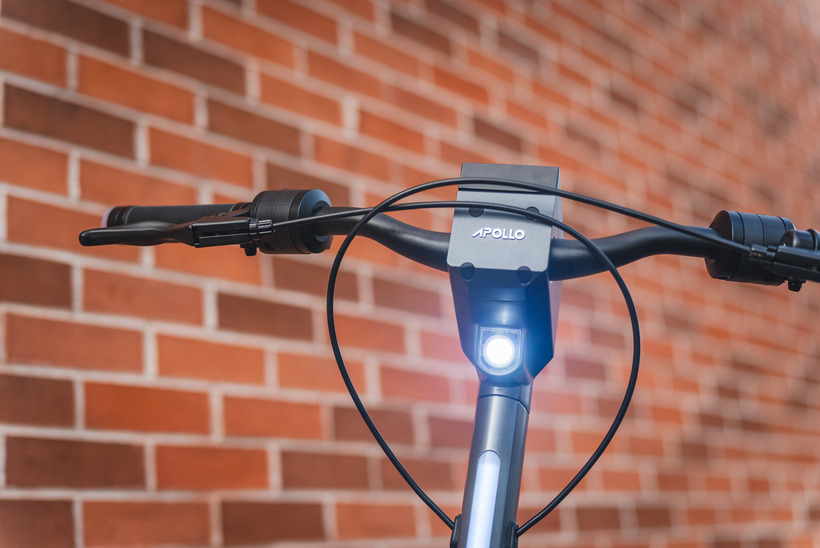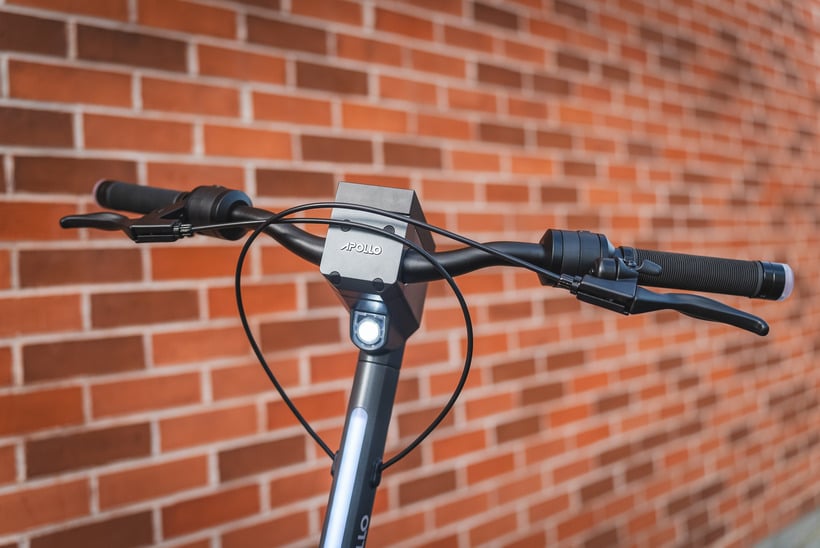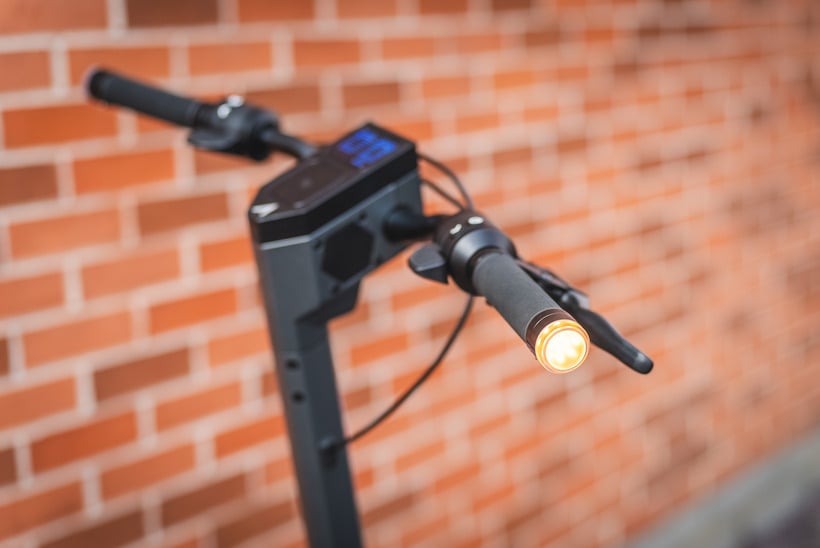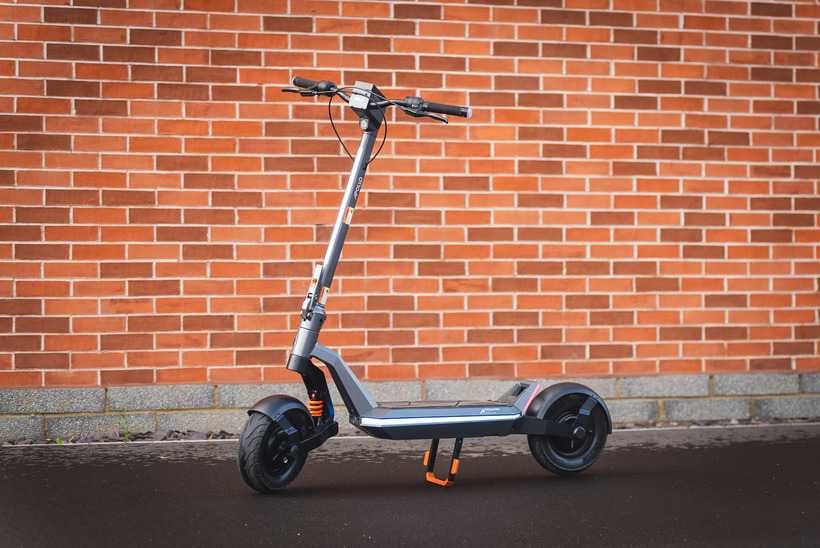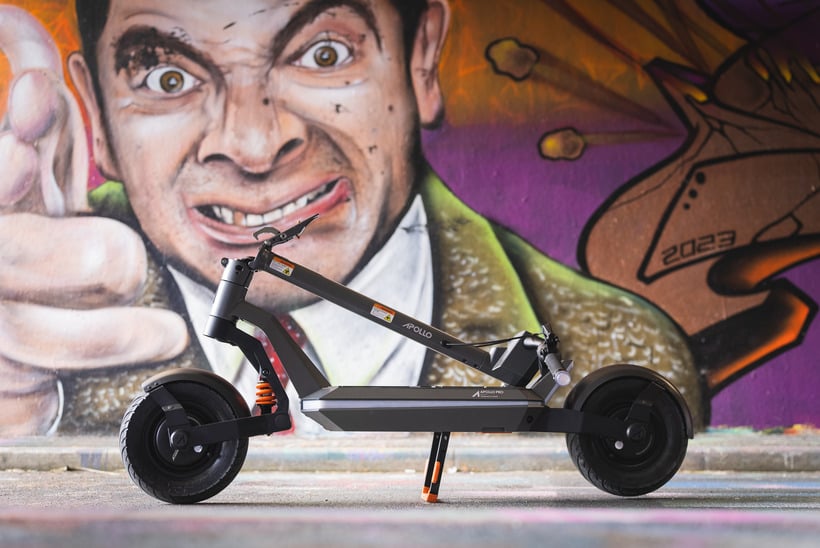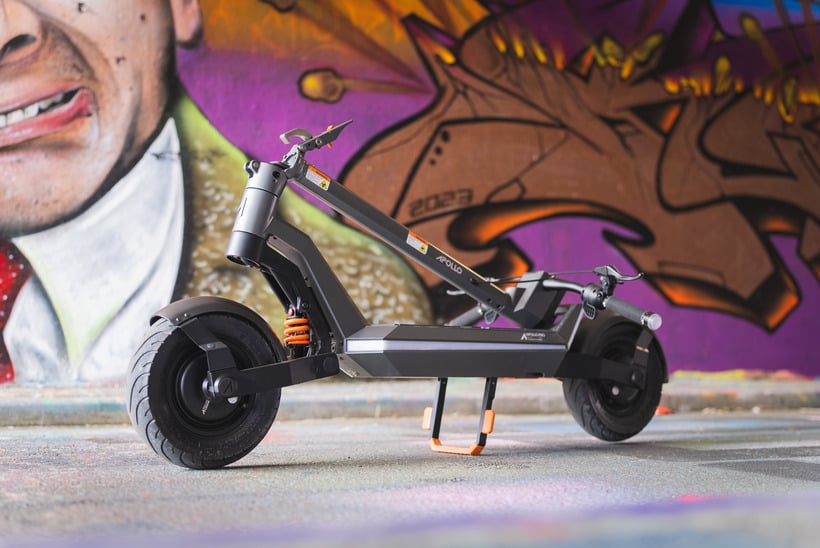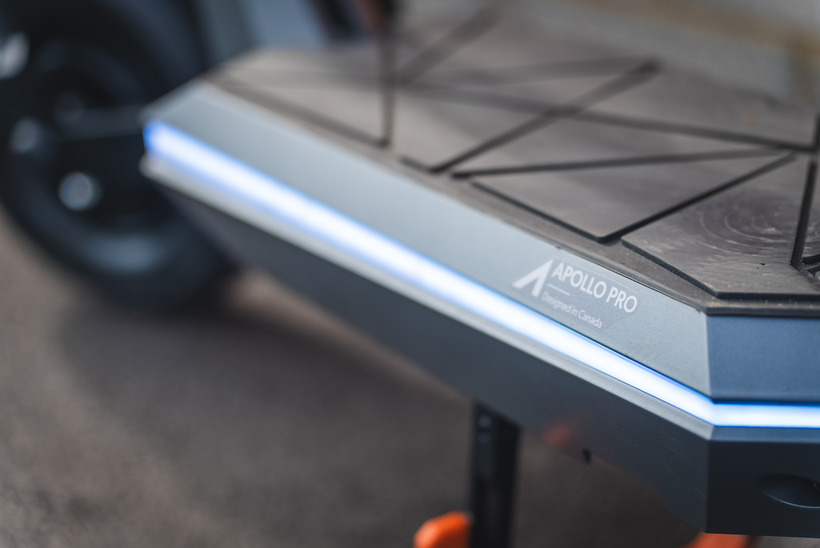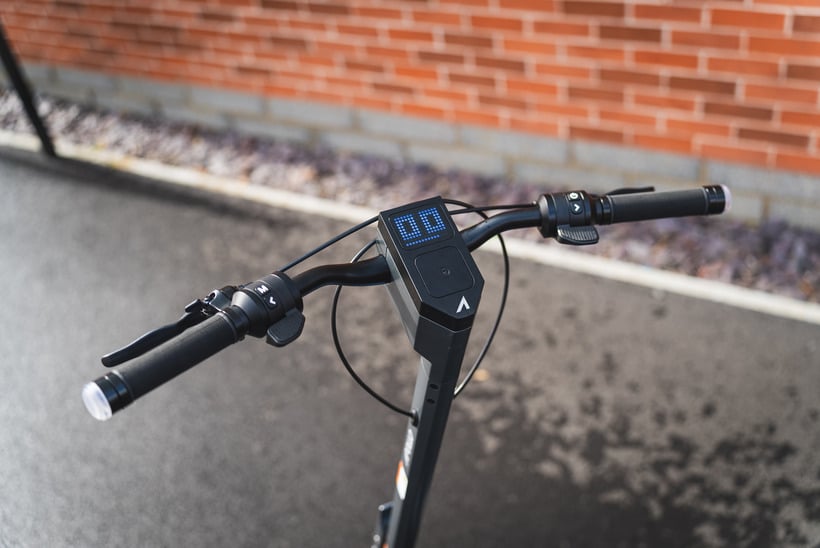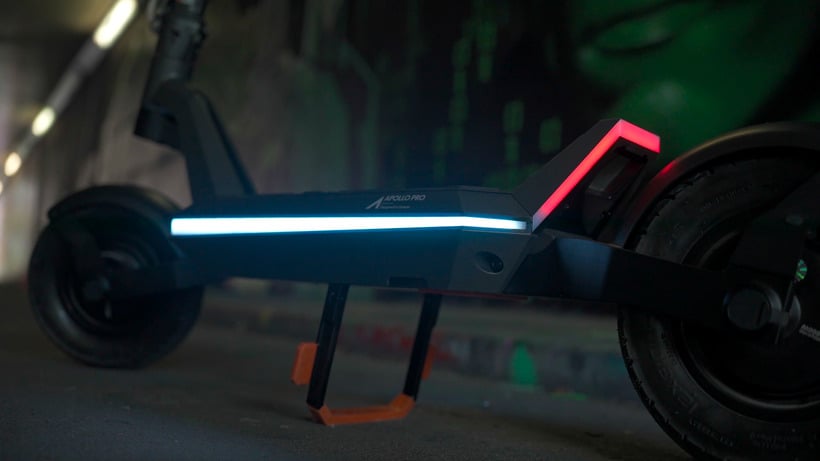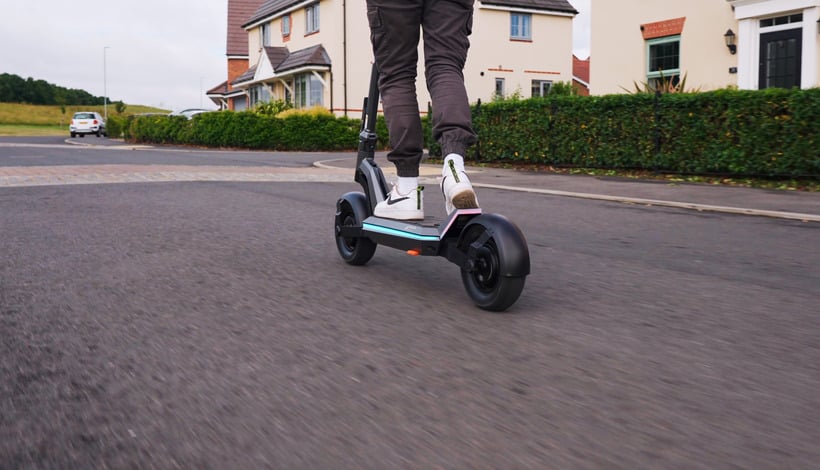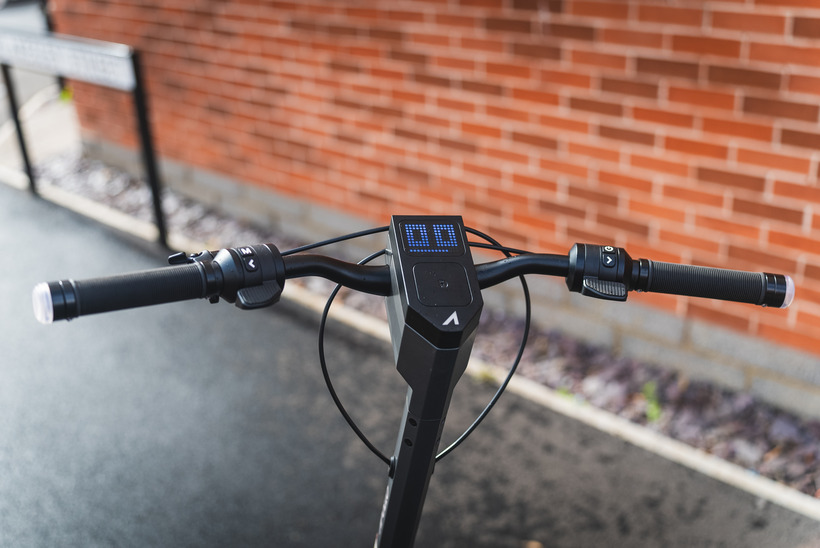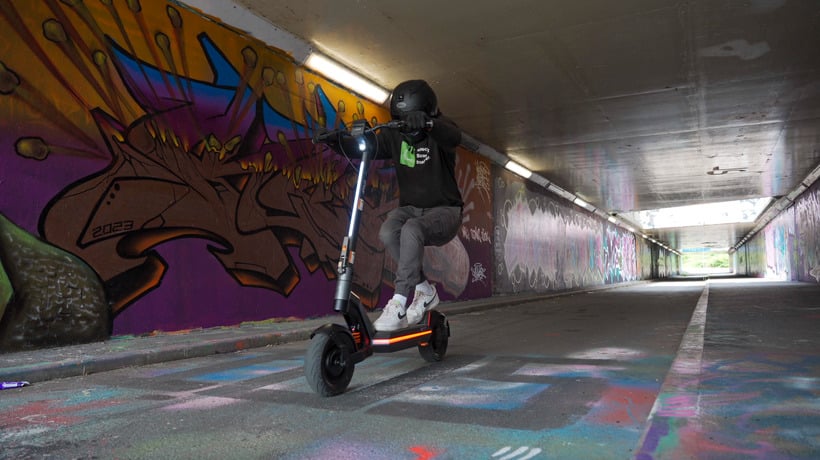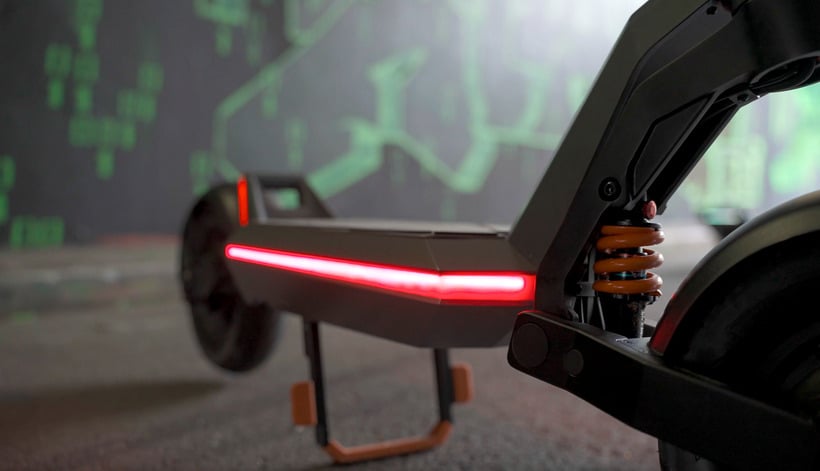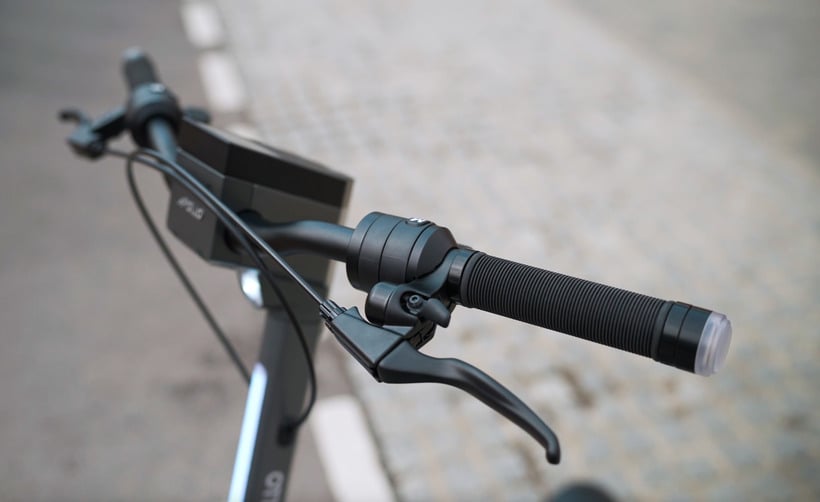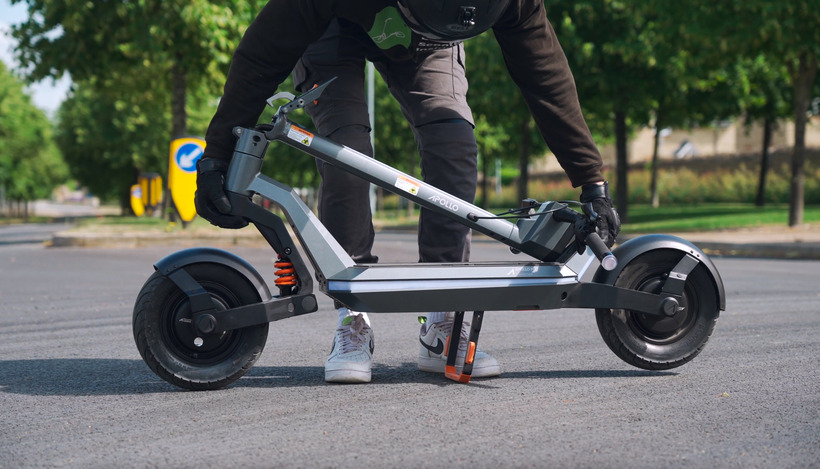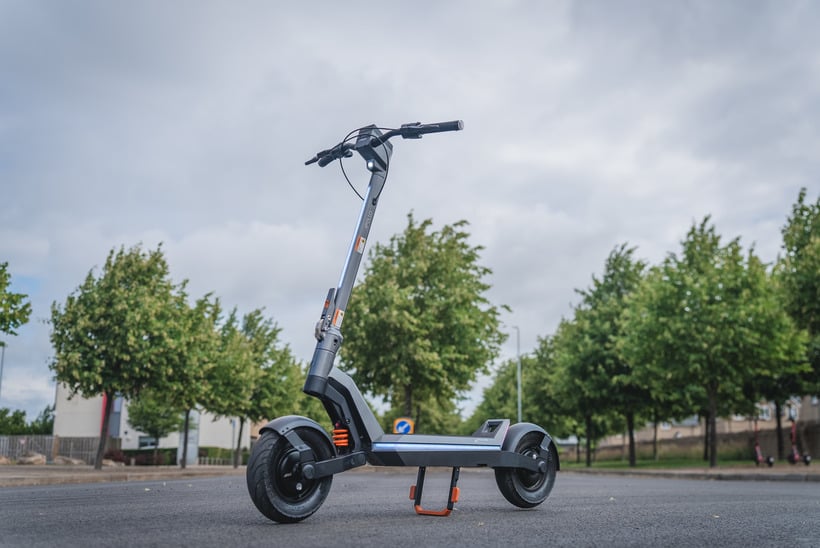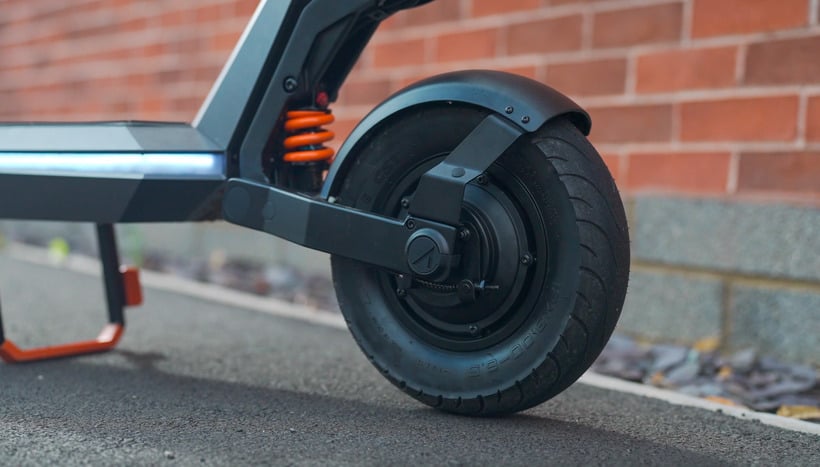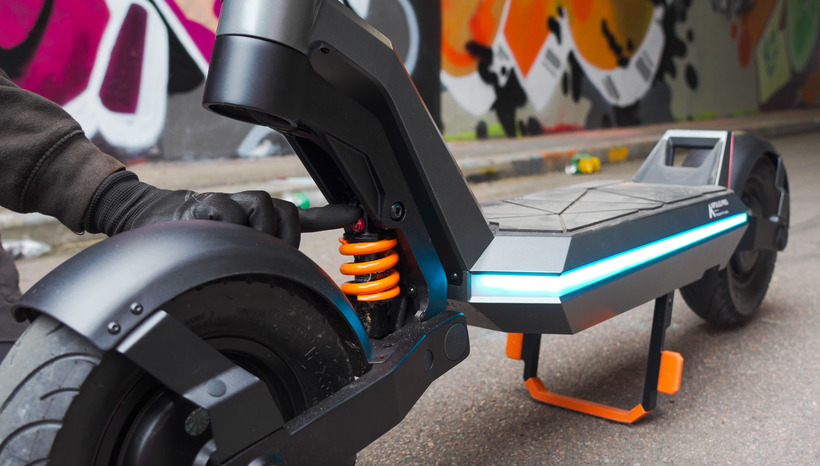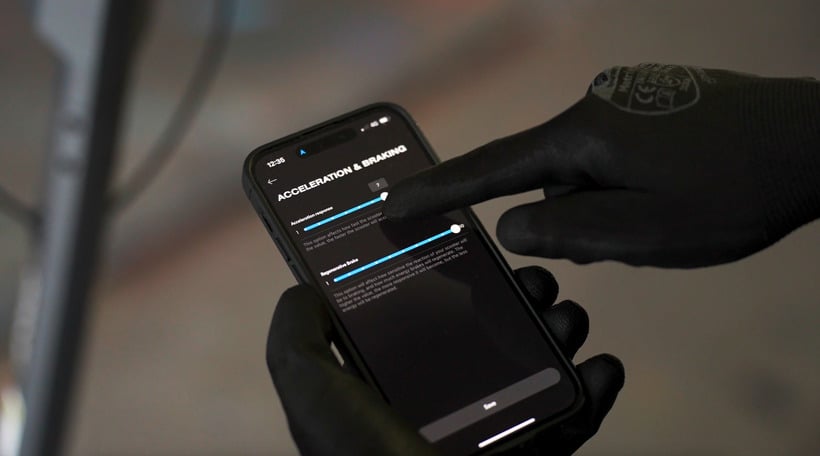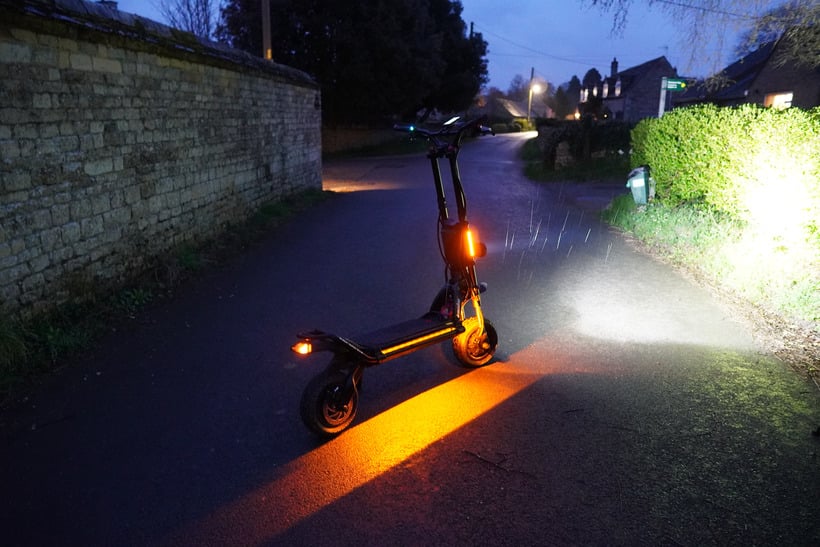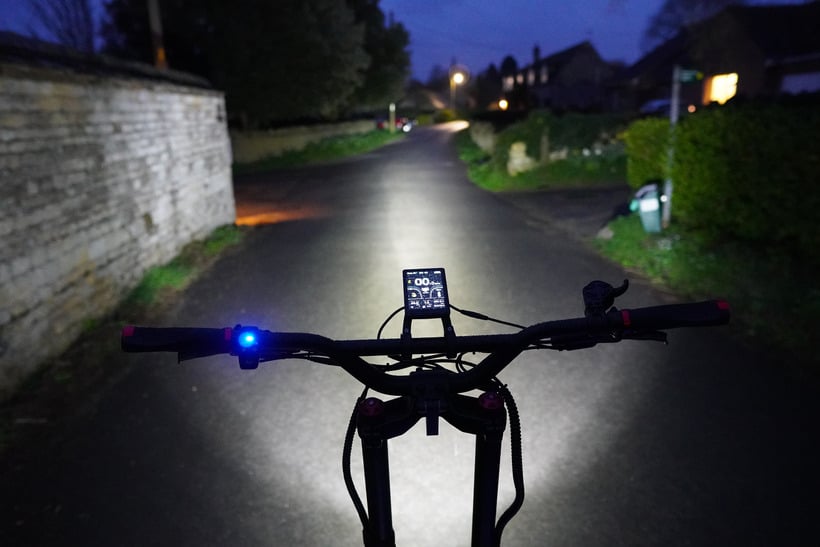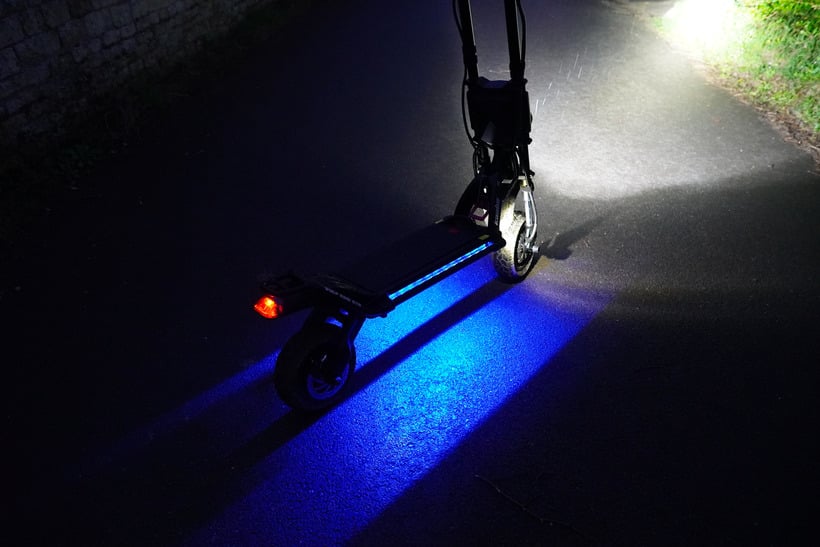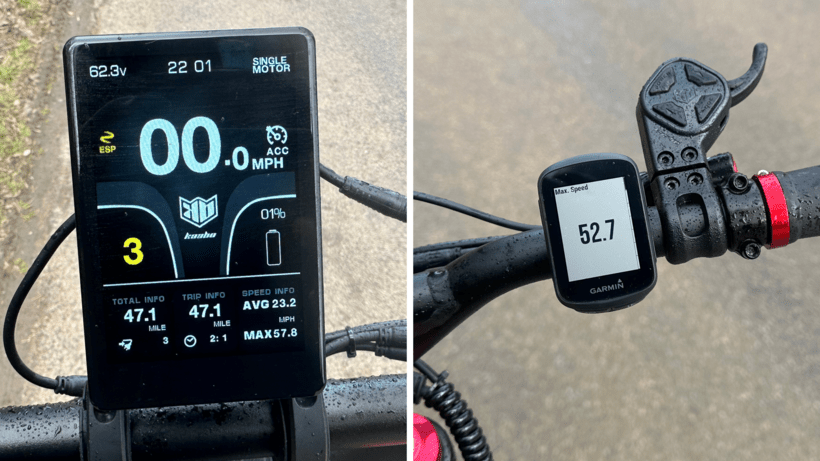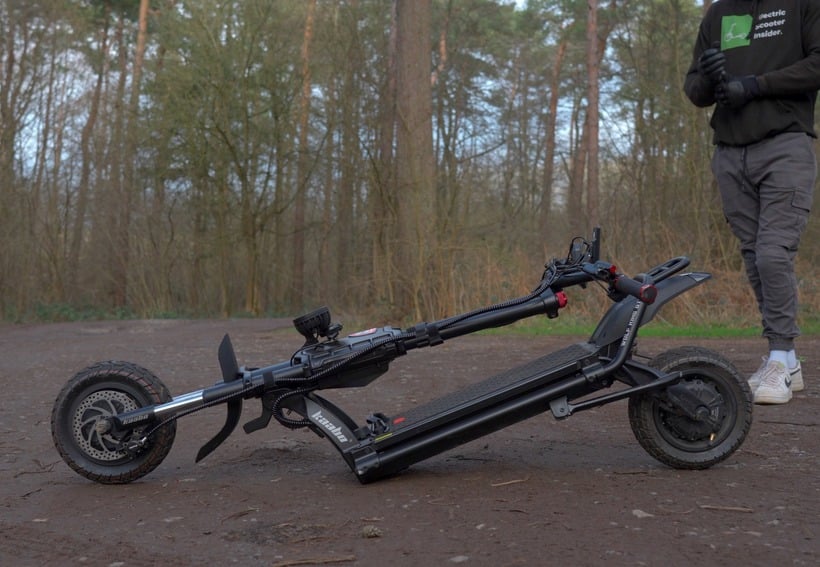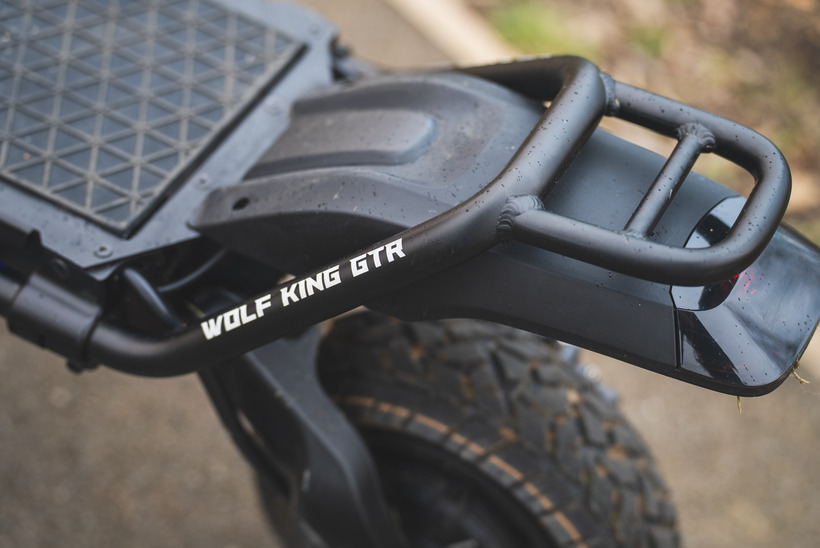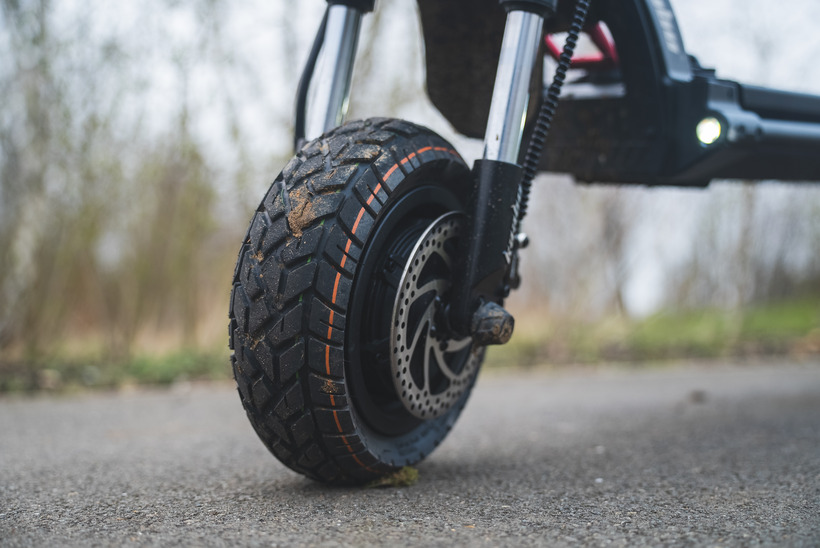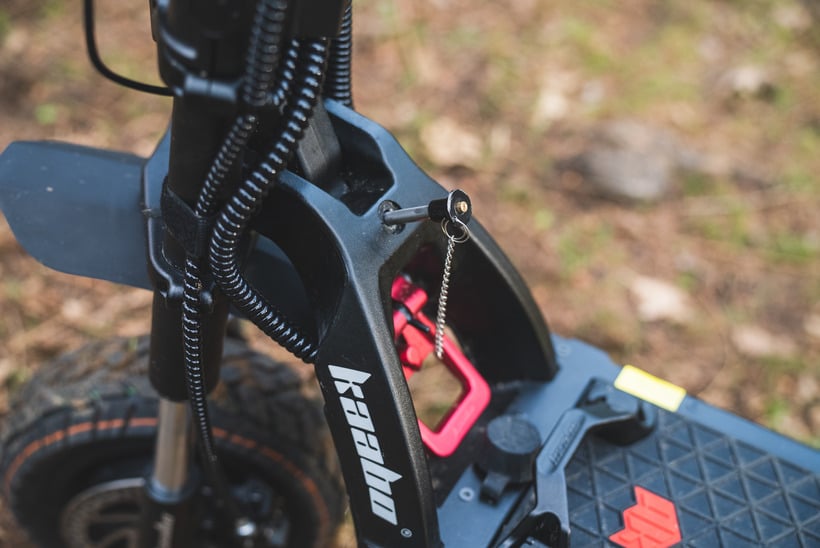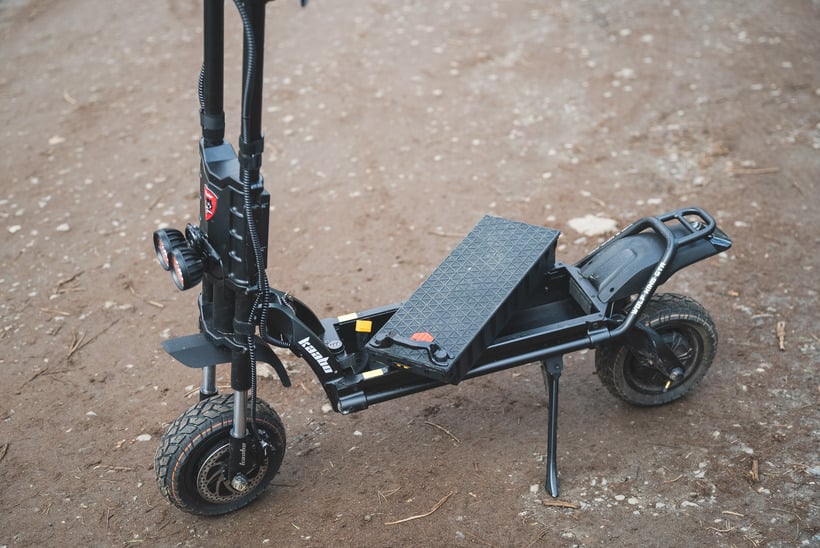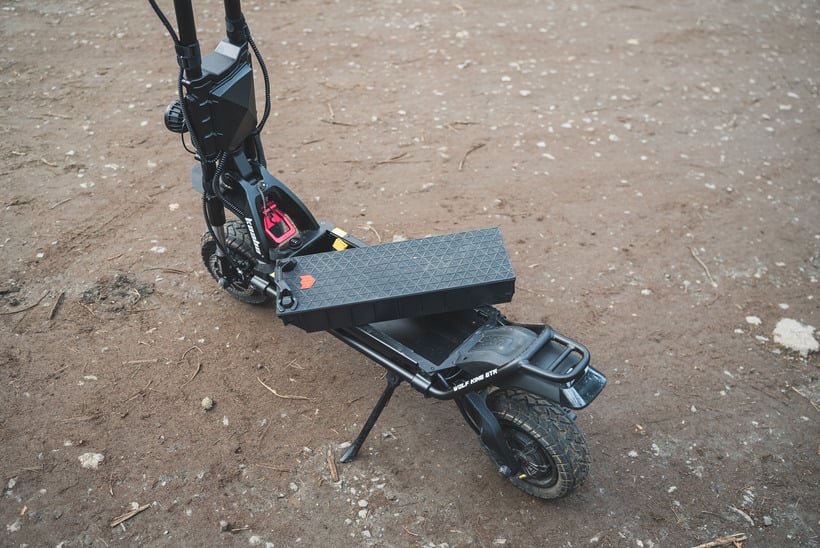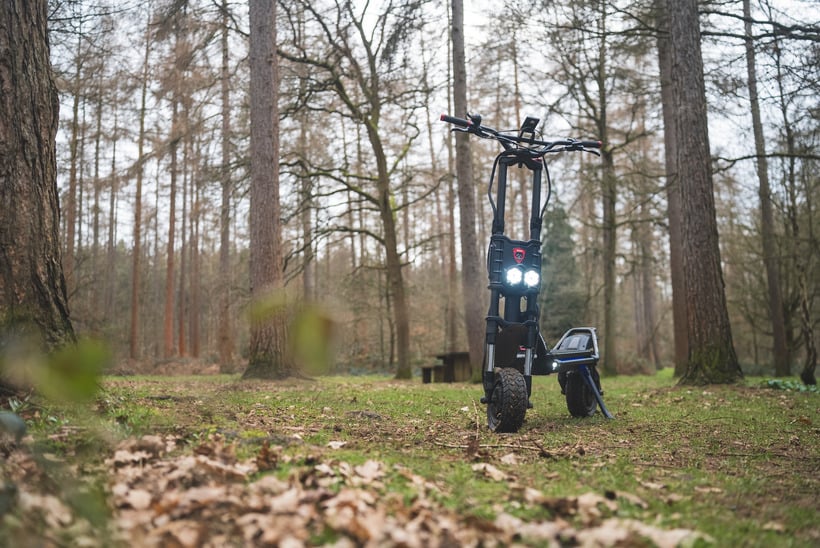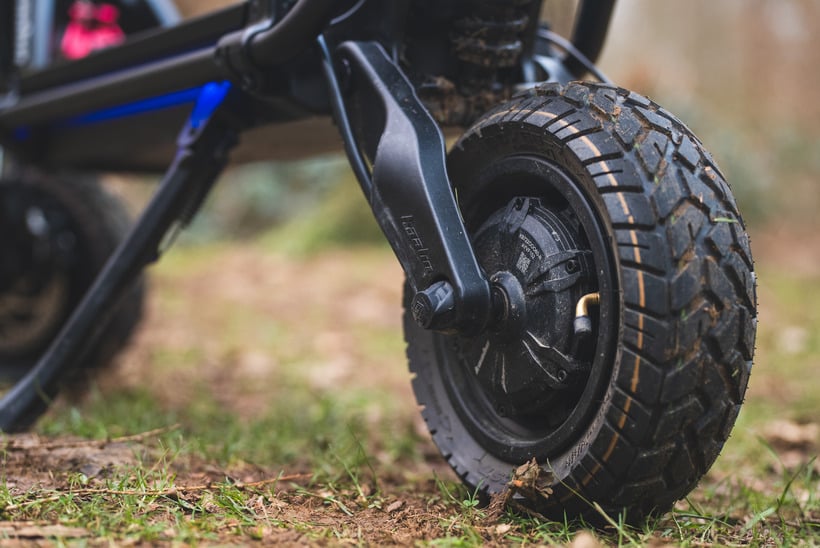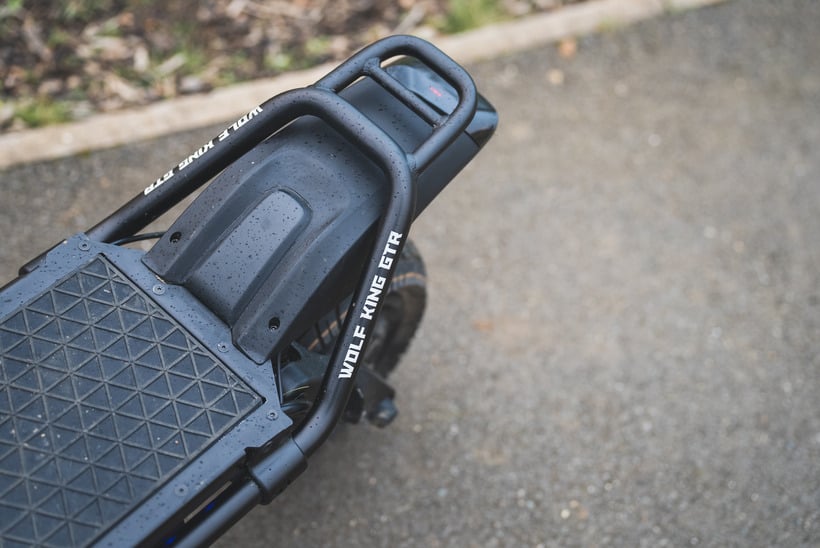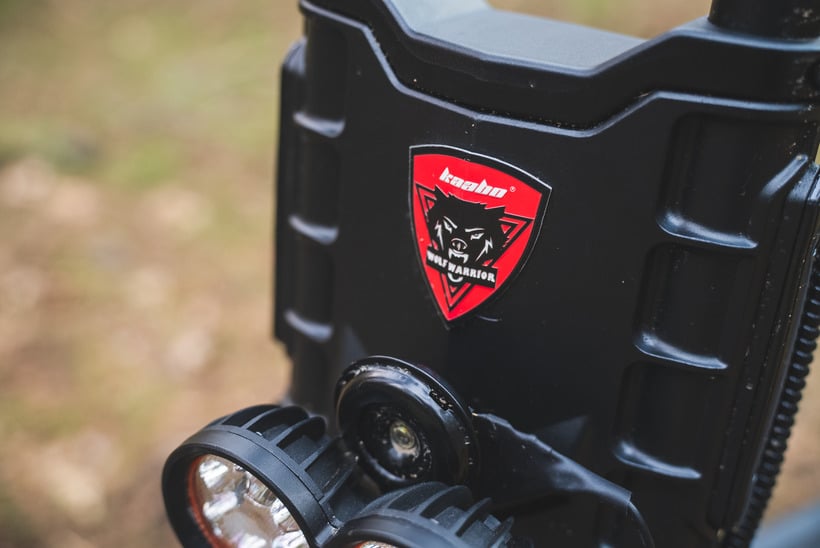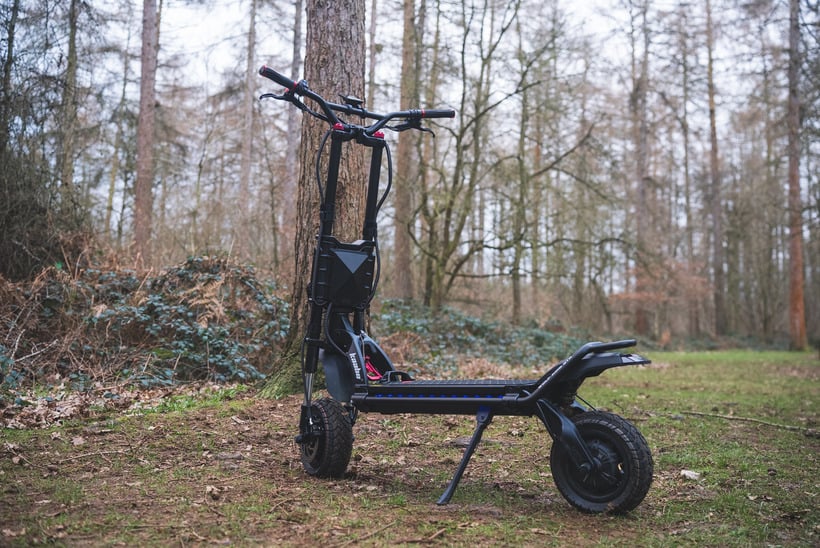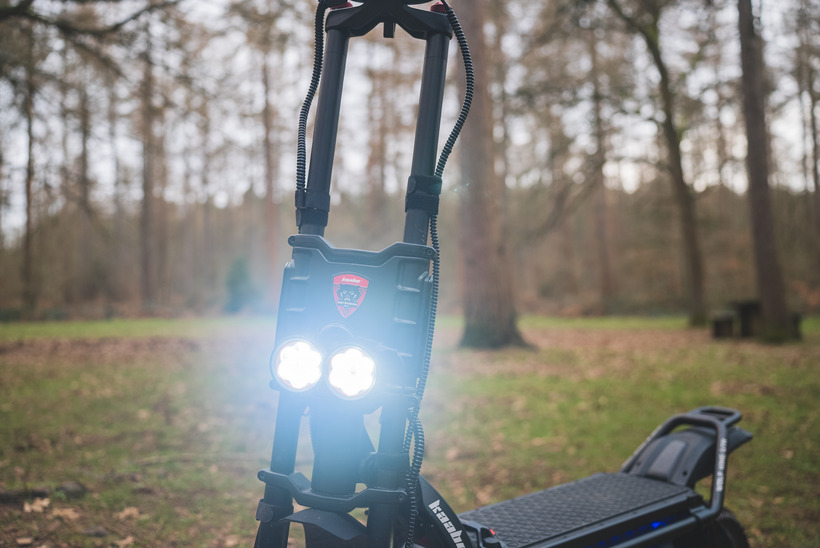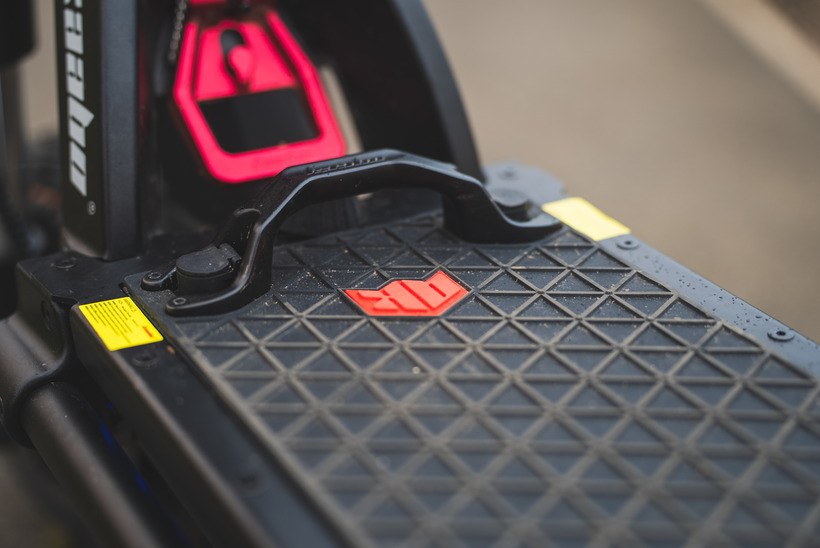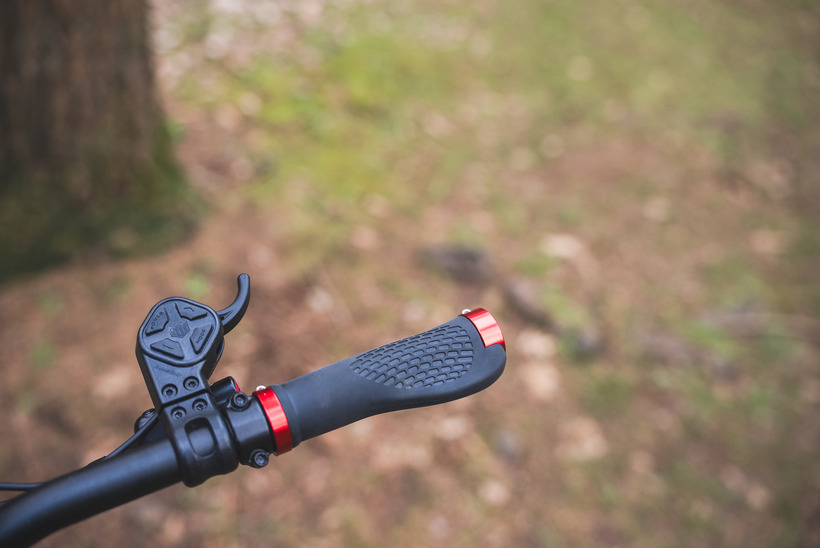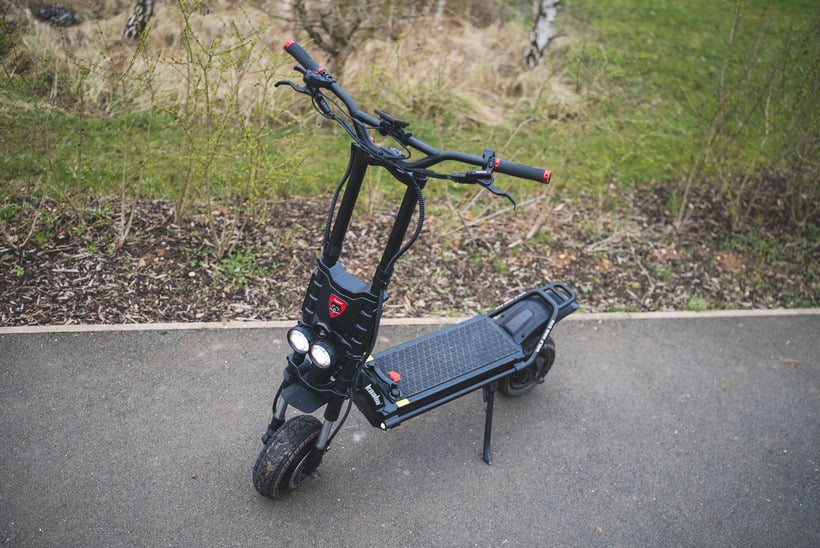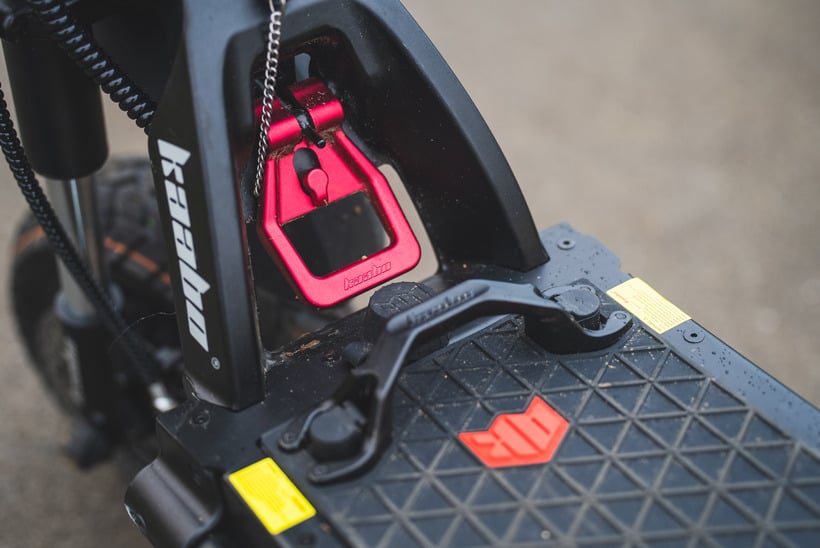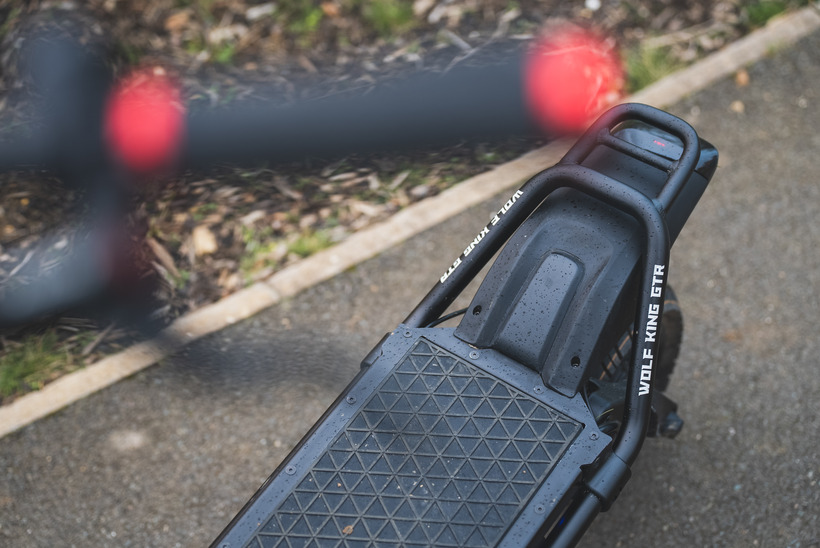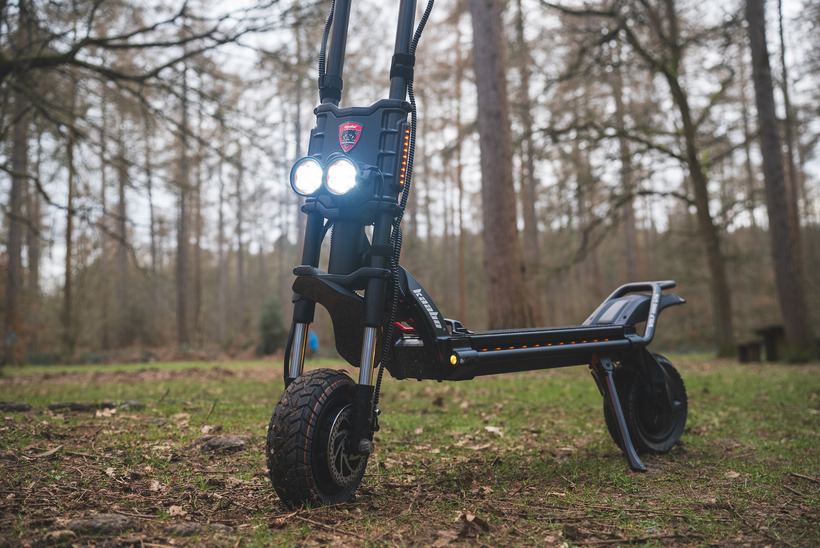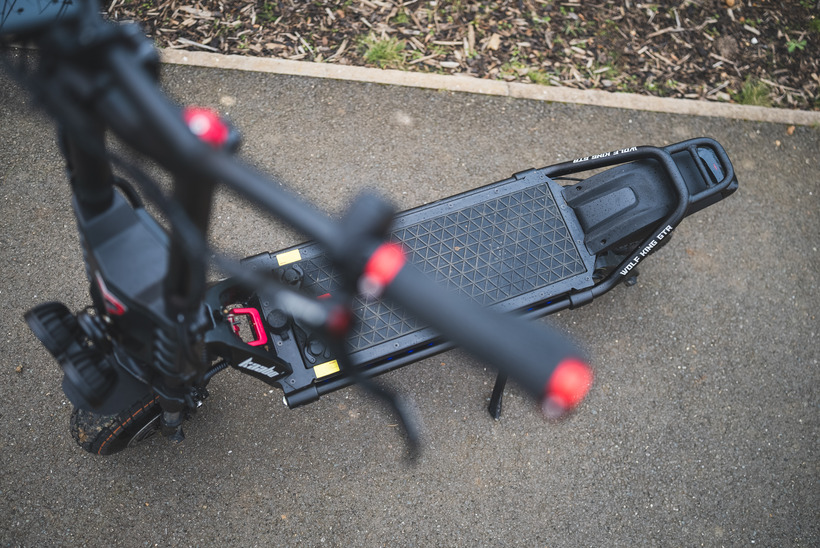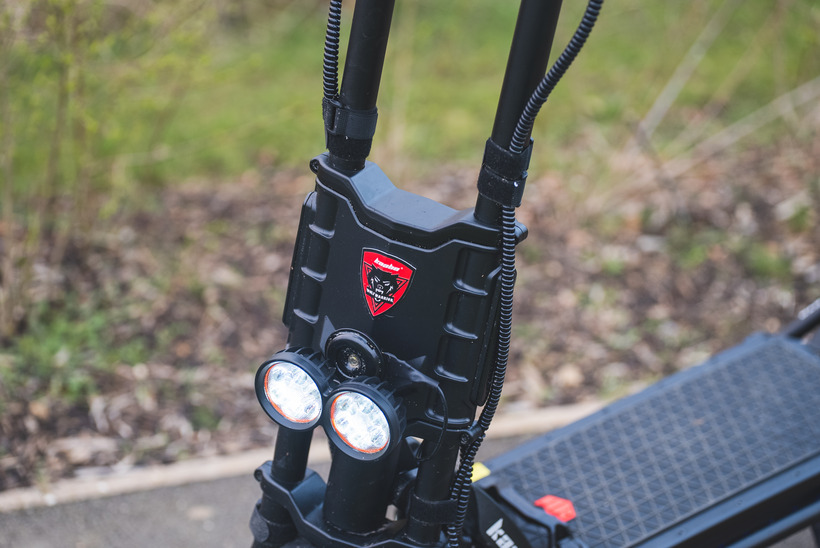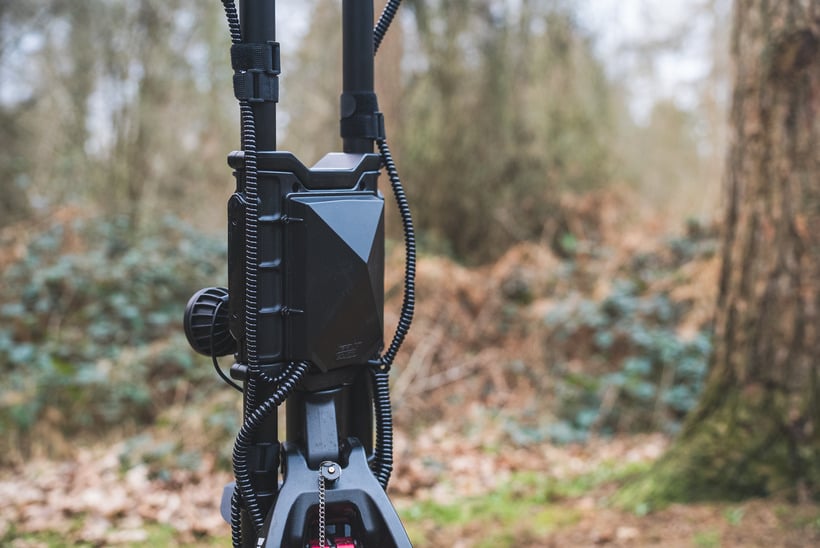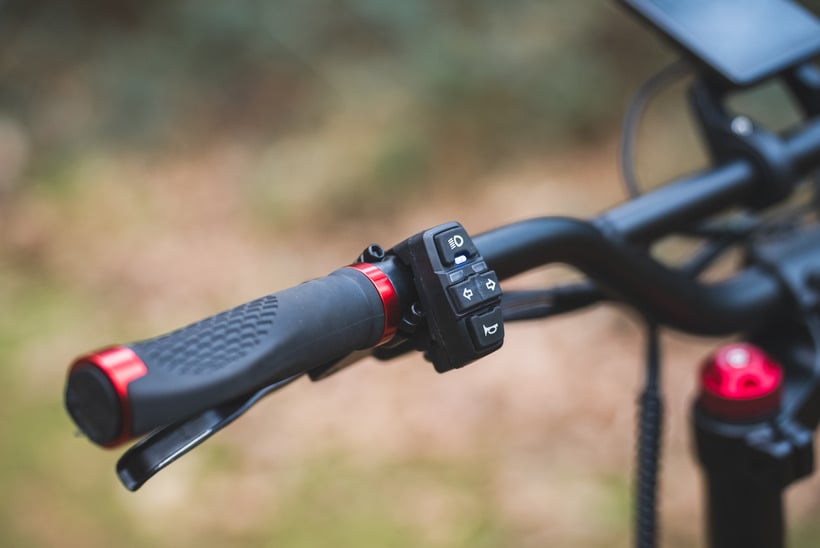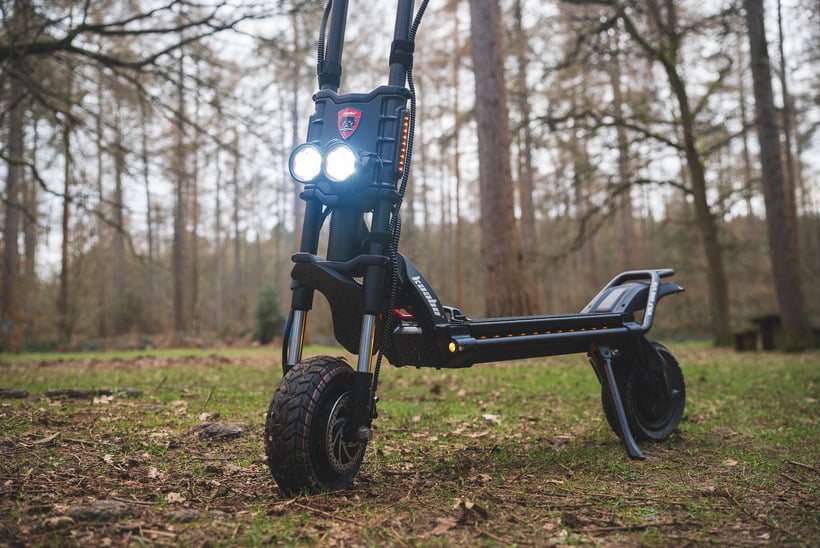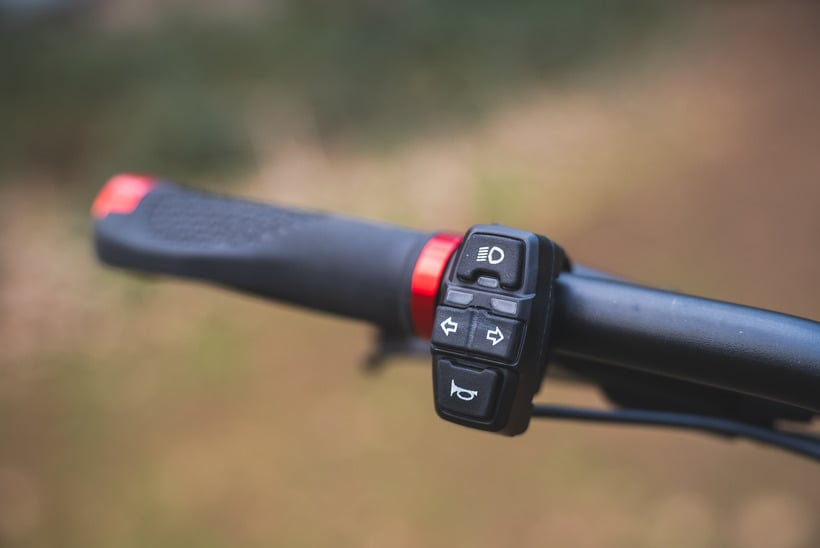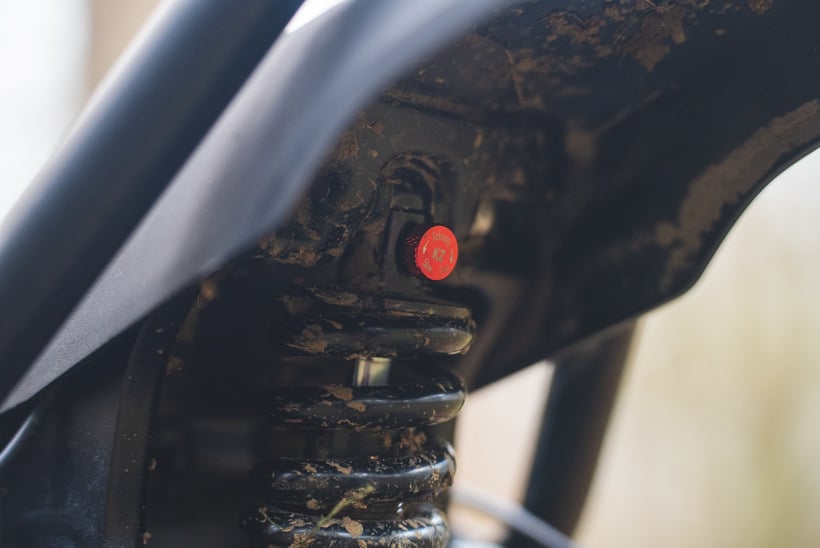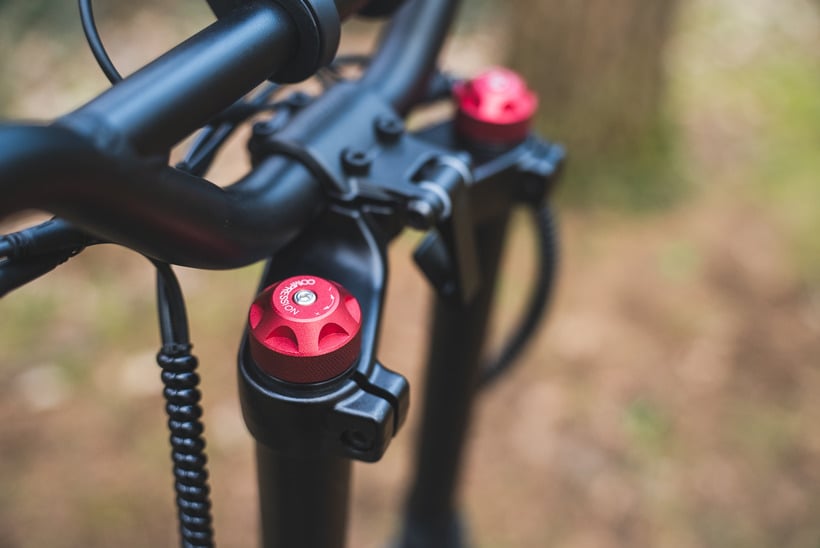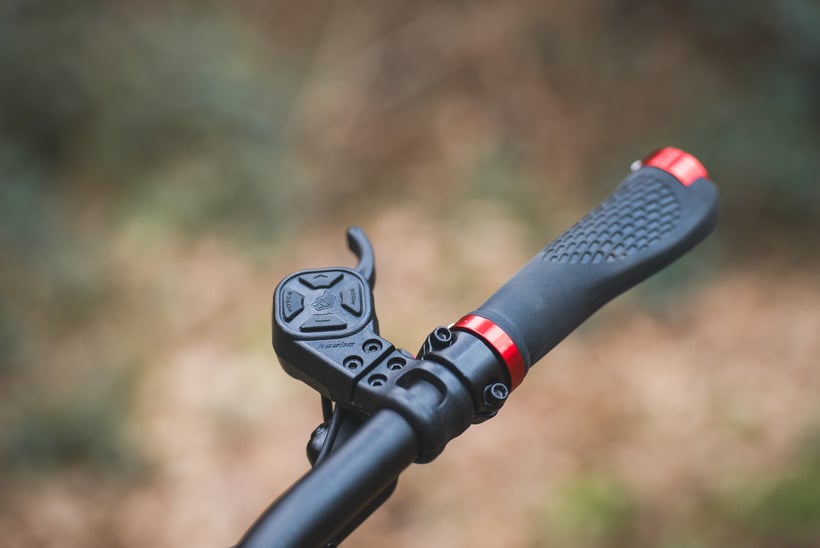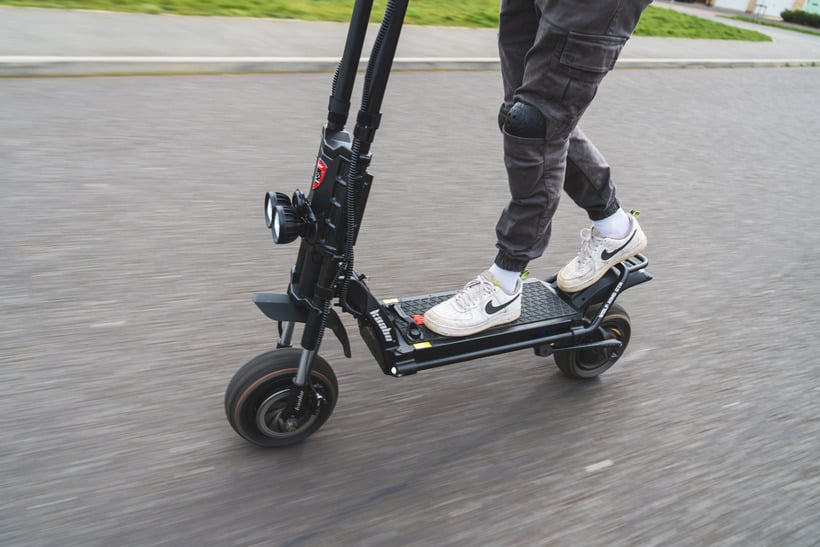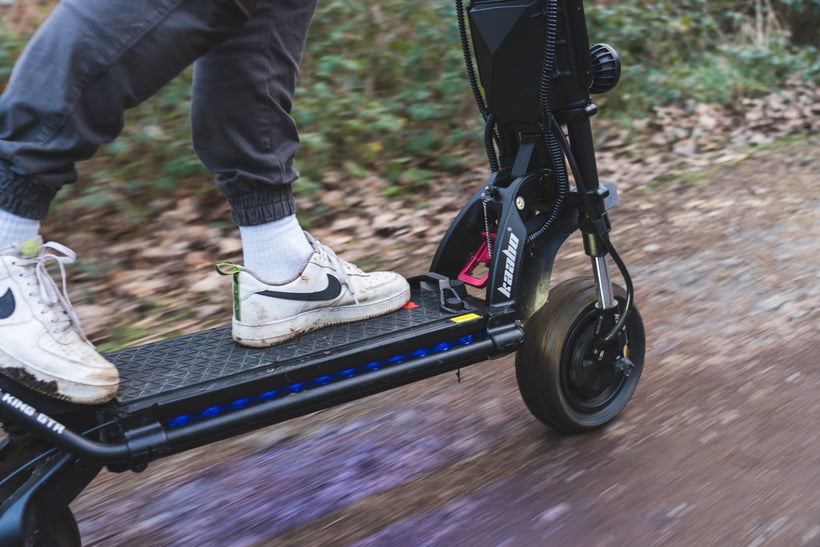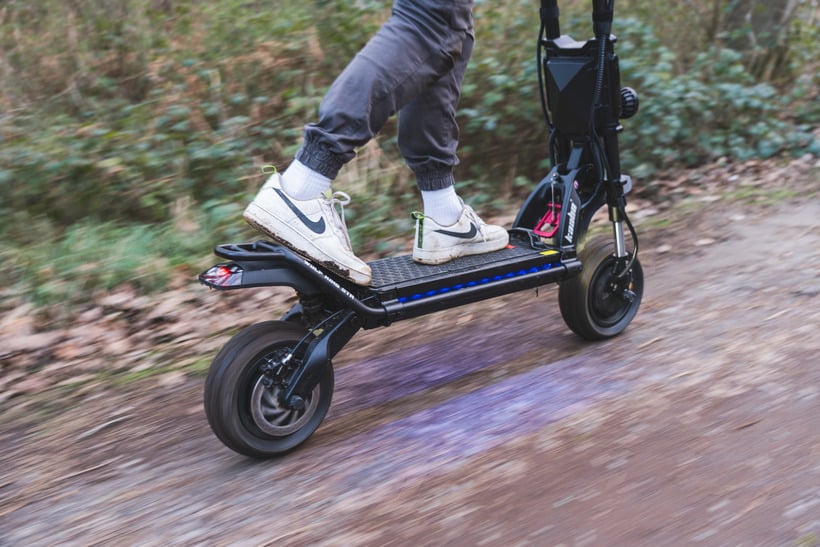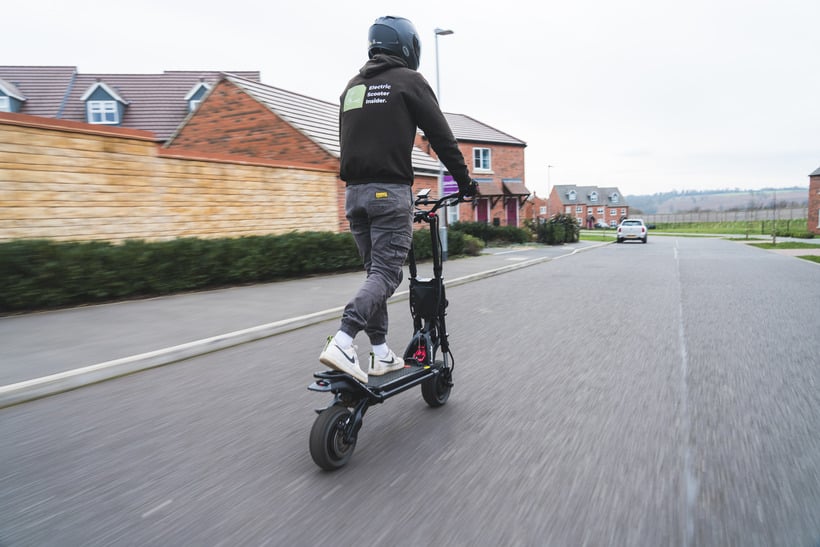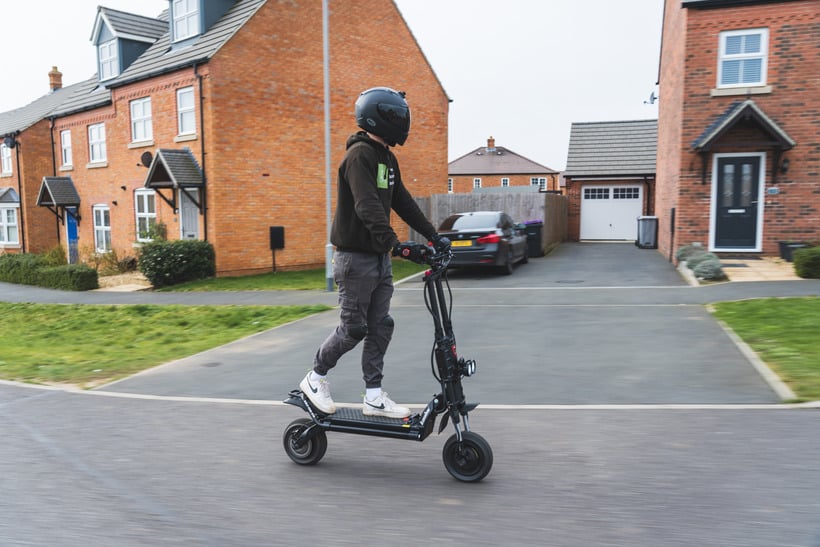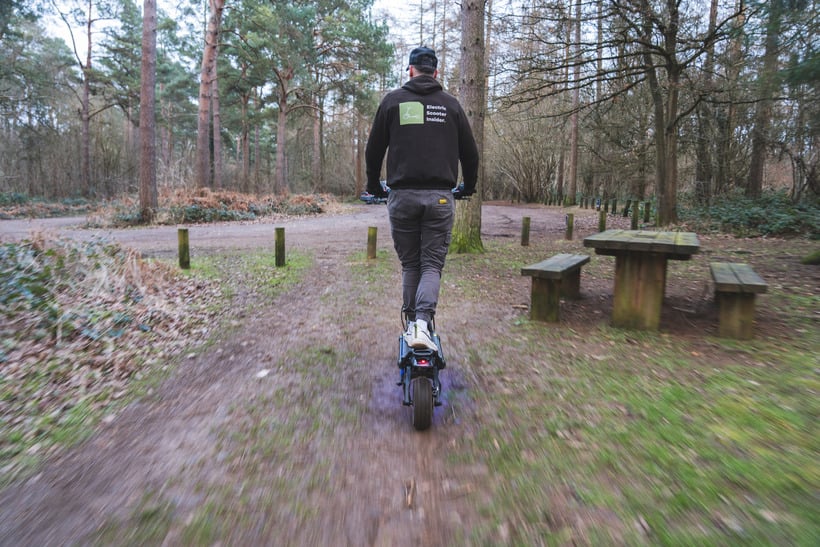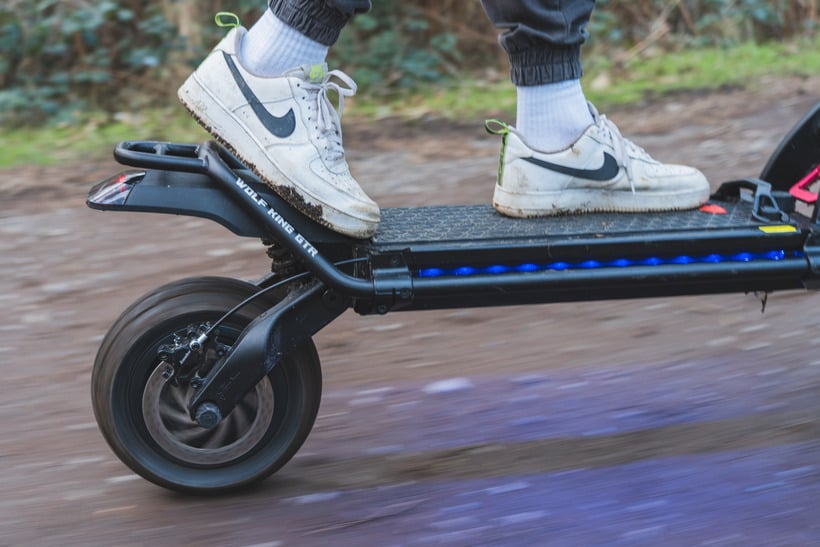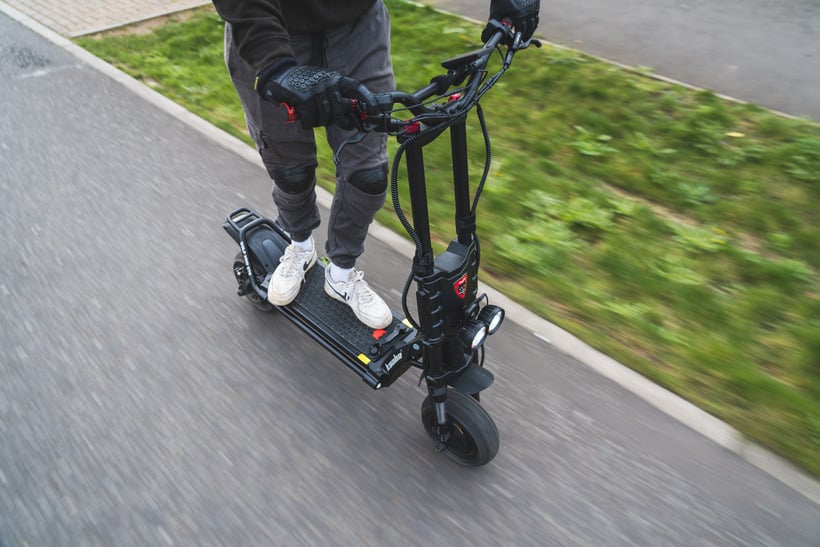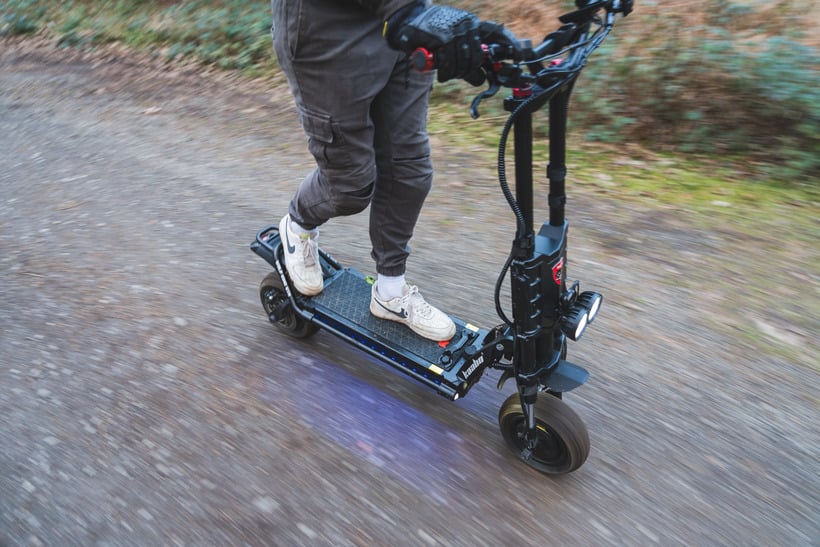Quick List: Best Electric Scooters 2025
I tested 72 electric scooters to find the 12 best models.
- VMAX VX5 Pro GT – Best Budget
- VMAX VX2 Pro GT – Best Under $1,000
- SPLACH Mukuta – Best Solid Tire & Low Maintenance
- VMAX VX4 GT – Best Long-Range & Heavy Rider
- Apollo Go – Best Entry-Level Dual Motor, All-Weather & Most Reliable
- Apollo City Pro – Best Dual-Motor Commuter
- Mantis King GT – Best All-Around Dual-Motor, Hill Climber & Off-Roader
- Apollo Phantom – Best Road Racer
- EMOVE RoadRunner Pro – Best Seated
- Apollo Pro – Best Tech Integration
- Wolf King GTR – Best Extreme Speed
Best Electric Scooters
Best Budget

VMAX VX5 Pro GT
Performance Report
Performance Report:
Tester: Josh Frisby (197 lbs, 6.1 ft)
- Top Speed: 18 mph
- Real Speed: 17.4 mph*
- 0-15 mph: 6.7 s*
- Max Range: 22 miles
- Real Range: 19 miles*
- Braking: 2.0 meters*
- Suspension: n/a
- Max Incline: 14 degrees
- Optimal Incline: 8 degrees*
- Weight: 36.8 lbs
- Load: 265 lbs
Pros & Cons
The Good:
- Competitive performance profile
- 11% faster acceleration compared to the average of its rivals
- Shortest stopping distance among its rivals
- Best design and build in its price class
- Wider than normal handlebars promote good handling
- Regenerative braking system recycles kinetic energy to recharge the battery on the go
- High quality UL2272-certified battery
- Grippy and nimble 8.5-inch tubed tires
- Immaculate cable management
- Mobile app allows for customized performance
- Slick folding mechanism
- 40.2-inch deck-to-handlebar height makes it suitable for tall riders up to 6’3”
- Protective IPX6 water-resistance rating
- Long fenders that prevent splashback
- Quiet motor
- Low maintenance
- 2-year warranty
The Bad:
- Display gets washed out in direct light
- The taillight is bright at night, but it doesn’t flash when you brake - it just glows a brighter red
Video Review
Best Under $1,000

VMAX VX2 Pro GT
Performance Report
Performance Report:
Tester: Josh Frisby (190 lbs, 6.1 ft)
- Top Speed: 24 mph
- Real Speed: 24.5 mph*
- 0-15 mph: 3.8 s*
- Max Range: 37 miles
- Real Range: 30.6 miles*
- Braking: 3.0 meters*
- Suspension: n/a
- Max Incline: 15 degrees
- Optimal Incline: 9 degrees*
- Weight: 45 lbs
- Load: 287 lbs
Pros & Cons
The Good:
- Longest tested range in the sub-$1,000 class
- Fastest acceleration among similarly priced single-motor scooters
- Strong brakes that use a regenerative system to recycle kinetic energy to recharge the battery on the go
- Exceptionally quiet motor
- Impeccable build quality
- Nimble tubeless tires
- Suitable for tall and heavy riders
- Bright lights with excellent turn signals that are visible from the front, rear, and sides
- Mobile app allows for customized performance
- Slick folding mechanism
- Tidy cable management
- Protective IPX6 water-resistance rating
- Long fenders that prevent splashback
- Low maintenance
- 2-year warranty
The Bad:
- Doesn’t have suspension
- Display gets washed out in direct light
- The taillight is bright at night, but it doesn’t flash when you brake - it just glows a brighter red
Video Review
Best Solid Tire & Low Maintenace
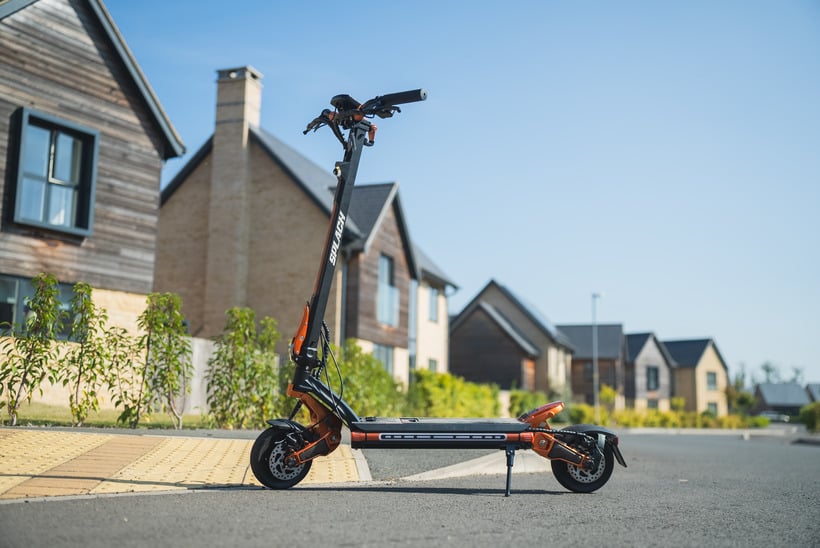
SPLACH Mukuta
Performance Report
Performance Report:
Tester: Josh Frisby (190 lbs, 6.1 ft)
- Top Speed: 28 mph
- Real Speed: 27 mph*
- 0-15 mph: 2.7 s*
- 0-25 mph: 6.7 s*
- Max Range: 39 miles
- Real Range: 22 miles*
- Braking: 2.1 meters*
- Suspension: 6.5/10*
- Max Incline: 22 degrees
- Optimal Incline: 13 degrees*
- Weight: 66 lbs
- Load: 265 lbs
Pros & Cons
The Good:
- Top contender for the best solid tire electric scooter
- Highly competitive performance profile in its price class
- It offers dual motor performance on a budget
- Detachable battery that doubles as a power bank
- Bright headlight and a strong cast of supporting stem, deck, and turn signal LEDs
- NFC security system
- Puncture-proof tires
- Ergonomic cockpit that’s similar to the vastly more expensive Segway GT2
- Rock solid with no rattling or stem wobble
- Foldable handlebars make it compact
- Adjustable front and rear suspension
- Low maintenance
- IP54 water-resistance rating
The Bad:
- The chrome plastic cockpit controls are tacky
- The toggles to select the riding mode and engage the turn signals would be better if they gave more feedback (i.e more clicky)
- The plastic casing of the stem and deck lights feels a little cheap
- The profile of the tires prevents aggressive cornering
- The hook on the back of the handlebars doesn’t lock to the kickplate, making it difficult to maneuver when folded
- While the turn signals are exceptionally bright, they can’t be seen from the front or rear during the day
- Brake lights only glow brighter, instead of flashing
Video Review
Photos
Best Long-Range & Heavy Rider

VMAX VX4 GT
Performance Report
Performance Report:
Tester: Josh Frisby (197 lbs, 6.1 ft)
- Top Speed: 25 mph
- Real Speed: 25.8 mph*
- 0-15 mph: 3.2 s*
- 0-25 mph: 9.6 s*
- Max Range: 62 miles
- Real Range: 36.7 miles*
- Braking: 3.4 meters*
- Suspension: 6.5/10*
- Max Incline: 18 degrees
- Optimal Incline: 11 degrees*
- Weight: 63.9 lbs
- Load: 330 lbs
Pros & Cons
The Good:
- Long real-world tested range
- Zippy acceleration
- Quiet motor
- Smooth front and rear suspension
- Versatile hybrid tubeless tires
- Great handling
- Excellent build quality
- Regenerative braking system that recycles kinetic energy to recharge the battery on the go
- Immaculate cable management
- Spacious dimensions
- Suitable for tall and heavy riders (up to 6’4” and 330 lbs)
- Bright turn signals ensure 360-degree visibility
- Display remains visible under direct sunlight
- Long fenders prevent splashback
- Protective IPX6 water-resistance rating
- Low maintenance
- 2-year warranty
The Bad:
- While the folding lever is simple to operate, the same can’t be said for how the latch on the back of the handlebars hooks to the kickplate. It’s difficult to connect the two, and they have a habit of becoming unhooked. This makes the scooter cumbersome to maneuver when folded
- Installing the handlebars is fiddly - there was a lot of extra slack in the thick wires and a very narrow hole to stick them through
- The button pad to control the settings, turn signals, and riding modes is well positioned but would benefit from a more responsive design - with gloves on it was hard to tell if I had pressed the turn signal or riding mode button
- The taillight is bright at night, but it doesn’t flash when you brake - it just glows a brighter red
Video Review
Best Entry-Level Dual Motor, All-Weather & Most Reliable

Apollo Go
Performance Report
Performance Report:
Tester: Josh Frisby (197 lbs, 6.1 ft)
- Top Speed: 28 mph
- Real Speed: 25.5 mph*
- 0-15 mph: 3.8 s*
- Max Range: 30 miles
- Real Range: 17.6 miles*
- Braking: 3.1 meters*
- Suspension: 6/10*
- Max Incline: 25 degrees
- Optimal Incline: 12 degrees*
- Weight: 46 lbs
- Load: 265 lbs
Pros & Cons
The Good:
- Ultra-sleek design
- Premium build quality
- Packed full of useful features
- Cybertruck-inspired lights
- Handlebar integrated turn signals
- Well-designed geometry delivers intuitive control and handling
- Best-in-class cockpit ergonomics
- DOT Matrix display is extremely bright and easy to read from any angle
- Comes with a free QuadLock phone case accessory (saving you $30)
- Integrated mobile app for customized performance
- Stable and nimble thanks to its 14-degree rake angle
- Reliable self-healing tires
- A regenerative braking system recycles kinetic energy to recharge the battery by up to 10%
- A 40-inch deck-to-handlebar height and 265 lb load-bearing capacity make it well-suited to tall and heavy riders
- Impeccable cable management
- Extremely low maintenance
- Battery management system ensures long-term health
- Protective IP66 water-resistance rating
The Bad:
- The plastic caps that encapsulate the turn signals are prone to damage
- The taillight is dim during the day
- The clip-in, clip-out folding hook system is a little fiddly
- The handlebars are slightly narrow
Video Review
Photos
Best Dual-Motor Commuter

Apollo City Pro
Performance Report
Performance Report:
Tester: Josh Frisby (190 lbs, 6.1 ft)
- Top Speed: 32 mph
- Real Speed: 31.2 mph*
- 0-15 mph: 2.3 s*
- 0-25 mph: 6.1 s*
- Max Range: 43 miles
- Real Range: 27 miles*
- Braking: 2.1 meters*
- Suspension: 7.5/10*
- Max Incline: 20 degrees
- Optimal Incline: 13 degrees*
- Weight: 65 lbs
- Load: 265 lbs
Pros & Cons
The Good:
- Competitive performance profile
- Fast acceleration
- Smooth power delivery
- Sublime handling
- Sleek aesthetic
- Feature-rich
- Proprietary design ensures top-class build quality
- Tubeless, self-healing tires
- Shock-absorbing triple spring suspension
- Regen brake recharges the battery by up to 10%
- Intuitive folding mechanism
- Good lighting setup with the best turn signals that I’ve tested
- Battery management system ensures long-term performance
- Integrated mobile app for customized performance
- Fast charging
- 10,000 km warranty
- Low maintenance
- Suitable for tall and heavy riders
- High IP66 water-resistance rating
The Bad:
- The display could be brighter
- Similarly priced models go faster, but the Apollo City Pro’s overall package is superior
Video Review
Photos
Best All-Around Dual-Motor, Hill Climber & Off-Roader
Performance Report
Performance Report:
Tester: Josh Frisby (190 lbs, 6.1 ft)
- Top Speed: 43 mph
- Real Speed: 45 mph*
- 0-15 mph: 1.9 s*
- 0-25 mph: 4.0 s*
- 0-30 mph: 5.7 s*
- 0-35 mph: 7.8 s*
- Max Range: 56 miles
- Real Range: 38 miles*
- Braking: 2.1 meters*
- Suspension: 9/10*
- Max Incline: 30 degrees
- Optimal Incline: 18 degrees*
- Weight: 79 lbs
- Load: 265 lbs
Pros & Cons
The Good:
- Best-in-class performance
- Industry-leading design
- Exceptional build and ride quality
- 30A Sine Wave controllers deliver a smooth, fast acceleration
- High-quality Samsung battery
- Adjustable hydraulic suspension
- Terrain-agnostic tires
- Advanced TFT display
- Controllable LED lights
- Superb folding mechanism
- Wide handlebars and ergonomic controls afford excellent control
- Powerful hydraulic brakes
- IPX5 water-resistance rating
The Bad:
- Headlight could be brighter
Video Review
Best Road Racer
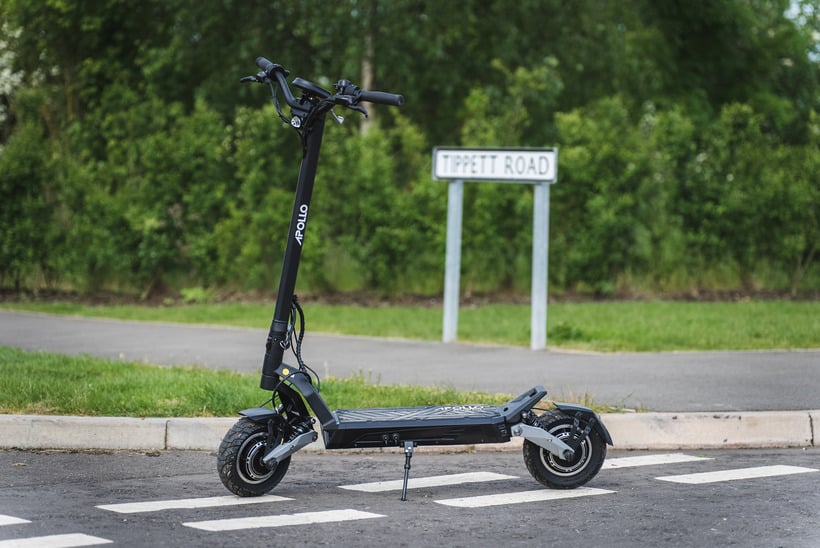
Apollo Phantom
Performance Report
Performance Report:
Tester: Josh Frisby (190 lbs, 6.1 ft)
- Top Speed: 41 mph
- Real Speed: 41 mph*
- 0-15 mph: 2.3 s*
- 0-25 mph: 4.5 s*
- 0-30 mph: 7.0 s*
- Max Range: 40 miles
- Real Range: 29 miles*
- Braking: 2.1 meters*
- Suspension: 7.5/10*
- Max Incline: 25 degrees
- Optimal Incline: 15 degrees*
- Weight: 77 lbs
- Load: 300 lbs
Pros & Cons
The Good:
- New MACH1 controller unleashes high performance
- Supremely smooth throttle response
- Rapid acceleration
- Ludo mode boosts torque and top speed
- First-ever performance scooter to feature a regenerative brake paddle
- Supreme handling
- Quadruple springs are perfectly calibrated
- Mobile app lets you customize performance settings
- Great for tall and heavy riders
- Ergonomic cockpit
- Excellent lighting rig
- Sharp and responsive hydraulic brakes
- IP54 water resistance rating
The Bad:
- The rubber that sits around the plastic casing of the regen and throttle paddles is poorly-fitted
- Similarly-priced scooters offer more raw power, but some don’t match up to Apollo’s end-to-end customer experience
Video Review
Photos
Best Seated

EMOVE RoadRunner Pro
Performance Report
Performance Report:
Tester: Josh Frisby (190 lbs, 6.1 ft)
- Top Speed: 50 mph
- Real Speed: 54 mph*
- 0-15 mph: 2.6 s*
- 0-25 mph: 4.3 s*
- 0-30 mph: 5.9 s*
- Max Range: 50 miles
- Real Range: 34 miles*
- Braking: 3.0 meters*
- Suspension: 8/10*
- Max Incline: 30 degrees
- Optimal Incline: 18 degrees*
- Weight: 114 lbs
- Load: 330 lbs
Pros & Cons
The Good:
- Most powerful seated electric scooter
- Plush memory foam seat that's 3.5 inches thick
- Long saddle ensures that you can find a comfortable riding position
- The seat's outer fabric is both wear and heat-resistant
- Ultra-wide handlebars adjust high, low, towards, and away from you
- Motorcycle-grade ride quality
- Addictive to cruise and corner on
- Twist-grip throttle
- Supremely comfortable seat
- Premium LG battery cells are long-lasting
- Removable battery enables a limitless range and easier charging
- Great value for money
- Feature-rich color display
- Exceptionally bright headlight
- Huge 14-inch tubeless tires offer stability and shock absorption
- Supports heavy riders
- Strong hydraulic brakes
- Plush suspension system
The Bad:
- No water-resistance rating
- The chassis that houses the battery could be better designed
- It’s difficult to see which riding mode you’re in
- You need to be mindful of how heavy you are on the throttle to prevent excessive wheel spin
Video Review
Best Tech Integration
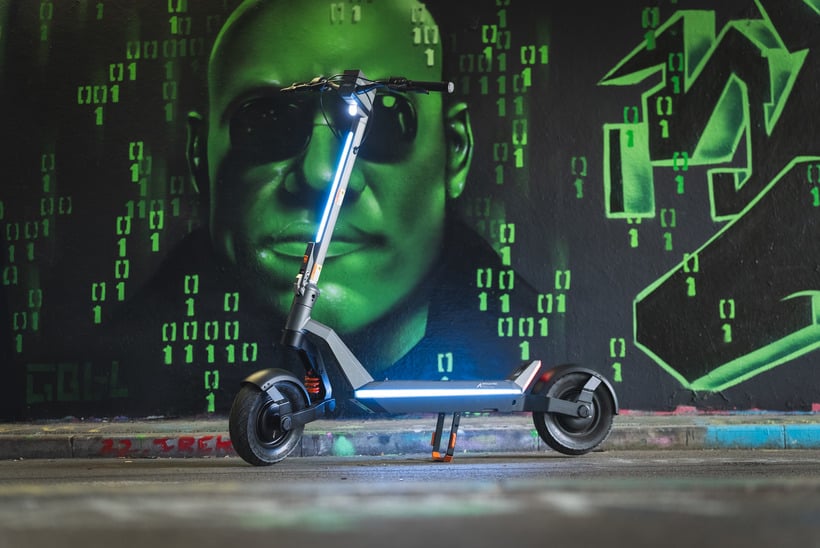
Apollo Pro
Performance Report
Performance Report:
Tester: Josh Frisby (190 lbs, 6.1 ft)
- Top Speed: 44 mph
- Real Speed: 44 mph*
- 0-15 mph: 2.1 s*
- 0-25 mph: 4.3 s*
- 0-30 mph: 6.3 s*
- 0-35 mph: 9.3 s*
- Max Range: 63 miles
- Real Range: 39 miles*
- Braking: 2.3 meters*
- Suspension: 7/10*
- Max Incline: 30 degrees
- Optimal Incline: 18 degrees*
- Weight: 93 lbs
- Load: 330 lbs
Pros & Cons
The Good:
- Red Dot Design Award winner
- Industry-leading build quality
- Looks like a Tesla Cybertruck
- Futuristic 360-degree dynamic lighting rig
- Competitive speed, acceleration, range, and braking performance
- AG geometry promises intuitive control and best-in-class handling
- Integrated IoT gives you access to 24/7 GPS tracking so you can flag your scooter lost or stolen and activate its kill switch
- Regen brakes recharge your battery up to 10%
- DOT Matrix display is extremely bright and easy to read from any angle
- QuadLock phone mount supports wireless charging and allows you to use the app on your phone as the primary display
- Mobile app lets you customize performance settings
- Built-in Bluetooth speaker
- 12-inch self-healing tires
- Well suited to tall and heavy riders
- Low-maintenance
- IP66 water-resistance rating
The Bad:
- Some scooters within its price class go faster and further. But, none can compete with the Pro’s integration of tech, unique features, and reliable, low-maintenance build
- Suspension system could be more plush
Video Review
Best Extreme Speed
Performance Report
Performance Report:
Tester: Josh Frisby (197 lbs, 6.1 ft)
- Top Speed: 65 mph
- Real Speed: 65.8 mph**
- 0-15 mph: 1.6 s*
- 0-25 mph: 2.8 s*
- 0-30 mph: 3.4 s*
- 0-35 mph: 4.2 s*
- 0-40 mph: 5.2 s*
- Max Range: 112 miles
- Real Range: 42.8 miles*
- Braking: 3.0 meters*
- Suspension: 8.5/10*
- Max Incline: 50 degrees
- Optimal Incline: 30 degrees*
- Weight: 137 lbs
- Load: 330 lbs
*Based on my tests and assessments
**Based on third-party tests
Pros & Cons
The Good:
- Fastest scooter on the market
- Acceleration is the quickest that I’ve ever tested
- Powerful 2-in-1 100A Sine Wave controller (peaks at 160A)
- Has traction control
- A well-balanced frame, reliable dual stem, and ultra-wide handlebars make it extremely stable when ripping top speeds
- Zoom hydraulic brake calipers and thick rotors ensure responsive stopping power
- Shock absorption of the GTR is far better than the original GT thanks to the new adjustable hydraulic shocks
- Versatile self-healing tires
- Long real-world range
- Removable battery makes charging easy
- Best hill climber that I’ve tested
- Huge deck and extended kickplate allow for plenty of room
- The most ground clearance of any scooter
- Ideal for heavy riders
- Bright and easy-to-read TFT display
- Super bright dual headlights and deck-embedded LEDs
- Turn signals are visible from all angles
- IPX5 water resistance rating
The Bad:
- Extremely heavy
- The folding mechanism is clunky and the most difficult to use out of all of the scooters that I’ve tested
- While the removable battery is a useful feature, the connector is a little difficult to attach and detach due to a lack of space
- The smoked taillight is hard to see in daylight, and it doesn't flash when you brake (instead, it glows brighter)
Video Review
Compare Best Electric Scooters
VMAX VX5 Pro LT | VMAX VX5 Pro | VMAX VX2 Pro | SPLACH Mukuta | VMAX VX4 | Apollo Go | Apollo City Pro | Mantis King GT | Apollo Phantom | RoadRunner Pro | Apollo Pro | Wolf King GTR |
|
|---|---|---|---|---|---|---|---|---|---|---|---|---|
| Where to Buy | VMAX | VMAX | VMAX | SPLACH | VMAX | Apollo | Apollo | Kaabo | Apollo | Voro Motors | Apollo | Kaabo |
| Price | $449 | $549 | $999 | $999 | $1,449 | $1,099 | $1,299 | $1,899 | $2,199 | $2,695 | $2,449 | $3,499 |
| Award | Best Low Budget | Best Overall Budget | Best Under $1,000 | Best Solid Tire & Low Maintenace | Best Long-Range & Heavy Rider | Best Entry-Level Dual-Motor, All-Weather & Most Reliable | Best Dual-Motor Commuter | Best Off-Roader | Best Road Racer | Best Seated | Best Tech Integration | Best Extreme Speed |
| Review | Review | Review | Review | Review | Review | Review | Review | Review | Review | Review | Review | Review |
| Performance | ||||||||||||
| Top Speed | 18 mph | 18 mph | 24 mph | 28 mph | 25 mph | 28 mph | 32 mph | 43 mph | 41 mph | 50 mph | 44 mph | 65 mph |
| 0-15 MPH | 6.7 s | 6.7 s | 3.8 s | 2.7 s | 3.2 s | 3.8 s | 2.3 s | 1.9 s | 2.3 s | 2.6 s | 2.1 s | 1.6 s |
| 0-25 MPH | n/a | n/a | n/a | 6.7 s | 9.6 s | No data | 6.1 s | 4.0 s | 4.5 s | 4.3 s | 4.3 s | 2.8 s |
| Max Range | 11 miles | 22 miles | 37 miles | 39 miles | 62 miles | 30 miles | 43 miles | 56 miles | 40 miles | 50 miles | 63 miles | 112 miles |
| Tested Range | 9.2 miles | 19 miles | 30.6 miles | 22 miles | 36.7 miles | 17.6 miles | 27 miles | 38 miles | 29 miles | 34 miles | 39 miles | 42.8 miles |
| Braking | 2.0 meters | 2.0 meters | 3.0 meters | 2.1 meters | 3.4 meters | 3.1 meters | 2.1 meters | 2.1 meters | 2.1 meters | 3.0 meters | 2.3 meters | 3.0 meters |
| Shock Absorp. | n/a | n/a | n/a | 6.5/10 | 6.5/10 | 6/10 | 7.5/10 | 9/10 | 7.5/10 | 8/10 | 7/10 | 8.5/10 |
| Max Incline | 14 degrees | 14 degrees | 15 degrees | 22 degrees | 18 degrees | 25 degrees | 20 degrees | 30 degrees | 25 degrees | 30 degrees | 30 degrees | 50 degrees |
| Optimal Incline | 8 degrees | 8 degrees | 9 degrees | 13 degrees | 11 degrees | 12 degrees | 13 degrees | 18 degrees | 15 degrees | 18 degrees | 18 degrees | 30 degrees |
| Specs | ||||||||||||
| Motor | 36V 400W | 36V 400W | 48V 500W | 48V 600W (x2) | 48V 500W | 36V 350W (x2) | 48V 500W (x2) | 60V 1100W (x2) | 52V 1200W (x2) | 60V 2000W (x2) | 52V 1200W (x2) | 72V 2000W (x2) |
| Throttle | Thumb | Thumb | Thumb | Twist | Thumb | Thumb | Thumb | Thumb | Thumb | Twist | Thumb | Finger |
| Battery | 36V 7.8Ah FST | 36V 10.4Ah FST | 48V 16Ah FST | 48V 15.6Ah FST | 48V 23.2Ah FST | 36V 15Ah FST | 48V 20Ah FST | 60V 24Ah Samsung | 52V 23.4Ah FST | 60V 30Ah LG | 52V 30Ah Samsung | 72V 35Ah LG |
| Charge Time | 4 hours | 5 hours | 8.5 hours | 8 hours | 12 hours | 7.5 hours | 4.5 hours | 6 hours | 12 hours | 10 hours | 6 hours | 12 hours |
| Brakes | Drum, Regen | Drum, Regen | Drum, Regen | Discs (x2), Electronic | Drum, Regen | Drum, Regen | Drums (x2), Regen | Hydraulic Discs (x2), Electronic | Discs (x2), Electronic | Hydraulic Discs (x2), Electronic | Drums (x2), Regen | Hydraulic Discs (x2), Electronic |
| Suspension | None | None | None | Springs, Swingarms | Hydraulic Fork, Rubber Block, Swingarms | Spring, Rubber Block | Triple Springs, Swingarms | Adjust. Hydraulic Springs, Swingarms | Quad Springs, Swingarms | Hydraulic Forks, Springs | Adjust. Hydraulic Spring, Rubber Cartridge | Adjust. Hydraulic Fork, Adjust. Hydraulic Spring, Swingarms |
| Tire Size | 9 inch | 9 inch | 10 inch | 8 inch | 10 inch | 9 inch | 10 inch | 10 inch | 10 inch | 14 inch | 12 inch | 12 inch |
| Tire Type | Air (Tubeless) | Air (Tubeless) | Air (Tubeless) | Solid (Rubber) | Air (Tubeless) | Air (Tubeless, Self-Healing) | Air (Tubeless, Self-Healing) | Air (Inner-Tube) | Air (Inner-Tube) | Air (Tubeless) | Air (Tubeless, Self-Healing) | Air (Tubeless, Self-Healing) |
| Weight | 35.9 lbs | 36.8 lbs | 45 lbs | 66 lbs | 63.9 lbs | 46 lbs | 65 lbs | 79 lbs | 77 lbs | 114 lbs | 93 lbs | 137 lbs |
| Load | 265 lbs | 265 lbs | 287 lbs | 265 lbs | 330 lbs | 265 lbs | 265 lbs | 265 lbs | 300 lbs | 330 lbs | 330 lbs | 330 lbs |
| Foldability | Folds at Stem | Folds at Stem | Folds at Stem | Folds at Stem & Handlebars | Folds at Stem | Folds at Stem | Folds at Stem | Folds at Stem | Folds at Stem | None | Folds at Neck | Folds at Neck |
| IP Rating | IPX6 | IPX6 | IPX6 | IP54 | IPX6 | IP66 | IP66 | IPX5 | IP54 | None | IP66 | IPX5 |
| Lights | Headlight, Taillight | Headlight, Taillight, Turn Signals | Headlight, Taillight, Turn Signals | Headlight, Stem Strip, Deck LEDs, Taillights, Turn Signals | Headlight, Taillight, Turn Signals | Headlight, Taillight, Turn Signals | Headlight, Taillight, Turn Signals | Headlight, Taillight, Deck, Customizable RGB, Turn Signals | Headlight, Taillight, Turn Signals | Headlight, Taillight, Turn Signals | Headlight, Stem, Deck, Taillight, Turn Signals | Dual Headlights, Taillight, Deck, Turn Signals |
| Terrain | Street | Street | Street | Street | Street, Off-Road | Street | Street | Street, Off-Road | Street, Off-Road | Street | Street | Street, Off-Road |
How Did I Test the Scooters?
Test Criteria
To find the 12 best electric scooters, I tested 72 models. Each was evaluated across 7 performance categories (including top speed, acceleration, range, hill climbing, braking, shock absorption, and ride quality), as well as 10 design categories (including the cockpit, frame, deck, tires, portability, suitability, lights, extra features, dimensions, and build quality). I also assessed 2 post-purchase factors (including warranties and customer support).
Top Speed
Establishing the top speed of a scooter requires 2x two-way directional runs on a long dry, smooth, flat road.
Before testing, I ensure that each scooter’s battery is fully charged, the tires are inflated to their recommended PSI, and the performance settings are maxed out. Then, it’s all about putting the pedal to the metal.
Some scooters can reach extremely fast top speeds but, due to a lack of runway, I’m only able to conduct tests up to 40 mph. This is a common limitation experienced by reviewers; to counter it, I’m working on lab tests that’ll give a near-perfect indication of the true top speeds for scooters that exceed 40 mph. I’ll disclose more information once the test process has been finalized. In the meantime, I’ve referred to trusted third-party data where I was not able to collect it myself.
Acceleration
While top speed stats may attract more headlines, it’s a scooter’s acceleration that represents the truest measure of its thrill.
To glean accurate readings, I carry out tests across several intervals (i.e. 0-15 mph, 0-25 mph). Each interval is subject to 3x two-way sprints on a dry and flat road. To safeguard the efficacy of my tests, I check that zero-start mode is activated (if applicable), the tires are pumped up to the correct PSI, the battery is fully juiced, and the scooter’s performance settings are dialed up.
During these tests, I also assess wheel spin, the responsiveness of the throttle, and how the scooter handles (i.e. control and stability).
Range
When it comes to range, there are two metrics that you need to consider: maximum and real-world. The maximum range, as specified by the scooter’s manufacturer, refers to its potential mileage when ridden in optimal conditions. Such variables generally include flat terrain, slow speeds, and a 165 lb rider. While these figures are useful for comparing performance, they don’t paint the full picture.
As a result, I report on how each scooter performs under real-world conditions – including me as a 190 lb rider, periods of fast acceleration, cruising, and multiple stops.
I’ve also recently located a new 2.3-mile point-to-point range circuit (encompassing a 131 ft change in elevation). This will be used to put future models through their paces.
Hill Climbing
Though every electric scooter has a maximum incline rate, in practice I’ve found that optimal hill climbing performance typically hovers at around 60% of that figure.
But accuracy is important, so I’ve developed a new test that’ll measure the time and average speed required to traverse a stretch of road that measures 216 ft and features a 23 ft rise in elevation. This translates into an average incline rate of 6.08 degrees (or 10.65%).
Braking
Stopping distance is an important metric that you should pay attention to.
Here, I measure the distance that it takes for each scooter to come to a complete stop from 15 mph. This process is repeated five times, all while ensuring a controlled braking experience (i.e. no skidding).
If the scooter uses electronic or regenerative braking systems they are maxed out to their strongest setting.
Based on my hundreds of braking tests, stopping distances can be interpreted as follows: Excellent (less than 2.5 meters), Very Good (2.5 – 3.0 meters), Good (3.0 – 3.5 meters), Fair (3.5 – 4.0 meters), and Poor (more than 4.0 meters).
Shock Absorption
There’s an element of subjectivity involved when analyzing the shock absorption afforded by a scooter. However, after many years of testing, I’ve developed an acute understanding of how to score appropriately.
Riding on both flat and pot-holed roads (as well as dirt tracks and forest trails if it’s an off-roader), I assess the balance of shock absorption across the front and rear of the scooter, its rebound and compression rates, its adjustability (if possible), the amount of travel, and whether the suspension bottoms out. In addition to this, I report on the shock-absorbing profile of the tires.
Once the tests have been completed, I give each scooter a shock absorption rating out of 10, with 1 being extremely stiff and 10 extremely soft.
Ride Quality
Ride quality is the most important aspect of a scooter’s overall performance. Without it, everything else is essentially null and void.
My exhaustive testing on roads, dirt tracks, and forest paths (depending on the scooter) grants me ample opportunity to build a detailed understanding of how a model’s geometry and dimensions impact its stability and control. It also allows me to assess how a scooter responds to different inputs and performance settings while gauging the quality of its handling, power delivery, and agility.
Design Assessments
While a scooter’s performance stats will likely form the crux of your eventual purchasing decision, its design must always be factored in.
Each model that I review is subject to 30 assessments spanning 10 design categories. These include the cockpit, frame, deck, tires, portability, suitability, lights, extra features, dimensions, and build quality.

Learn More About How I Assess the Design & Features of Each Scooter
Post-Purchase Considerations
Post-Purchase Considerations:
Purchasing a scooter with great performance and design credentials is all well and good, but sometimes, life happens. Components can be faulty and errors can be made during the manufacturing process, for example.
With this in mind, I assess every scooter’s warranty to establish its duration, the parts it does and doesn’t cover, and any additional costs associated with the policy. I also detail the differences in warranties among brands/retailers to give an objective assessment of how they stack up against each other.

Taking this a step further, I detail the post-purchase support that brands offer. Here, I share the ways that you can contact them, and report on the resources available to you if you require assistance (i.e. knowledge hubs, help desks, access to service centers, and any lifetime commitments that entitle you to discounted repairs post-warranty).








